Your cart is currently empty!
Tag: Apply to Oxford University
-

October 2025 ESAT/TMUA Score Analysis: How Our Students Far Exceeded the Global Average
I. Introduction: The Official Data at a Glance
The release of the official scores for the October 2025 ESAT and TMUA naturally brings up a crucial question: “What score actually puts you in a competitive position?” The official worldwide score distribution charts, provided by UAT-UK, offer the definitive answer:
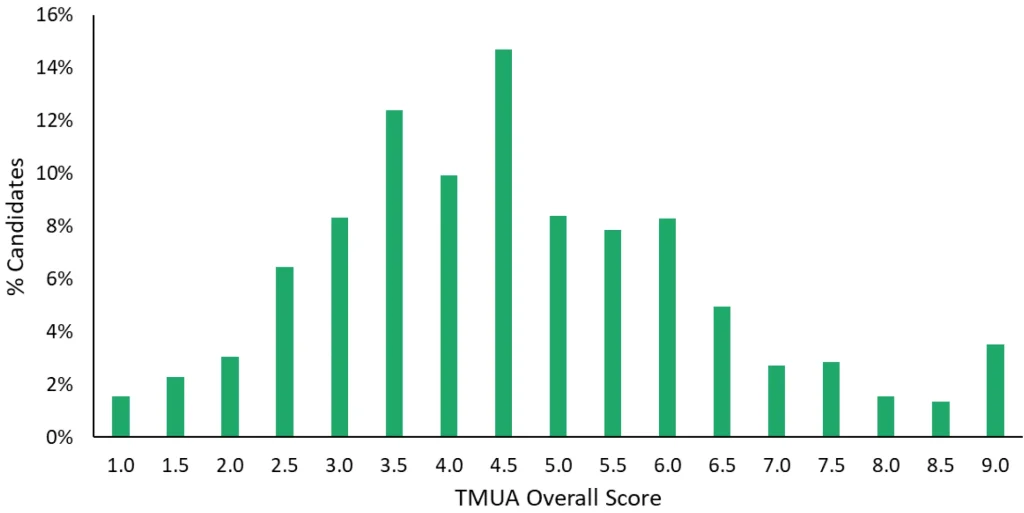
October 2025 TMUA Global Score Distribution
(UAT-UK Official Report Screenshot)
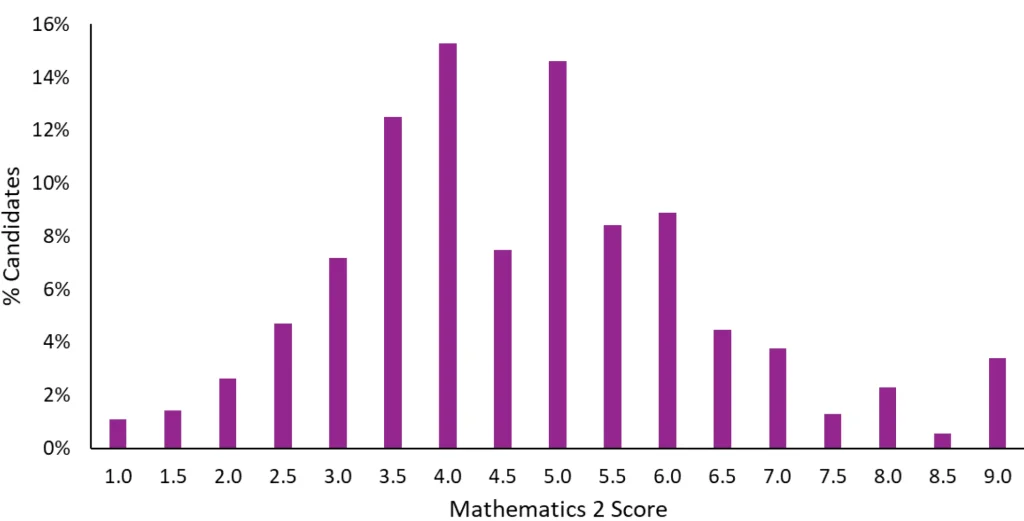
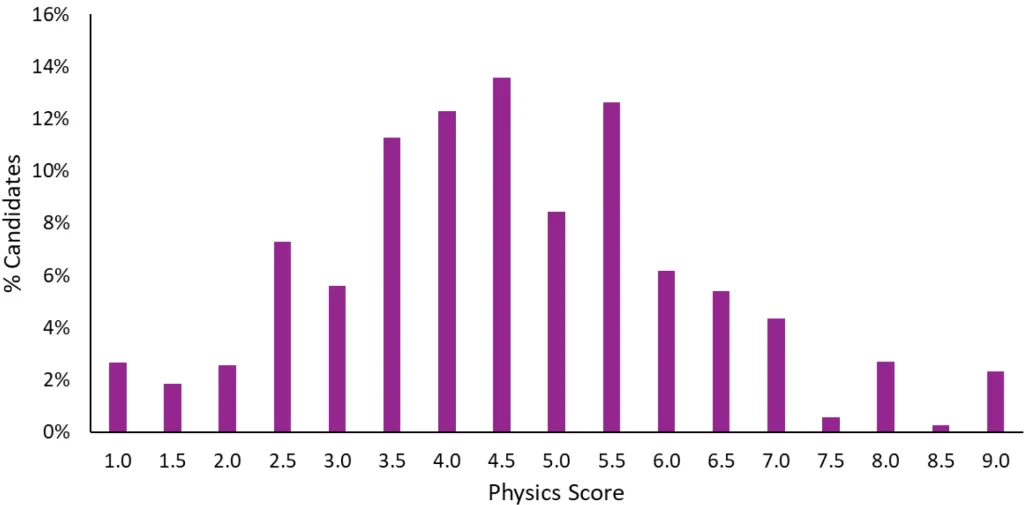


October 2025 ESAT Five Modules Global Score Distribution
(UAT-UK Official Report Screenshot)The official figures paint a clear picture: the scores follow a classic normal distribution, with the peak—the global median—sitting at 4.5. However, to be considered truly “outstanding,” one must aim significantly higher: A score of around 7.5 puts you in the top 10% worldwide. To reach the elite top 5%, a candidate needs to hit 8.0.
At UEIE, our ambition is not merely to help students find their place on this curve, but fundamentally to change its shape. This report directly compares the October 2025 official exam scores with the remarkable results achieved by UEIE students. The evidence is compelling, demonstrating unequivocally how our data-driven, structured preparation system empowers students to achieve the massive transformation from “just average” to “top-tier success”.
II. Data Comparison: How UEIE Students Reshape the Score Curve
Now, let’s look at the exceptional performance of UEIE students.
Metric UEIE Students Global Score Advantage Median 6.4 4.5 +1.9 Mean 6.5 4.7 +1.8 Standard Deviation 1.5 1.7 -0.2 The figures are estimates based on the officially released score distribution, as they were not officially published data.
The median and mean scores achieved by UEIE students are 1.8 to 1.9 points higher than the global figures. An advantage of nearly 2 points is far from a minor uplift; it represents a statistically significant “overall shift” in the score distribution.
The overall score distribution of our students, shown in the figure below, clearly substantiates this point:
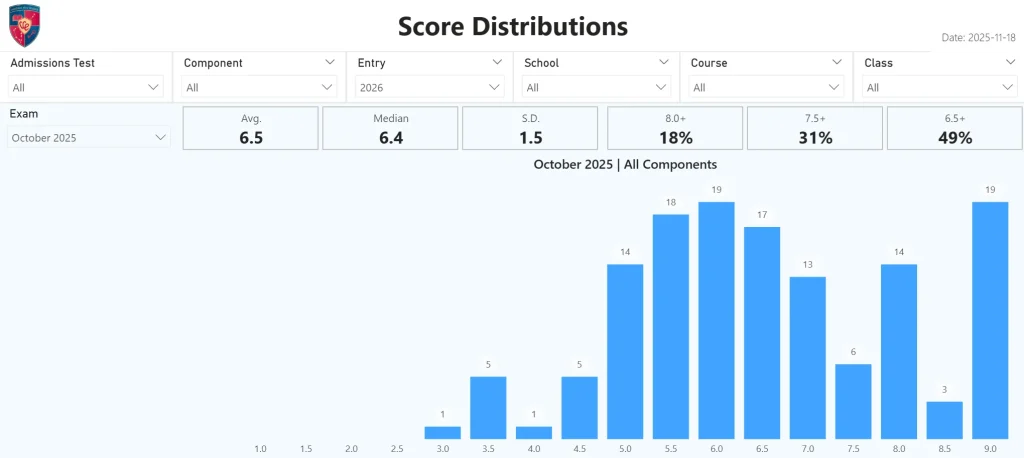
UEIE Student October 2025 ESAT/TMUA Score Distribution
(Median: 6.4, Mean: 6.5)This advantage becomes even more pronounced in the high-score brackets:
- The benchmark for the Global Top 10% is 7.5. Within UEIE, 31% of our students scored above 7.5. This means that almost one-third of our cohort has already achieved the standard of excellence set by the global top 10%.
- The threshold for the Global Top 5% is 8.0. Nearly one-fifth of UEIE students achieved a score of 8.0 or higher, putting them alongside the world’s most elite 5% of candidates.
How is this collective high standard achieved? It is certainly not a matter of chance. It is the inevitable outcome of a systematic, data-driven process.
III. From “Average” to “Excellence”: The Data-Driven Growth Pathway
Collective excellence is born from the precise tracking of individual development.
Our core methodology revolves around a data-driven, iterative closed loop: “Diagnosis – Exam – Feedback – Improvement”. The following three student reports offer a visual, intuitive demonstration of how this “Growth Trajectory Line” successfully converts potential into concrete scores.
Case Study 1: The Top-Tier Breakthrough from 7.1 to 9.0
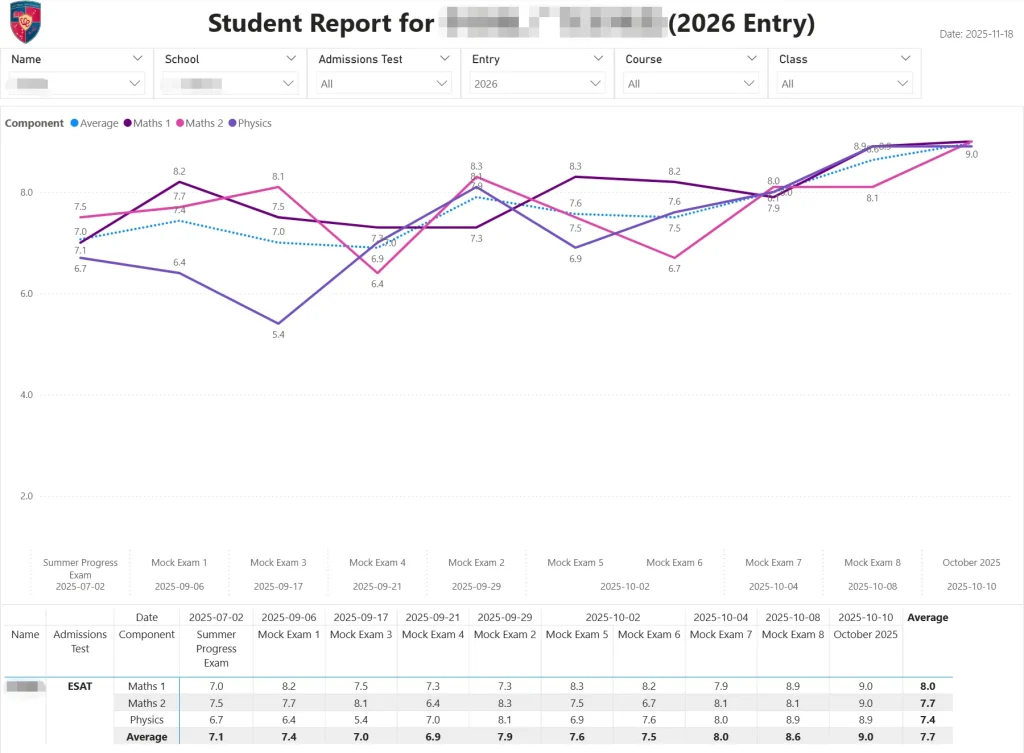
Case 1: Li (Engineering) – ESAT Preparation Trajectory
(From the start of the Summer Intensive Course in June 2025 until the Final Sprint Course)Li’s starting point was a strong 7.1, yet our aim was the absolute peak. The trajectory reveals that after experiencing score turbulence in the first five mock exams (ranging from 7.0 to 7.9), systematic feedback facilitated a rapid adjustment. Scores began to climb steadily from the sixth mock exam, leading us to project an average score of 8.0 or above. Ultimately, Li secured a phenomenal 9.0 average in the formal exam!
This proves that our preparation framework provides the crucial “final push,” enabling even the most outstanding students to break through their plateaus.
Case Study 2: Steady Ascent from 6.1 to 8.6
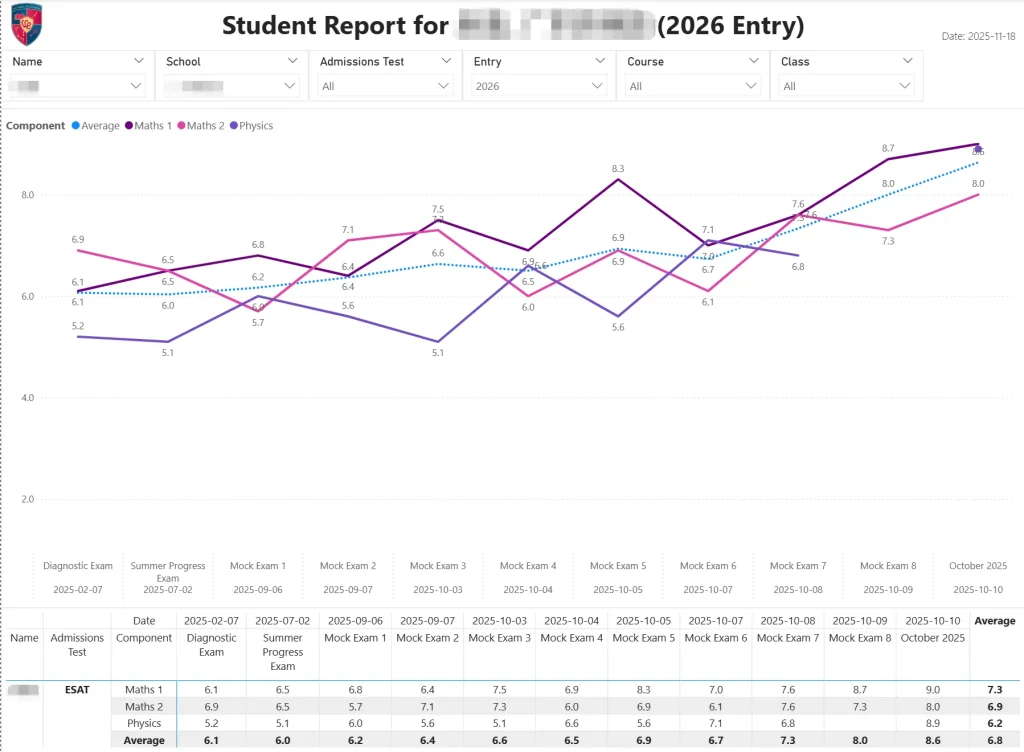
Case 2: Zhao (Engineering) – ESAT Preparation Trajectory
(From the start of the Oxbridge Core Mathematical Thinking Course in February 2025 until the Final Sprint Course)This case is a classic example of “data-driven, steady improvement”. Zhao’s starting score was 6.1 (Diagnostic Exam), which still left a significant gap to the Global Top 5% (8.0). Although her actual performance in the classroom was at an “excellent” standard, her exam preparation process was challenging, with initial mock exam averages stuck in the 6-point range. Data feedback helped her swiftly identify the issues and led to a powerful rebound, with scores rapidly increasing in the final mock exams. This process built substantial confidence before the final exam. She ultimately finished the exam with a high score of 8.6, placing her among the Global Top 2%!
This demonstrates that our system can successfully convert a challenging “slump” into a powerful “springboard,” ensuring reliable and continuous progress.
Case Study 3: TMUA for Economics, Securing 7.6

Case 3: Yu (Economics) – TMUA Preparation Trajectory
(From the start of the Intensive Course in September 2025 until the Final Sprint Course)Yu started with a high level, scoring 6.9 in September. However, for a Cambridge Economics applicant, this level does not confer a significant advantage. Our brief was to help him achieve a score of 7.5 or above in less than a month of preparation, while ensuring that this performance was stable in the real exam.
The score trajectory shows that across all eight mock exams, his average score improved gradually with only minor fluctuations. The mean of his last three mock exam scores was already around 8.0. His final exam score of 7.6 exceeded over 90% of global TMUA candidates. Crucially, this score secured his place in the top tier of applicants for Cambridge Economics, laying a firm foundation for receiving a Cambridge offer.
These score curves are more than just numbers; they are the visual proof of the “process”. They confirm that systematic planning alongside data-driven feedback is the absolute best path for achieving a significant leap in performance.
IV. Conclusion: Insights Beyond the Data
With the data analysed, the conclusion is self-evident.
The official 2025 figures clearly show that the peak of the global ESAT/TMUA “bell curve” is firmly anchored at 4.5 points. However, UEIE students achieved an average score of 6.5, marking a colossal leap of nearly 2 points. Furthermore, 31% of our cohort reached the standard of excellence set by the global top 10%. This overwhelming advantage is not the random accumulation of individual talent, but the inevitable product of systematic engineering.
The growth trajectories of our student cases (such as Li, Zhao, and Yu) have proven that the massive leaps—from 6.1 to 8.6, or from 7.1 to 9.0—are underpinned by a multi-month, iterative closed loop consisting of “Diagnosis – Exam – Feedback – Improvement”. This data-driven system is precisely the core engine that transforms “average” performance into “excellence”.
For candidates and parents currently planning for the 2027 application cycle, this data report provides a clear signal: There is no shortcut to securing a place at a top university. Truly outstanding results are the necessary outcome of scientific planning, systematic training, and professional, data-informed feedback.

TMUA Prep Hub
Master the TMUA with UEIE’s Prep Hub! We offer everything you need to succeed: in-depth video lecture series, extensive practice question bank, realistic full-length mock exams, expert guides, and insightful data analysis.
ESAT Prep Hub
Master the ESAT with UEIE’s Prep Hub! We offer everything you need to succeed: in-depth video lecture series, extensive practice question bank, realistic full-length mock exams, expert guides, and insightful data analysis. -

ESAT & TMUA Sprint Playbook
In early September 2025, with just one month remaining until key admissions exams like the ESAT and TMUA, we conducted our third stage of benchmark exams. This serves not only as an assessment of past efforts but also as our most valuable strategic roadmap for the final push.
This report provides an in-depth analysis of the exam data, helping you to clearly see your progress, pinpoint areas for improvement, and formulate the most effective preparation strategy for the final thirty days. Remember, every moment of reflection now is an investment in a successful outcome.
I. About the Exams
1. Exam Details
Program Stage 1:
Diagnostic ExamStage 2:
Summer Progress ExamStage 3:
Benchmark ExamExam Type ESAT & TMUA Question Source Original Mock Exams Exam Format Time-limited Online Exam Exam Difficulty ★★★★ ★★★☆ ★★★★ Exam Dates Feb-Jun, 2025 Jul-Aug, 2025 Early Sep, 2025 Exam Scope Open to the public globally*
Internal Exam
Internal Exam
No. of Participants 150+ 50-60 60-70 * The exam was open to participants of all nationalities and ages, with the majority coming from over 30 countries and regions, including mainland China, the UK, India, and Hong Kong.
** The difficulty level was benchmarked against the October 2024 ESAT and TMUA examinations: ★★★
2. Exam Papers and Score Conversion
To ensure fairness and validity, all exams used highly realistic, custom-written questions, with no past paper content. The time limits were identical to the actual exams, and the computer-based exam interface replicates the official platform with over 99% accuracy.
Links to all exam papers and their score conversion tables can be found below. Please note that access to most papers, excluding the diagnostic exam, requires authorisation.
Exam Stage Exam Papers (and Links) Score Conversion Table Conversion Table Version Used Diagnostic Exam TMUA Diagnostic Exam Paper 1
Paper 22025.06.30 ESAT Diagnostic Exam Maths 1
Maths 2
Physics
Chemistry
BiologySummer Progress Exam TMUA Summer Progress Exam Paper 1
Paper 22025.08.30 ESAT Summer Progress Exam Maths 1
Maths 2
Physics
Chemistry
BiologyBenchmark Exam TMUA Mock Exam 1 Paper 1
Paper 22025.09.08 ESAT Mock Exam 1
3. Explanation of the Score Conversion Table
To ensure that a student’s score accurately reflects their relative standing among global candidates, UEIE academic team applies its deep professional experience and a unique algorithmic model to conduct a curve-fitting analysis of the exam data. This process generates a unique score conversion curve for each exam paper, from which the corresponding score conversion table is derived.
Please note that as we continuously acquire new performance data, the conversion curve for each exam is dynamically optimised. Consequently, minor differences may be observed in tables viewed at different times.
Furthermore, although the difficulty level varies between exams, our conversion model has minimised the impact of this variable on the final score to a negligible level.
4. A Brief Guide to the Reported Score
The percentage score is converted into a Reported Score on a scale of 1.0 to 9.0, with 9.0 being the maximum mark.
The number of correct answers needed for a certain score varies by paper and is detailed in each conversion table.
The table below shows the general correlation between Reported Scores and global candidate rankings.
Reported Score Approximate Global Ranking 8.5 Top 3% 8.0 Top 5% 7.5 Top 10% 7.0 Top 15% 6.5 Top 20% 6.0 Top 25% 5.0 Top 50% (The data in the table represents the personal opinion of Xie Tao.)
II. Performance Data and Statistics
To simplify this analysis, the Reported Scores for students across the ESAT and TMUA exams have been combined.
- For TMUA, the average of the two papers is used.
- For ESAT, the average of the three sections is used.
- The average Reported Scores of all students from each exam onstitute the raw data.
1. Performance Trend Over Time
Metric Diagnostic Exam Summer Progress Exam Benchmark Exam Mean Score 5.37 6.37 6.78 Median 5.4 6.4 6.9 Standard Deviation 1.51 0.97 0.89 2. Performance Histograms from Each Exam Stage

Diagnostic Exam Scores
(February – June 2025)
Summer Exam Scores
(July – August 2025)
Benchmark Exam Scores
(Early September 2025)III. Our Progress: Growth Demonstrated by Data
Comparing the data across the three exam stages reveals encouraging signs of progress:
- Significant improvement in overall performance: Both the mean and median scores show a steady upward trend, with the mean score rising from 5.37 to 6.78. This proves the effectiveness of the systematic revision and training from the first two stages.
- The performance gap is narrowing: A steady decrease in the standard deviation (from 1.51 to 0.89) shows that the gap between students is closing. Higher-performing students are consolidating their strengths, while others are working hard to catch up, creating a positive and competitive atmosphere.
IV. Priorities for the Home Straight: Eight Key Areas to Conquer
While this improvement is commendable, we must address the common challenges revealed in this exam. Think of these not as “problems,” but as your clearest opportunities to boost your score.
- Knowledge Retention: Forgetting recently learned topics, particularly in TMUA Paper 2 and the ESAT science sections.
- Conceptual Ambiguity: Imprecise understanding of fundamental concepts and definitions, leading to lost marks on “trick” questions.
- Calculator Dependency: Reduced speed and proficiency in manual calculation due to long-term reliance on calculators.
- Reading Speed Bottlenecks: Slow processing of technical English and long questions, which impacts problem-solving efficiency.
- Sub-optimal Strategies: Using conventional methods to solve problems when faster, more elegant techniques would save valuable time.
- Reduced Practice Time: Summer activities and personal statements have squeezed practice time, leaving students feeling out of touch.
- Stamina and Endurance: A noticeable decline in concentration and energy during longer exams (over 1.5 hours).
- Mindset and Focus Under Pressure: Performance being affected by technical issues, simple errors, or seeing an interim score update.
V. To Our Students: Execute Your Final Push Plan
To address these key areas, execute the following strategies with focus and precision over the final month:
Consolidate Knowledge (For points 1 & 2)
Action: Don’t just review your mistakes—dissect them. Group errors by topic for deeper reflection. Write out key definitions and formulae and place them where you’ll see them every day.
Practise Deliberately (For points 3 & 4)
Action: Take the “Calculator Detox” challenge. From now on, do all calculations with pen and paper. For reading, set a timer and practise reading technical texts or long-form questions every day to improve your speed.
Optimise Your Technique (For points 5 & 6)
Action: Time is your most valuable asset. Commit to a fixed practice schedule. When practising, don’t just aim for the right answer—strive for the “optimal solution.” Master the smart techniques taught in class.
Simulate Exam Conditions (For points 7 & 8)
Action: Physical and mental stamina are critical. Use the 7 upcoming mock exams as your training ground. Adhere strictly to official timings and conditions. Remember: the purpose of a mock is to expose weaknesses. Every setback now is designed to ensure a smooth performance on exam day.
VI. To Our Parents: Providing the Strongest Support
In this final sprint, your support is your child’s greatest asset. We sincerely recommend that you:
- Focus on reassurance, not scores: Mock scores are part of the process. Help your child focus on the “why” behind their results and the “how” of their improvement plan. Your trust is the cornerstone of their confidence.
- Manage the logistics: A consistent routine, nutritious meals, and a quiet study environment are the foundation of effective preparation.
- Provide emotional support: Pay attention to your child’s emotional state. When they feel anxious, listen more and lecture less. A walk or a relaxed chat can be more effective than any motivational speech.
- Work in partnership with us: Trust the school, the teachers, and your child. Maintain communication with us so that, together, we can help them succeed.
VII. Conclusion: Trust the Process, Embrace the Challenge
This final month is for consolidating knowledge, refining skills, and, crucially, mastering your mindset. We hope this analysis helps clarify the path ahead. Please trust that every ounce of effort you have put in has forged the strength you possess today.
-
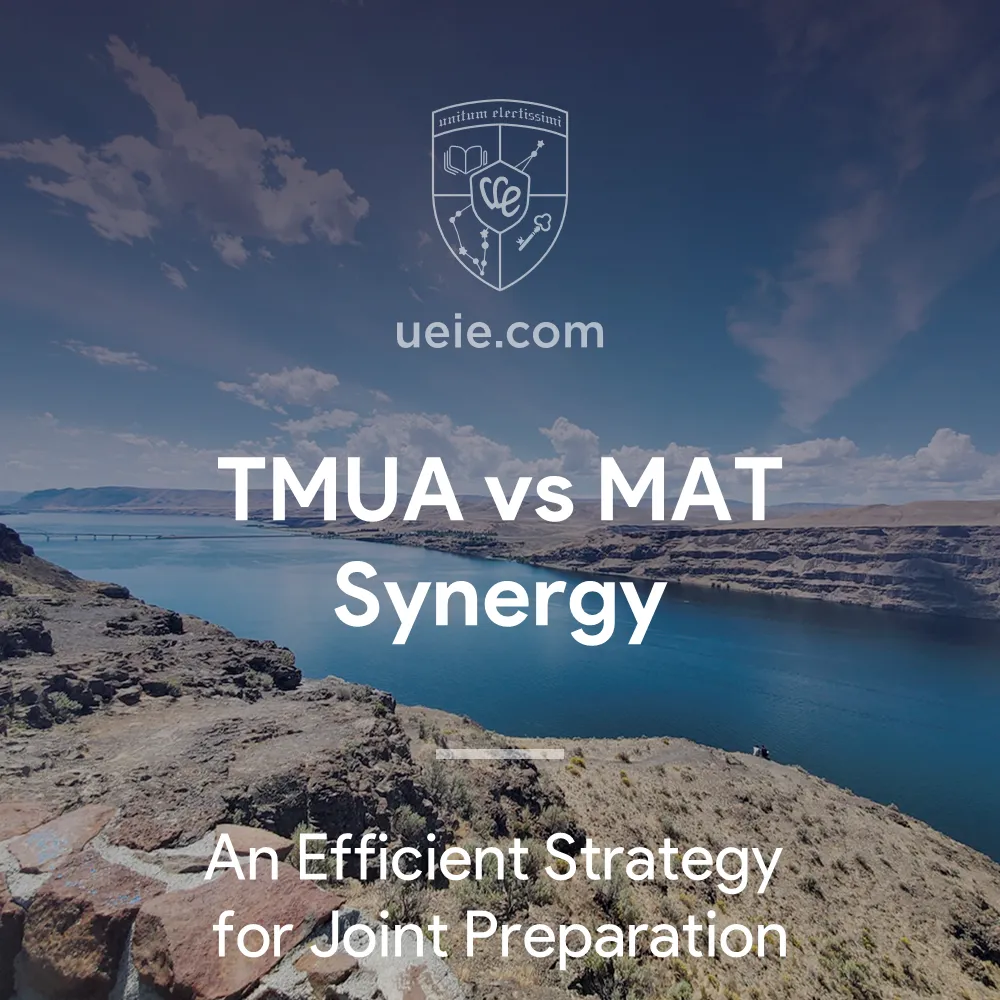
TMUA vs MAT Synergy: An Efficient Strategy for Joint Preparation
I. TMUA vs Oxford MAT: Why Are They So Often Mentioned Together?
Prospective students and parents targeting mathematics, computer science, economics, or other sought-after degree programmes at Oxbridge or other G5 universities will likely be familiar with the TMUA and the Oxford MAT (hereafter MAT) – two key mathematics admissions tests. Astute parents and students may have already spotted a crucial distinction: TMUA vs MAT — one examination (TMUA) is composed entirely of multiple-choice questions, while the other (MAT) features both multiple-choice and extended-response questions. These are fundamentally different examinations, so why are they often mentioned in the same breath, or even recommended for concurrent preparation? Could this approach dilute one’s focus?
This is an exceedingly common and pertinent query. This article aims to demystify the situation by directly comparing the TMUA and MAT, thereby revealing their ‘intrinsic connection’. I will explain why, for many students, preparing for these two examinations in tandem is, in fact, a more astute and efficient strategy – one capable of producing a synergistic effect greater than the sum of its parts (a ‘1+1>2’ outcome) – and will outline a clear and practical path to achieve this.
II. TMUA vs MAT: A Table for Understanding Core Similarities and Differences
First, let us consolidate the key information for the TMUA and MAT into a table, enabling you to discern their most crucial similarities and differences at a glance:
Dimension TMUA Oxford MAT Managing Body UAT-UK University of Oxford Exam Delivery Partner Pearson VUE Pearson VUE Response Format Online, computer-based Online, computer-based Question Types & Quantity 40 multiple-choice questions 25 multiple-choice questions + 2 extended-response questions Examination Duration 2.5 hours 2.5 hours Knowledge Base Primarily based on A Level Mathematics + some GCSE Mathematics Primarily based on A Level Mathematics Further Mathematics Not required Not required Examination Style Emphasis on speed and precision Emphasis on thinking and logic Assessed Abilities Rapid and accurate application of knowledge; logical reasoning agility. Rigorous logical thinking; creative problem-solving. Permitted Aids Calculators, formula sheets, and dictionaries are all prohibited. Calculators, formula sheets, and dictionaries are all prohibited. Scoring Method Standardised score: 1.0-9.0 (converted from raw score) Raw score: 0-100 Typical Universities / Majors - Cambridge (Computer Science, Economics) and compulsory for some Imperial/LSE/UCL programmes.
- Accepted or alternative for some Warwick/Durham programmes.
- Compulsory for Oxford Mathematics/Computer Science related programmes.
Keywords Speed, accuracy, logical reasoning, broad application Logic, problem-solving, mental flexibility, Oxford Brief Summary
Upon reviewing the table, you will observe that the TMUA and MAT do indeed exhibit distinct differences in question format (one being purely multiple-choice, the other a hybrid) and style (one prioritising speed, the other depth). However, their commonalities are also remarkably prominent: both are computer-based examinations, neither necessitates Further Mathematics, both are founded upon A Level core mathematics knowledge, and both place considerable emphasis on logical aptitude. These shared characteristics precisely form the basis upon which we can implement an effective joint preparation strategy.
III. ‘Combination’ and ‘Separation’: The Rationale and Key Aspects of TMUA MAT Joint Preparation
Having understood the core similarities and differences, you can now appreciate why the TMUA and MAT are suitable for ‘combined’ preparation, and yet necessitate ‘separate’ training in certain aspects.
1. Why ‘Combine’? – Unveiling the Intrinsic Connection
The feasibility and efficacy of joint preparation primarily stem from their close ‘intrinsic connection’.
A Highly Overlapping Knowledge System is Core
This is the most crucial point! Both the TMUA and MAT predominantly assess A Level Mathematics knowledge (mainly Pure Mathematics with a small amount of Statistics). Both are built upon core secondary school mathematics knowledge and neither requires the additional burden of studying Further Mathematics. This implies that when revising fundamental modules such as functions, algebra, calculus, and coordinate geometry, a single study pass can satisfy the majority of the knowledge requirements for both examinations, thereby avoiding substantial duplication of effort. This is the most significant efficiency gain!
Underlying Skills are Transferable
Whether it is the TMUA’s demand for rapid and accurate logical judgement or the MAT’s requirement for rigorous and in-depth logical analysis, a sound foundation in logical thinking is essential. Similarly, solid fundamental calculation skills, the ability to accurately express oneself using mathematical language, and basic problem deconstruction capabilities are vital for both examinations. Training these underlying skills can yield a ‘dual benefit from a single effort’.
Consistent Examination Environment
Both are computer-based examinations conducted at Pearson VUE test centres. Familiarity with the computer-based testing environment, on-screen reading, and online answering procedures is entirely transferable, reducing adaptation costs.
In simple terms, if we liken examination preparation to constructing a house, the foundational materials and load-bearing columns (core knowledge, underlying skills, examination environment) for the TMUA and Oxford MAT are largely identical. Tutors can construct them simultaneously, saving both time and effort.
2. Why ‘Separate’? – Unique Skills Require Dedicated Practice
Naturally, identical foundations do not equate to identical houses. The TMUA and MAT have different emphases regarding skill requirements; therefore, students must undertake specialised training separately.
TMUA is like a ‘Sprint’
It demands that students unleash their maximum problem-solving speed and accuracy within an extremely limited timeframe. Consequently, extensive timed multiple-choice question practice is imperative. Students must become proficient in various multiple-choice techniques (such as rapid elimination, substitution of special values, etc.) and develop time management into an ingrained habit. Merely possessing knowledge without the requisite techniques and speed will not suffice to achieve a high score in the TMUA.
MAT is like ‘Puzzle Solving and Questing’
It places greater emphasis on a student’s depth of thought and creativity when confronted with unfamiliar problems. Therefore, dedicated practice is needed in deconstructing novel problems, conducting in-depth logical analysis, and learning how to articulate problem-solving processes clearly via the keyboard (to address the extended-response questions). Practising only multiple-choice techniques will not adequately prepare one for the unique intellectual challenges posed by the MAT.
3. TMUA vs MAT: Brief Summary
The foundational elements of TMUA and MAT preparation can be tackled together, akin to building overall physical fitness; however, specific skills must be honed separately – a sprinter and a puzzle master will undoubtedly have different specialised training regimens.
IV. The Efficient Path: The ‘1+1>2’ Approach to Joint Preparation
Understanding the rationale behind ‘combination’ and ‘separation’ allows us to devise an efficient joint preparation path that truly achieves a ‘1+1>2’ effect.
1. Wherein Lie the Advantages of ‘1+1>2’?
The benefits of jointly preparing for the TMUA and MAT are tangible:
- Time-saving: This is the paramount advantage. Foundational knowledge need only be revised once, averting the repetitive investment of substantial time.
- Efficient: The enhancement of core abilities (such as logic and calculation) simultaneously benefits both examinations, creating a synergistic learning effect.
- Effort-saving: Familiarisation with the computer-based testing platform and procedures is only required once.
- Pragmatic: For students planning to apply simultaneously to Oxford and other top universities requiring the TMUA, this is the most natural and highly efficient strategy.
2. How to Achieve Efficient TMUA MAT Joint Preparation?
The key to efficient joint preparation lies in ‘strategy’:
Fundamental Path: Communalities First, Differences Later
- Step One (Laying the Foundation): Concentrate efforts on revising and consolidating the common A Level/AS core mathematics knowledge, ensuring conceptual clarity, formulaic proficiency, and computational accuracy. Concurrently, cultivate fundamental logical thinking skills.
- Step Two (Building the Framework, Dividing the Rooms): Once the foundation is solid, begin introducing targeted practice. On one hand, commence MAT-style in-depth thinking and problem-solving training; on the other, start TMUA-style timed practice to cultivate an initial sense of speed and multiple-choice question response capability.
- Step Three (Fine-Tuning): Enter the intensive phase, increasing the intensity of specialised training. Engage in extensive timed TMUA multiple-choice question practice, rigorously focusing on speed and accuracy. Simultaneously, concentrate on tackling past MAT papers and challenging problems to refine depth of thought and skills for answering short-answer questions.
Recommended Preparation Time
Generally, a systematic preparation period of 5-10 months is considered reasonable (the specific duration will vary depending on the student’s foundational knowledge). The crucial aspect is to commence early and ensure consistent, sustained effort.
Official Resources are Fundamental
Official materials (such as sample questions from the TMUA and MAT official websites, syllabuses, past papers, etc.) are fundamental and must be utilised effectively.
Considering the unique aspects of joint preparation, opting for specially designed joint preparation courses and materials tailored to the characteristics of both the TMUA and MAT will prove to be significantly more effective. For example, the TMUA+MAT On-Demand Prep Suite and the TMUA+MAT Live Classes offered by UEIE.
Key Recommended Resources
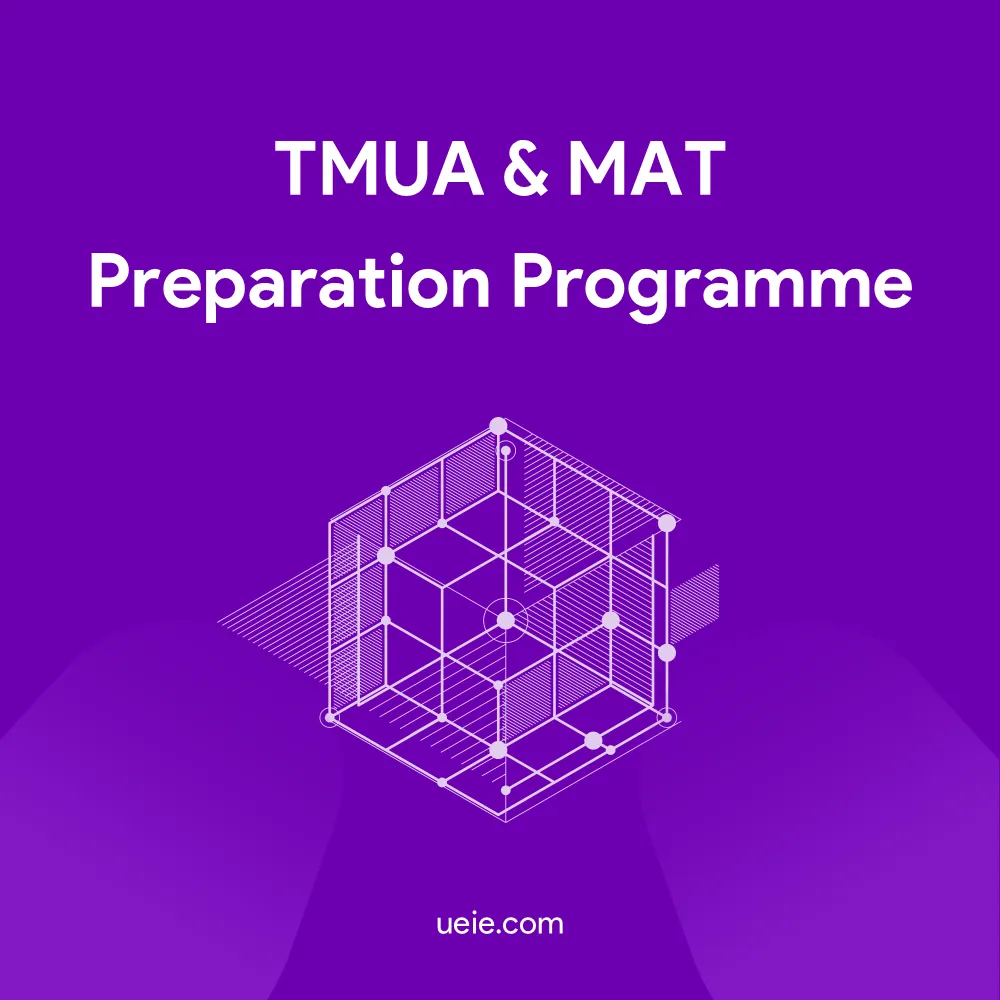
TMUA & MAT Preparation Programme
Prep for both and save time. This all-in-one programme provides 130 periods, 9 unseen TMUA mocks, 3 predictive papers, and 6 MAT mocks, helping you systematically master both exams. Click to view the bundle.US$3 832 – US$14 270Price range: US$3 832 through US$14 270

TMUA & MAT On-Demand Prep Suite
The TMUA & MAT On-Demand Prep Suite is your all-in-one solution for exam success. This comprehensive package combines Xie Tao’s expert video lectures, a massive bank of 1360 practice questions with detailed solutions, and 12 full-length mock exams that mirror the real test. Prepare thoroughly, build confidence, and achieve your target score.US$1 284 – US$1 856Price range: US$1 284 through US$1 856
The greatest value of such resources lies in their optimised design, which already incorporates the ‘combination’ and ‘separation’ learning paths and training content based on the similarities and differences between the two examinations. They can clearly guide students on what to learn first, what to practise subsequently, and how to practise most efficiently, thereby averting the potential waste of time and energy that might arise from students’ own trial-and-error efforts. For those pursuing highly efficient preparation, this is an exceedingly judicious choice.
3. Reassurance for Parents
Some parents may harbour concerns: Will preparing for both simultaneously result in neither being mastered thoroughly? On the contrary, a scientific approach to joint preparation is a more intelligent learning strategy. It does not merely amalgamate the content of the two examinations; rather, by integrating the common foundational components, it conserves precious time and energy, enabling the child to address the unique difficulties and skill requirements of each examination with greater composure and focus. This is a structured, efficiency-oriented method, the objective of which is to maximise the outcome of the preparation.
V. Conclusion: Bid Farewell to Indecision, Progress Efficiently
In summary, whilst the TMUA and MAT differ in their assessment styles and specific question types, their close ‘intrinsic connection’ in terms of knowledge base and core competency requirements makes joint preparation not only entirely feasible but, for many ambitious students, an intelligent path capable of genuinely enhancing efficiency and achieving a ‘1+1>2’ effect.
The key to success lies in employing appropriate methodology: fully leveraging their commonalities to efficiently establish a solid foundation, whilst also clearly recognising their differences and undertaking precise, specialised skills training.
It is hoped that the analysis herein will help to dispel any doubts and instil confidence in your forthcoming preparation planning. It is advisable to consider adopting structured, systematic joint preparation schemes and high-quality resources to ensure a smoother and more efficient preparation journey.
Want to learn more? Please see:

TMUA Prep Hub
Master the TMUA with UEIE’s Prep Hub! We offer everything you need to succeed: in-depth video lecture series, extensive practice question bank, realistic full-length mock exams, expert guides, and insightful data analysis.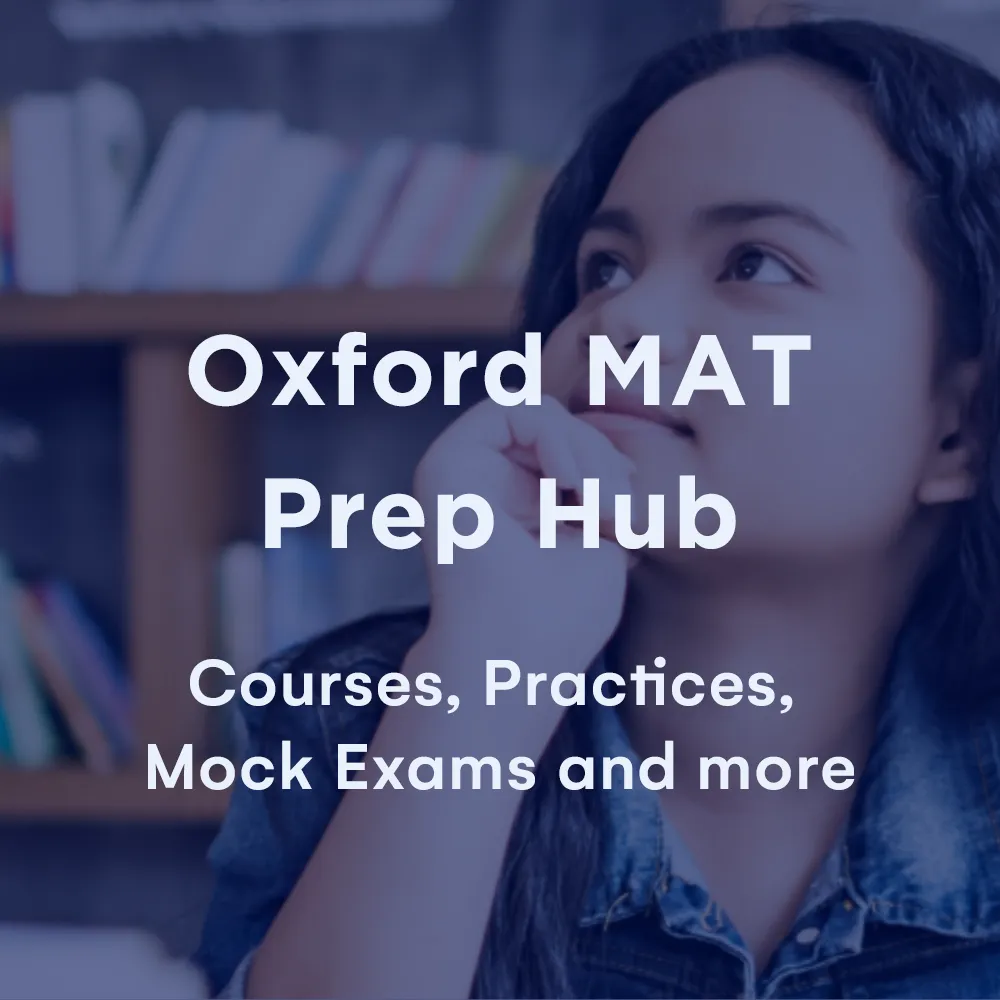
Oxford MAT Prep Hub
Master the Oxford MAT with UEIE’s Prep Hub! We offer everything you need to succeed: in-depth video lecture series, extensive practice question bank, realistic full-length mock exams, expert guides, and insightful data analysis. -

ESAT vs PAT Comparison: Strategies for Engineering & Science Test Prep
I. ESAT vs PAT: How to Choose Your Key to Top Science and Engineering Universities?
For students and parents preparing applications for engineering or science courses at Oxford, Cambridge, and Imperial College London, the names PAT (Oxford Physics Aptitude Test) and ESAT (Engineering and Science Admissions Test) will likely ring a bell. These are crucial ‘acid tests’ used by these top-tier institutions to select applicants for their science and engineering disciplines.
A common question naturally arises, particularly for those students and parents aiming for engineering or physics programmes at both Oxford and Cambridge/Imperial College: Given that both are science and engineering-related examinations, how significant are the differences between ESAT and PAT? If my child needs to prepare for both, is there an efficient way to combine their preparation? Or are they entirely distinct, requiring separate and independent study?
Admittedly, not all science applicants will need to tackle both examinations. For instance, those applying for courses in chemistry or biology-related fields (ESAT is required for Chemical Engineering and Biotechnology, biological streams of Natural Sciences, and Veterinary Medicine at Cambridge) or materials science (PAT is required for Oxford) typically only need to prepare for one.
This article will delve into the core similarities and differences between the ESAT and PAT examinations. Our aim is to clarify the landscape for all students and parents interested in ESAT and PAT. Specifically for those needing to prepare for both – students applying for engineering or physics – we will focus on analysing the ‘correlation’ and ‘differences’ in their preparation, offering an effective combined strategy. For students who only need to take one examination, this comparison will also provide a deeper understanding of the unique aspects of the exam they face, thereby enabling more targeted preparation.
II. ESAT vs PAT: A Table for Understanding Core Information
First, let’s condense the key information about ESAT and PAT into a table. This will allow you to quickly grasp their overall structure and core differences.
Dimension ESAT Oxford PAT Managing Body UAT-UK University of Oxford Exam Administrator Pearson VUE Pearson VUE Answering Format Online computer-based Online computer-based Paper Structure Total of 5 modules, typically choose 3:
-
- Mathematics 1
- Mathematics 2
- Physics
- Chemistry
- Biology
Unified paper: Mathematics + Physics Question Types and Volume 81 multiple-choice questions (3 modules, 27 questions/module) 40 multiple-choice questions Examination Duration 2 hours in total (3 modules, 40 minutes/module) 2 hours Knowledge Base A Level + GCSE Mathematics / Physics / Chemistry / Biology (depending on selected modules) A Level + GCSE Mathematics + Physics Further Mathematics Not required Not required Scoring Method Standardised score: 1.0-9.0 (after raw score conversion) Raw score: 0-100 Calculator Not permitted Online calculator provided (personal calculators forbidden) Dictionary and Formula Sheet Not permitted Not permitted Required by University/Department - Cambridge: Engineering, Natural Sciences, Chemical Engineering and Biotechnology, Veterinary Medicine
- Imperial College London: Department of Aeronautics, Department of Chemical Engineering, Department of Civil and Environmental Engineering, Dyson School of Design Engineering, Department of Electrical and Electronic Engineering, Department of Mechanical1 Engineering, Department of Physics
- UCL: Electronic and Electrical Engineering
- Oxford: Physics, Physics and Philosophy, Engineering, Materials Science
Summary
As the table above illustrates, both ESAT and PAT are online, multiple-choice examinations administered by Pearson VUE, aimed at applicants for top university science and engineering courses, and neither requires knowledge of Further Mathematics. However, they differ in the breadth of subjects covered (ESAT is broader), whether they are modular (ESAT is), calculator policies, and the final presentation of scores (standardised score vs. raw score).
III. Analysis of Similarities and Differences: Feasibility and Key Points for Combined Preparation
Having grasped the core information, let’s now delve into the feasibility of preparing for ESAT and PAT concurrently, highlighting key areas that demand particular attention.
1. Where does the ‘Feasibility’ of Combined Preparation Lie?
For students aiming to tackle both examinations (specifically those selecting the Mathematics 2 + Physics modules for ESAT), a combined preparation strategy is indeed feasible. This is primarily due to the following commonalities:
Overlapping Mathematical and Physics Knowledge
The content required for ESAT’s Mathematics 1, Mathematics 2, and Physics modules significantly overlaps with the A-Level/GCSE Mathematics and Physics knowledge needed for PAT. This means that when revising core topics such as functions, mechanics, electricity, and basic calculus, you can effectively ‘kill two birds with one stone.’
Shared Skillset
Both examinations place considerable emphasis on a student’s logical-mathematical reasoning, their ability to apply scientific principles to solve practical problems, and their capacity to maintain clear thinking and accuracy under pressure. Honing these core scientific literacies will benefit performance in both tests.
Similar Format
Both are online multiple-choice examinations administered via the Pearson VUE platform. Familiarity with the computer-based testing environment, on-screen reading, and multiple-choice answering techniques is transferable between the two.
2. What are the ‘Points to Note’ for Combined Preparation?
Despite these commonalities, it’s crucial not to treat ESAT and PAT as interchangeable. You must clearly recognise and specifically address the following key distinctions:
ESAT’s Modularity and Breadth
ESAT is structured into five modules: Mathematics, Physics, Chemistry, and Biology. Students must select and prepare for three of these, guided by their university application requirements. This implies a potentially broader knowledge base (particularly if Chemistry or Biology is chosen). Furthermore, during the exam, students will need to swiftly switch between different subject mindsets and manage their time effectively within the independent 40-minute slots allocated to each module.
PAT’s Integration of Physics and Mathematics, and Depth
While PAT only tests Physics and Mathematics, it strongly emphasises their deep integration in problem-solving. Questions may be more comprehensively and ingeniously designed, potentially demanding a more profound understanding of physical concepts and a more versatile application of mathematical tools.
Fundamental Difference in Calculator Policy
This is a critical distinction requiring careful attention:
- ESAT does not permit calculator use. Preparation must therefore involve significant effort in training mental arithmetic, manual calculation, estimation, unit conversion, and the fluent recall of formulae and constants.
- PAT, conversely, provides an online calculator. During preparation, students cannot rely on their familiar personal calculators. Instead, they must invest time in becoming proficient with the specific online tool provided. This includes learning to judge when to use it for complex calculations and when manual calculation or estimation might be more efficient. The training for these two distinct calculation approaches and skillsets is fundamentally different.
Differing Emphasis on Speed
ESAT allocates 40 minutes for 27 questions per module, averaging roughly 1.5 minutes per question. This demands exceptionally rapid knowledge retrieval and reaction speed. PAT, while also multiple-choice and with a total duration of 2 hours for 40 questions (averaging about 3 minutes per question), might appear slightly more relaxed. However, its questions may require more time for thorough reading, comprehension, modelling, and calculation (especially when using the online calculator). Consequently, it places equally high demands on depth of thought and problem-solving efficiency.
IV. Effective Strategy: Devising Your ESAT and PAT Preparation Plan
Having clarified the similarities and differences, we can now formulate an effective preparation strategy, particularly for students requiring combined preparation.
1. From Where Does ‘Effectiveness’ Originate? When is it Applicable?
The ‘effectiveness’ of combined preparation primarily stems from integrating common foundations. It is especially applicable to students whose application pathways cover related courses at Oxford and Cambridge/Imperial College, and who select the Mathematics and Physics modules for ESAT. Consolidating the revision of core mathematical and physical knowledge can effectively save time. However, please remember that the realisation of this efficiency must be predicated on precise, differentiated training.
2. Practical Advice: How to Approach Combined Preparation?
Step One: Confirm Modules and Self-Assess
Firstly, confirm that your chosen course requires or allows the selection of ESAT’s Mathematics 2 and Physics modules! This is the prerequisite for combined preparation. Secondly, objectively assess your proficiency in Mathematics, Physics (and other ESAT elective subjects), and your abilities both with and without calculator assistance.
Step Two: Consolidate Common Foundations
Systematically revise and consolidate the overlapping A Level Mathematics and Physics core knowledge points. Focus on conceptual understanding and mastery of fundamental principles.
Step Three: Differentiated Specialist Training
ESAT Specialist Training
- Undertake rigorous, high-intensity timed multiple-choice practice without a calculator. Focus on training speed, accuracy, and rapid knowledge retrieval skills.
- Practise adapting to module switching to simulate continuous examination conditions.
PAT Specialist Training
- Frequently use the official online practice platform to master the functions and limitations of the online calculator, and to identify the most efficient usage strategies.
- Engage in targeted practice of multiple-choice questions that integrate Physics and Mathematics and demand depth of thought.
- Critically use PAT past papers (note formatting differences prior to 2024), focusing on learning question approaches and the application of physical models.
Step Four: Simulate and Adjust
Periodically undertake full online mock examinations for ESAT (according to module combinations) and PAT, strictly adhering to time and calculator rules.
Based on mock examination results, analyse areas of weakness and promptly adjust revision priorities and training strategies.
Recommended Preparation Time
Considering the breadth of knowledge involved and the training of two different skill sets (particularly regarding calculators), it is advisable to allocate at least 5 months for systematic preparation. It is crucial to start early and ensure consistent, sustained effort.
Official Resources are Fundamental
The official ESAT and PAT websites, syllabuses, sample questions, and online practice platforms are fundamental resources that must be fully utilised.
Platforms such as Isaac Physics are beneficial for enhancing general mathematical and physical abilities.
Considering the unique nature of combined preparation, selecting courses and materials specifically designed for the characteristics of both ESAT and PAT will be significantly more effective. For example, the ESAT + PAT On-Demand Prep Suite and ESAT + PAT Live Classes offered by UEIE.
Key Recommended Resources
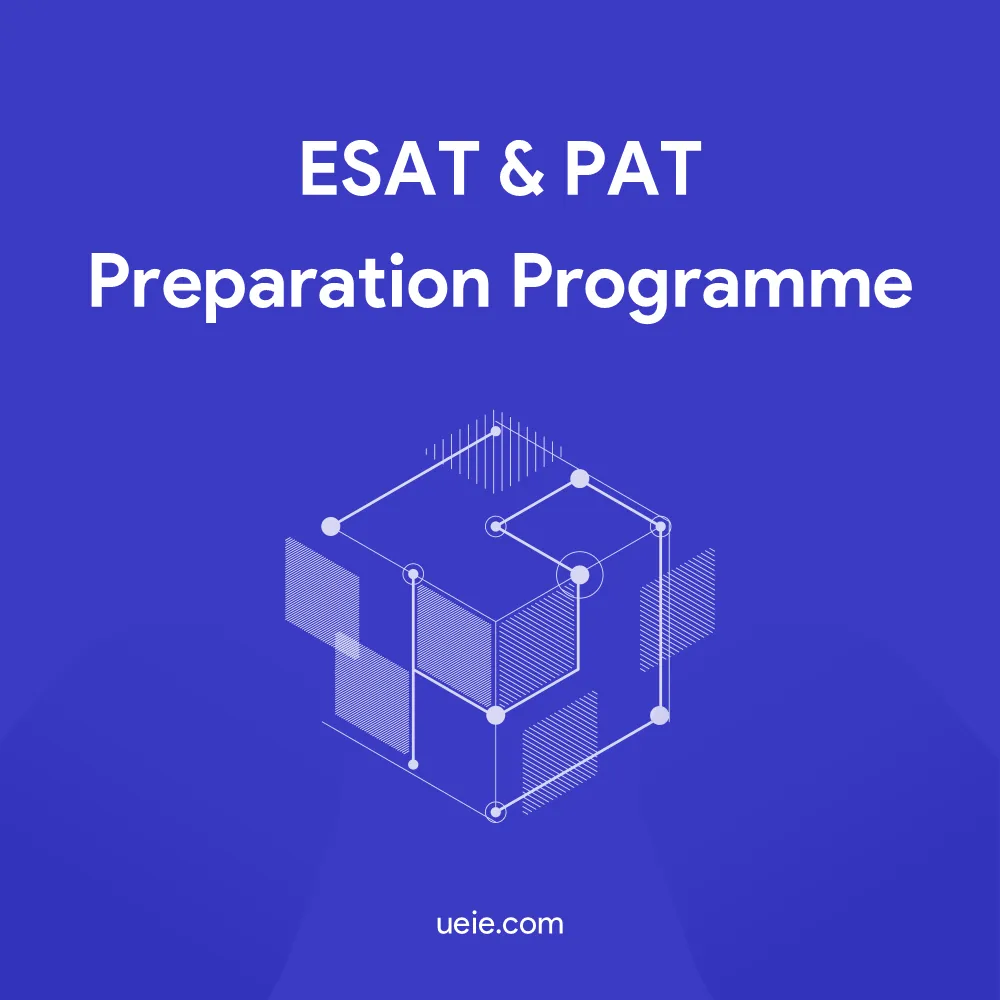
ESAT & PAT Preparation Programme
All-in-one exclusive resources. This programme features a 3000+ question bank, 9 unseen mock exams for each test, and 3 ESAT predictive papers to help you systematically master both new exams. Click to view the bundle.US$3 832 – US$14 270Price range: US$3 832 through US$14 270

ESAT & PAT On-Demand Prep Suite
The ESAT & PAT On-Demand Prep Suite, developed by Xie Tao, is your all-in-one solution for exam success, which includes video lectures covering Maths, Physics, over 1600 practice questions with detailed solutions, and full-length mock exams for ESAT Maths 1, Maths 2, Physics, and the Oxford PAT. Prepare thoroughly and maximise your score.US$612 – US$2 428Price range: US$612 through US$2 428
The greatest value of such resources lies in their optimised learning paths and training content, already structured according to the similarities and differences between the two examinations. They can clearly guide students on what to learn first, what to practise next, and how to practise most efficiently, thereby avoiding the potential waste of time and energy that can result from students figuring things out themselves. For those pursuing efficient preparation, this is a very wise choice.
3. Key Advice for Parents/Students
Combined preparation for ESAT and PAT is feasible, particularly for students primarily targeting engineering and physics disciplines. However, it is by no means an easy undertaking. The key to success lies in acknowledging and effectively addressing the core differences, especially calculator policies and examination style/structure. Planning must be meticulous, and training must be highly targeted; one cannot simply apply ‘one method for two examinations’.
V. Conclusion: Precise Analysis, Effective Preparation
In summary, ESAT and PAT, as gateways to science and engineering courses at their respective top universities, exhibit significant differences in terms of scope, structure, style, and particularly calculator policy, despite both being online multiple-choice examinations. Through the analysis in this article, we hope to have helped you clarify their core similarities and differences.
For applicants, whether focusing on one examination or needing to tackle both, the key to success lies in precisely understanding the requirements of the target examination, planning scientifically, and undertaking targeted, effective preparation.
Want to learn more? Please see:

ESAT Prep Hub
Master the ESAT with UEIE’s Prep Hub! We offer everything you need to succeed: in-depth video lecture series, extensive practice question bank, realistic full-length mock exams, expert guides, and insightful data analysis.
Oxford PAT Prep Hub
Master the Oxford PAT with UEIE’s Prep Hub! We offer everything you need to succeed: in-depth video lecture series, extensive practice question bank, realistic full-length mock exams, expert guides, and insightful data analysis. -
-

STEP vs TMUA vs MAT: A Strategic Comparison to Choose Your Maths Test
If you intend to apply for mathematics, computer science, or economics-related courses at top G5 universities in the UK, such as Oxbridge or Imperial College, you may need to face one of three examinations: STEP, TMUA, or MAT. The requirements for these examinations vary, often leaving applicants perplexed: STEP vs TMUA vs MAT — Which one should I prepare for? What are the differences between them? Which is most suitable for me?
Choosing the right examination and planning your preparation schedule appropriately can help you avoid detours and improve efficiency. This article will provide you with a clear and comprehensive comparative guide, analysing the core differences between STEP, TMUA, and MAT in terms of assessment focus, examination format, knowledge requirements, difficulty level, style, and specific university requirements. After reading this article, you will be better able to determine which examination best matches your target institutions and personal circumstances, thereby enabling you to make the most informed choice.
I. STEP vs TMUA vs MAT: Overview of the Three Examinations
To begin with, and before delving into a detailed comparison, the table below provides a quick outline of the core information for each of the three examinations – STEP, TMUA, and MAT – to help you form a basic impression.
Dimension Cambridge STEP TMUA Oxford MAT Managing Body University of Cambridge UAT-UK University of Oxford Exam Delivery Provider OCR Examination Board Pearson VUE Pearson VUE Answering Format Pen-and-paper Online computer-based Online computer-based Question Types Extended answer questions Multiple-choice questions Multiple-choice + Extended answer questions Key Characteristics Long, challenging questions; requires Further Mathematics knowledge; emphasises proof process. High time pressure; requires A-Level Mathematics; assesses speed, precision, logical judgment. Based on A-Level Mathematics, does not require Further Mathematics; emphasises flexibility of thought. Typical Universities / Courses Requiring Exam - Mandatory for Mathematics at Cambridge
- Accepted or recommended by Imperial/Warwick etc.
- Mandatory for Computer Science, Economics at Cambridge & certain courses at Imperial/LSE/UCL
- Accepted/alternative at Warwick/Durham etc.
- Mandatory for Mathematics/Computer Science related courses at Oxford.
Keywords Depth, Rigour, Proof, Cambridge Speed, Accuracy, Logical Reasoning, Wide Applicability Logic, Problem Solving, Flexibility of Thought, Oxford II. STEP vs TMUA vs MAT Comprehensive Comparison: Analysis of Key Dimensions
Having gained a basic impression of the three examinations, this section will provide a more comprehensive and detailed analysis, comparing the differences between STEP, TMUA, and MAT across multiple key dimensions.
1. Assessment Objectives and Focus
- Cambridge STEP: The core objective is to test profound mathematical thinking and rigorous proof-writing ability. Specifically, it requires students not only to solve problems but also to clearly and completely justify every step of their solution process, akin to conducting a small mathematical investigation. Therefore, it is suited for demonstrating a solid mathematical foundation and logical reasoning capability.
- TMUA: The core objective is to test the fluent application of mathematical knowledge and the agility of mathematical reasoning. It demands that students, under strict time constraints, quickly and accurately recall foundational knowledge (primarily AS Level) and make logical judgments. It is suited for demonstrating a solid foundation and efficient cognitive responsiveness.
- Oxford MAT: The core objective is to test a deep understanding of mathematical concepts and creativity in solving novel problems. It requires students to flexibly apply foundational knowledge (primarily A Level) and find breakthroughs via logical analysis in situations without fixed ‘routines’. It is suited for demonstrating flexibility of thought and mathematical intuition.
2. Applicable Universities and Course Requirements
University admissions policies may change annually. The table below is for reference only, based on information current as of 2025. Applicants for 2026 entry and beyond must consult the official websites of their target universities and courses for the latest, definitive information.
Dimension Cambridge STEP TMUA Oxford MAT Main Mandatory Requirements (Uni/Course) - University of Cambridge: Mathematics
- University of Cambridge: Computer Science, Economics
- Imperial College: Mathematics Dept., Economics, Finance & Data Science, some Computer Science Dept. courses etc.
- LSE: Economics, Econometrics, Mathematics & Economics etc.
- UCL: Economics
- University of Warwick: Mathematics, Statistics, Computer Science, Economics etc.
- Durham University: Some courses
- University of Oxford: Mathematics, Computer Science related courses
Recommended / Accepted Alternative / Other - University of Warwick: Can be substituted with TMUA/AEA
- Imperial College: Can supplement TMUA in special circumstances
- UCL: Can be used to lower A Level requirements, or substituted with AEA
- University of Bath etc.: May accept/recommend
- University of Oxford: Participation officially encouraged
- Warwick: Mathematics, Statistics accept STEP/AEA as alternatives
- Imperial, Warwick etc.: no longer require or accept MAT
Summary Positioning Core requirement for Cambridge Mathematics, accepted by some other institutions. Widest applicability, covering Maths, Comp Sci, Economics at many top institutions. Core requirement for University of Oxford. 3. Examination Format and Structure
Dimension Cambridge STEP TMUA Oxford MAT Examination Mode Pen-and-paper Paperless computer-based Paperless computer-based Question Types Extended answer questions Multiple-choice questions Multiple-choice + Extended answer questions Paper Construction Globally uniform paper Question bank based (papers may differ slightly by region/session) Globally uniform paper Number of Questions STEP 2 & STEP 3: 12 questions per paper, answer any 6. Papers 1 & 2: 20 questions each, total 40 multiple-choice, answer all. Total 25 multiple-choice + 2 extended answer (keyboard input), answer all. Examination Duration 3 hours / per paper 2.5 hours (75 mins each for Paper 1 & 2) 2.5 hours Permitted Aids Calculators, formula sheets, dictionaries NOT allowed. Calculators, formula sheets, dictionaries NOT allowed. Calculators, formula sheets, dictionaries NOT allowed. 4. Marking Scheme and Result Presentation
Dimension Cambridge STEP TMUA Oxford MAT Scoring Method Only the best 6 questions scored (20 marks each), total 120. All 40 multiple-choice questions scored (1 mark each), raw total 40. All questions scored (MCQ weighted by difficulty, total 70; Extended answers 15 marks each with partial credit), total 100. Result Format Grades: S, 1, 2, 3, U (S highest) Standardised score: 1.0 – 9.0 (one decimal place) Raw score: 0 – 100 Score Thresholds Variable, adjusted annually based on paper difficulty and candidate performance. No ‘pass mark’; score significance depends on application context. No fixed ‘offer threshold’; Oxford uses holistic assessment, score significance interpreted against historical data. Competitiveness Reference Cambridge typically requires Grade 1 or S; other institutions may require Grade 2 or above. Generally, 6.5+ considered competitive; 7.0+ strong; 8.0+ highly competitive. Oxford offer-holders often average around 70; recent trend suggests rising scores, mainland Chinese students may need higher for interview. 5. Comparison of Knowledge, Difficulty, and Style
Dimension Cambridge STEP TMUA Oxford MAT Knowledge Requirement STEP 2: A Level Maths + AS Further Maths
STEP 3: A Level Maths + A Level Further MathsPrimarily based on A Level Maths + some GCSE Maths Primarily based on A Level Maths Further Mathematics Required Not required Not required Question Style Depth & Rigour: Assesses deep understanding and complex application of knowledge, emphasising rigorous, multi-step proof processes. Structured, progressive questions, akin to mini mathematical research. Speed & Application: Assesses fluent mastery and rapid, accurate application of foundational knowledge, plus agility in logical reasoning. Short, fast-paced questions focused on reaction speed and calculation/judgment precision. Flexibility & Creativity: Assesses profound understanding of basic concepts and flexible application in novel contexts, emphasising logical analysis and creative problem-solving. Cleverly designed questions, sometimes like mathematical puzzles, prioritising insightful approaches. Source of Difficulty Depth and breadth of knowledge (esp. Further Maths); high standard for proof rigour; question length and computational complexity; requires problem-solving stamina. Extreme time pressure (avg. 3.5 mins/question); demands exceptional speed and accuracy in calculation/judgment; requires swift judgement in logical reasoning questions. Novelty/’non-routine’ nature of questions; demands depth and rigour in logical thinking; requires creative application of basic knowledge to unfamiliar scenarios. Difficulty Rating ★★★★★ ★★★ ★★★☆ Comparison with A-Level Far exceeds A-Level, particularly in depth of thought, proof requirements, and breadth of knowledge (incl. Further Maths). Significantly exceeds A-Level, mainly in demands for speed, precision, and logical application. Far exceeds A-Level, especially in depth of logical reasoning, creativity in problem-solving, and flexibility of thought. Summary Points
- Knowledge Threshold: STEP has mandatory Further Mathematics requirements, the highest amongst the three. The knowledge base for TMUA and MAT is relatively closer to standard A Level.
- Core Challenge: STEP’s difficulty lies in depth and proof; TMUA’s in speed and efficiency; MAT’s in thinking and novelty.
- Difficulty Consensus: All three examinations are considerably more challenging than A Level examinations, requiring a higher level of mathematical proficiency and ability.
III. How to Choose: Selecting the Most Suitable Examination for You
Having understood the detailed differences between the three examinations, the question now is: which examination(s) do you need to prepare for? The following steps will guide you in making an initial determination:
1. Step 1: Identify Mandatory Requirements
This is the decisive starting point for choosing an examination, overriding all other factors.
Clarify Targets: Clearly identify all the universities and specific courses you plan to apply for.
Verify Official Websites: Visit the official admissions pages for each of these university courses one by one. First, find and confirm the latest, most accurate entrance examination requirements for your intended year of entry (e.g., 2026). Crucially, pay attention to keywords such as ‘Required,’ ‘Recommended,’ ‘Accepted Alternative,’ etc..
Determine Mandatory Exams: Based on the official information, determine which examinations you must take.
- Applying to Oxford Mathematics/Computer Science etc. → MAT is mandatory.
- Applying to Cambridge Mathematics → STEP is mandatory.
- Applying to Cambridge Computer Science/Economics → TMUA is mandatory.
- Applying to Imperial/LSE/UCL/Warwick etc. for Mathematics, Computer Science, Economics → Check specific requirements; TMUA is often mandatory, but note if alternatives are accepted.
Completing this step clarifies the examination hurdles you must overcome. Consequently, for some students, the result might be needing to prepare for only one examination; in contrast, for others, it might mean facing the challenge of two or even three examinations simultaneously.
2. Step 2: When Options Exist, Match with Personal Attributes
You only need to consider this second step under the following circumstances:
- University Offers Multiple Options: Your desired university/course accepts more than one examination result (e.g., Warwick accepts TMUA/STEP/AEA).
- Saving Preparation Time and Effort: You are required to take multiple examinations and need to judge which one better aligns with your natural strengths to allocate preparation effort more reasonably.
- Considering Optional Exams for Enhancement: You are considering taking a non-mandatory examination (e.g., Oxford encourages STEP) to strengthen your application competitiveness.
In such cases, consider the following personal factors to determine which examination allows you to best leverage your strengths:
Academic Background and Strengths
- Is Further Mathematics your comfort zone, and do you enjoy rigorous proofs? → STEP might be a good fit.
- Is your foundational mathematics exceptionally solid, are you fast and accurate in calculations, and is your logic clear? → TMUA’s requirements might highly match your abilities.
- Can you demonstrate profound understanding without relying on Further Mathematics, are you flexible in thinking, and adept at clever solutions? → MAT’s style might suit you better.
Learning and Examination Preferences
- Prefer immersive problem-solving on a few challenging questions? → STEP’s format (choose 6 from 12).
- Prefer fast-paced responses to a variety of questions (multiple-choice)? → TMUA’s format.
- Prefer logical puzzles and showcasing thought processes (multiple-choice + extended answers)? → MAT’s format.
Available Preparation Time
- Ample time, able to commit long-term (9-12 months+)? → Better equipped to handle STEP’s depth requirements.
- Relatively limited preparation time, needing efficient improvement? → Preparation for TMUA or MAT (especially a TMUA+MAT combination) might offer higher time efficiency.
3. Summary
The primary basis for choosing an entrance examination is the undeniable mandatory requirement set by the target university. Beyond that, personal academic strengths, learning preferences, and time planning are important considerations for making a choice (when options exist) or optimising your preparation strategy.
IV. Addressing Multiple Challenges: Common Examination Combinations and Preparation Strategies
If you plan to apply simultaneously to several top universities (e.g., Oxbridge, Imperial, LSE) for mathematics, computer science, or economics courses, you will likely need to prepare for multiple entrance examinations. Below are suggestions for preparation timelines and strategies for common combinations of these three examinations.
1. STEP + TMUA Combination
Applicable Universities and Courses: Simultaneously applying to Cambridge University and other G5 universities for mathematics-related courses.
Suggested Preparation Period: 12 months or more. Sufficient time is needed to separately hone the depth required for STEP and the speed for TMUA.
Core Preparation Strategy:
- Specialised Training: Independent, high-intensity specialised practice sessions must be arranged to address STEP’s depth of proof and Further Mathematics, alongside TMUA’s timed multiple-choice answering, speed, and precision.
- Style Switching: Focus on adaptability training to switch between two vastly different problem-solving styles and thinking modes.
2. TMUA + MAT Combination
Applicable Universities and Courses: Simultaneously applying to Oxford University and other G5 universities for mathematics or computer science related courses.
Suggested Preparation Period: Preparation time varies depending on mathematical foundation, generally 5-10 months is recommended.
Core Preparation Strategy:
- Integrated Foundation: Leverage the high degree of knowledge overlap to consolidate foundational review and core competency training.
- Differentiated Training: Specifically strengthen TMUA’s timed multiple-choice speed and techniques, alongside MAT’s logical depth and extended answer argumentation.
- Resource Utilisation: Consider using resources specifically targeting this combination (e.g., the UEIE TMUA+MAT series) to maximise preparation efficiency.
3. STEP + TMUA + MAT Combination
Applicable Universities and Courses: Uncertain initially whether applying for Cambridge or Oxford mathematics, or wishing to enhance mathematical proficiency through STEP preparation, ultimately deciding to apply for Oxford and other G5 universities for mathematics or computer science related courses.
Suggested Preparation Period: 18 months or more. An extreme challenge to time, ability, and perseverance.
Core Preparation Strategy:
- Realistic Assessment: Prudently evaluate your own abilities and goals, setting feasible expectations.
- Intensive Planning: Develop an extremely detailed plan integrating the requirements of all three, potentially requiring trade-offs in some areas.
- Seek Support: Strongly recommended to seek guidance from experienced professionals and efficiently utilise all available resources.
- Focus on Core: Within extremely limited time, prioritise ensuring absolute solidity in core knowledge and common competencies before undertaking the most efficient training for specialised skills.
V. Conclusion and Action Recommendations
Through the comprehensive comparison in this article, it is hoped you now have a clearer understanding of the three entrance examinations: STEP, TMUA, and MAT. Let us summarise the core points:
- Cambridge STEP: Characterised by its depth, rigour, and requirement for Further Mathematics, it focuses on assessing students’ ability to undertake complex mathematical proofs and deep thinking, serving as a hallmark threshold for courses like Cambridge Mathematics.
- TMUA: With its high demands on speed, accuracy, and logical reasoning, it focuses on assessing students’ ability to fluently apply core mathematical knowledge under time pressure, having the broadest range of applications.
- Oxford MAT: By examining flexibility of thought, logical depth, and creative application of foundational knowledge, it focuses on assessing students’ mathematical potential and ability to solve novel problems, serving as Oxford University’s distinctive selection tool.
So, having clarified these differences, what should you do next?
First Priority
Verify Official Requirements! To reiterate, the final decision on which examination(s) to take rests with the universities and courses you are applying to. You need to log onto the official admissions websites of your target institutions to understand the latest, most accurate entrance requirements. Any non-official information (including this article) can only serve as a reference.
Gain In-depth Understanding of Relevant Exams
After determining the examination(s) you need to take, it is recommended you read my detailed guides and preparation guides for the relevant examinations to obtain more in-depth information:
Focus on Specific Combinations
If you find you need to take both TMUA and MAT, you can further read my analysis on preparation strategies for this combination:
Understand the Registration Process
Once you have decided on the examination(s), familiarise yourself with and prepare for the registration procedures in a timely manner:
Plan and Prepare Early
Regardless of which examination you choose, thorough preparation is key to success. Utilise the relevant preparation guides, formulate a detailed preparation plan early on, and put it into action. If needed, consider leveraging high-quality preparation resources, such as:

TMUA Prep Hub
Master the TMUA with UEIE’s Prep Hub! We offer everything you need to succeed: in-depth video lecture series, extensive practice question bank, realistic full-length mock exams, expert guides, and insightful data analysis.
Oxford MAT Prep Hub
Master the Oxford MAT with UEIE’s Prep Hub! We offer everything you need to succeed: in-depth video lecture series, extensive practice question bank, realistic full-length mock exams, expert guides, and insightful data analysis.
Cambridge STEP Prep Hub
Master the Cambridge STEP with UEIE’s Prep Hub! We offer everything you need to succeed: in-depth video lecture series, extensive practice question bank, expert guides, and insightful data analysis.Choosing the correct entrance examination is a significant step towards your dream university. I hope the comparative analysis in this article illuminates the path ahead, helping you make the decision best suited to you. Wishing you smooth preparation and successful applications!
-

2025 G5 Admissions Tests: Dates, Requirements & Preparation Timeline

I. Admissions Test Reforms: Navigating Your Choices
The landscape of admissions tests for Oxbridge and other G5 universities has been constantly evolving. Recently, several tests have been discontinued, while new ones like ESAT, UCAT, and TARA have emerged. Adding to the complexity, different universities often have varying test requirements even for similar courses, creating significant hurdles for applicants.
Strong performance in these admissions tests is vital for receiving an offer from a G5 university. For students and their parents, keeping up with the latest requirements, selecting the appropriate exams, and preparing efficiently pose considerable challenges.
This guide breaks down the 2025 admissions test schedule and specific course requirements for Oxbridge and G5 universities. Our goal is to assist applicants and their families in defining clear application targets, mapping out a practical preparation timeline, and focusing their efforts strategically to boost their chances of success.
II. Overview of 2025 Oxbridge & G5 Admissions Tests
As soon as universities officially released their 2025 admissions test details, we carefully compiled the following tables. They summarise the name, date, subjects/content covered, and applicable courses for each exam, aiming to provide a clear and quick understanding of this year’s Oxbridge and G5 test arrangements.
Tests for Cambridge, Imperial College, UCL & LSE
Test Name Test Date(s) Subjects/Content Applicable Universities Applicable Courses STEP STEP 2: 11 June 2025 STEP 3: 16 June 2025 2026 dates TBC Mathematics, Further Mathematics Cambridge University Mathematics, Mathematics and Physics ESAT 9 Oct 2025 (Not for mainland China, HK, Macau candidates) 10 Oct 2025 6-7 Jan 2026 (Not for Cambridge candidates) Mathematics 1, Mathematics 2, Physics, Chemistry,Biology Cambridge University Engineering, Chemical Engineering & Biotechnology, Natural Sciences, Veterinary Medicine Imperial College Aeronautics, Chemical Eng, Civil & Environmental Eng, Dyson Design Eng, Elec & Electronic Eng, Mechanical Eng, Physics UCL Electronic & Electrical Engineering TMUA 13 Oct 2025 (Not for mainland China, HK, Macau candidates) 14 Oct 2025 8-9 Jan 2026 (Not for Cambridge candidates) Mathematics Cambridge University Computer Science, Economics Imperial College Computing courses, Maths courses, Economics, Finance & Data Science LSE Economics (Required), Econometrics & Mathematical Economics (Required), Maths & Economics (Recommended) UCL Economics TARA 15-16 Oct 2025 12-13 Jan 2026 Critical Thinking, Problem Solving, Effective Communication UCL Computer Science, Mathematical Computation, Robotics & AI, European Social & Political Studies, Int’l Social & Political Studies, Management Science, Social Sciences, Sociology & Data Science, Sociology UCAT 7 July to 26 Sept 2025 Verbal Reasoning, Decision Making, Quantitative Reasoning Cambridge University Medicine Oxford University Medicine UCL Medicine LNAT 1 Sept to 15 Oct 2025 Reading Comprehension, Essay Writing Cambridge University Law Oxford University Law, Law with European Law LSE Law UCL Law Oxford University’s Specific Admissions Tests
Test Name Test Date(s) Subjects/Content Applicable Courses MAT 22-23 Oct 2025 Mathematics Mathematics, Mathematics & Philosophy, Mathematics & Computer Science, Computer Science, Computer Science & Philosophy PAT 22-23 Oct 2025 Mathematics, Physics Physics, Physics & Philosophy, Engineering, Materials Science TSA 21-24, 27 Oct 2025 Critical Thinking, Problem Solving Section 1 only: Economics & Management, Experimental Psychology, History & Economics, Human Sciences, PPL (Psychology, Philosophy & Linguistics) Sections 1 & 2: PPE (Philosophy, Politics & Economics) AHCAAT 24 Oct 2025 Critical Academic Writing, Analysis of Ancient History Materials Classical Archaeology and Ancient History BMSAT 21-24, 27 Oct 2025 Mathematics, Physics, Chemistry, Biology Biomedical Sciences CAT 22-24 Oct 2025 Latin Translation, Greek Translation, Classical Languages Aptitude Classics, Classics & English, Classics & Modern Languages, Classics & Asian and Middle Eastern Studies MLAT 24 Oct 2025 8 Languages including French, Language Aptitude, Philosophy European & Middle Eastern Languages, Classics & Modern Languages, English & Modern Languages, History & Modern Languages, Modern Languages, Modern Languages & Linguistics, Philosophy & Modern Languages PhilAT 24 Oct 2025 Philosophical Reasoning Philosophy and Theology Tests Cancelled in 2024 and 2025 and Their Replacements:
- Oxford’s HAT (History Aptitude Test) – No replacement
- Cambridge’s ENGAA (Engineering Admissions Assessment) & NSAA (Natural Sciences Admissions Assessment) – Both replaced by ESAT
- BMAT (BioMedical Admissions Test) – Replaced by UCAT or BMSAT (depending on course/university)
Test Format
With the exception of Cambridge’s STEP exams, all the tests mentioned above are delivered online as computer-based exams. They are administered by Pearson VUE at their global test centres.
III. Comparative Analysis of Oxbridge & G5 Test Requirements by Course
This section provides a side-by-side comparison of admissions test requirements for five major subject categories: Mathematics, Computer Science, Engineering, Natural Sciences (Physics), and Economics.
We will focus specifically on:
- Required Tests: Which admissions tests does each university require for the same course?
- Test Difficulty: What is the approximate difficulty level of each test?
- Target Scores (Reference): Apart from Cambridge’s STEP, which has defined grade requirements, other tests do not have official ‘cut-off scores’. The reference scores provided in the tables below are not official data and do not necessarily represent the minimum scores achieved by admitted students.
1. Admissions Test Requirements for Mathematics Courses
University Test Difficulty Target Score (Reference) Cambridge University STEP Hard Grade 1 or above Oxford University MAT Relatively Hard 75+ Imperial College TMUA Medium 6.5+ LSE TMUA Medium 7.0+ Common Test Combinations for Oxbridge & G5 Mathematics Applicants
University Combination Tests Suggested Preparation Time Cambridge + Other G5/Universities STEP+TMUA STEP: 6+ months + TMUA: 2-3 months OR STEP: 3-6 months + TMUA: 3-4 months Oxford + Other G5/Universities MAT+TMUA (STEP optional) 3-5 months (up to 10 months max) Imperial / LSE / UCL + Other Universities TMUA 4-6 months (up to 10 months max) 2. Admissions Test Requirements for Computer Science Courses
University Test Difficulty Target Score (Reference) Cambridge University TMUA Medium 7.5+ Oxford University MAT Relatively Hard 80+ Imperial College TMUA Medium 7.0+ UCL TARA Medium Unknown (New for 2025 entry) Common Test Combinations for Oxbridge & G5 Computer Science Applicants
University Combination Tests Suggested Preparation Time Cambridge + Other G5/Universities TMUA 3-5 months (up to 10 months max) Oxford + Other G5/Universities MAT+TMUA (STEP optional) 3-5 months (up to 10 months max) Imperial + Other Universities TMUA 4-6 months (up to 10 months max) Imperial / UCL + Other Universities TMUA+TARA 4-6 months (up to 10 months max) 3. Admissions Test Requirements for Engineering Courses
University Test Difficulty Target Score (Reference) Cambridge University ESAT Medium Average 7.0+ across 3 modules Oxford University PAT Relatively Hard 75+ Imperial College ESAT Medium Average 6.5+ across 3 modules UCL ESAT Medium Unknown (New for 2025 entry) Common Test Combinations for Oxbridge & G5 Engineering Applicants
University Combination Tests Suggested Preparation Time Cambridge + Imperial / UCL ESAT 3-5 months (up to 10 months max) Oxford + Imperial / UCL ESAT+PAT 3-5 months (up to 10 months max) Imperial / UCL ESAT 4-6 months (up to 10 months max) 4. Admissions Test Requirements for Natural Sciences (Physics) Courses
University Test Difficulty Target Score (Reference) Cambridge University ESAT Medium Average 7.0+ across 3 modules Oxford University PAT Relatively Hard 75+ Imperial College ESAT Medium Average 6.5+ across 3 modules Common Test Combinations for Oxbridge & G5 Natural Sciences (Physics) Applicants
University Combination Tests Suggested Preparation Time Cambridge + Imperial ESAT 3-5 months (up to 10 months max) Oxford + Imperial ESAT+PAT 3-5 months (up to 10 months max) Oxford PAT 3-5 months (up to 10 months max) Imperial ESAT 4-6 months (up to 10 months max) 5. Admissions Test Requirements for Economics Courses
University Test Difficulty Target Score (Reference) Cambridge University TMUA Medium 7.0+ Oxford University TSA Medium PPE & E&M: 85+; Others: 70+ Imperial College TMUA Medium 6.5+ LSE TMUA Medium 7.0+ UCL TMUA Medium 6.5+ Common Test Combinations for Oxbridge & G5 Economics Applicants
University Combination Tests Suggested Preparation Time Cambridge + G5 + Others TMUA 4-6 months (up to 10 months max) Oxford TSA 4-6 months (up to 10 months max) Imperial / LSE / UCL + Others TMUA 4-6 months (up to 10 months max) IV. Admissions Test & Interview Preparation Timeline
This section offers a general timeline for preparing for admissions tests and interviews, designed to help candidates plan effectively. Please note this is just a suggested timeline; your specific schedule should be adjusted based on your individual circumstances and the requirements of your target universities.
Time Period Main Tasks Key Focus Areas Feb – Jun Research, Skills Training 1. Read the latest admissions requirements on the Oxbridge/G5 university websites carefully.
2. Decide on target courses and the required tests.
3. Gather official materials: syllabuses, sample questions, past papers.
4. Understand test formats, question types, difficulty levels.
5. Create a detailed preparation plan or choose suitable prep courses/materials.
6. Strengthen maths and critical thinking skills for tests and interviews.Jun – Sep Systematic Revision, Build Foundation 1. Review foundational knowledge for each test subject based on the syllabus.
2. Use structured courses or materials for topic-specific practice.
3. Complete examples and exercises to consolidate knowledge.
4. Start attempting past papers (if available) to understand question styles and difficulty.October Final Push, Mock Exams 1. Take mock exams to familiarise yourself with timings and procedures.
2. Focus on weak areas identified in mocks.
3. Improve speed and accuracy in answering questions.
4. Get into optimal condition before sitting the actual tests.Oct – Dec Interview Preparation 1. Analyse test results (if released) to assess strengths and weaknesses.
2. Adjust application strategy if necessary (e.g., change target school/course – not applicable if UCAS submitted).
3. Intensify mock interview practice if you receive invitations.Jan – Jun (Following Year) Await Results, STEP Prep (if needed) 1. Wait for admission decisions.
2. If required, prepare for STEP exams (refer to STEP preparation guides). -

Ace the Oxford PAT: Mastering Maths, Physics & Online Test Skills

For students aspiring to apply for Physics, Engineering Science, or Materials Science at the University of Oxford, successfully navigating the Physics Aptitude Test (PAT) is a crucial step in the application process. With the PAT’s recent transition to a fully online, computer-based examination featuring solely multiple-choice questions, adapting to this new format and preparing efficiently has become a significant challenge for candidates. I hope this Oxford PAT Preparation Guide, authored by me (Mr. Xie Tao) and based on many years of experience coaching students for Oxbridge admissions tests, will provide you with a systematic and practical set of preparation strategies and methods tailored to the latest examination format.
Before delving into this guide, I strongly recommend that you first carefully read Oxford PAT Comprehensive Guide to gain a full understanding of the latest developments, requirements, and marking criteria for the examination.
I. Clarifying Objectives and Self-Assessment for Oxford PAT Preparation
To embark on your Oxford PAT preparation journey, you must first clearly understand your ‘destination’ (target requirements) and your current ‘starting point’ (your own level). This is the prerequisite for formulating any effective preparation strategy.
1. Clarify Target Requirements
PAT scores are crucial for Oxford Physics, Engineering, or Materials Science applications. Though no fixed cutoff exists, PAT results still strongly influence interview selection.
- Consult Official Information: It is imperative to visit the official University of Oxford website and meticulously review the latest and most accurate admissions requirements for your intended year of entry (e.g., 2026).
- Understand the R-Score: In recent years, the Physics Department at Oxford has primarily referred to the R-Score during the shortlisting phase for interviews. Understanding its general calculation method (for specific details, please refer to Oxford PAT Comprehensive Guide) will help you more accurately comprehend the weighting of PAT scores in your application.
- Refer to Historical Data: Oxford PAT Comprehensive Guide also provides data from previous years, such as average PAT scores of applicants and interview shortlisting thresholds. These can serve as a reference when setting your goals.
2. Conduct a Preliminary Self-Assessment
Before commencing systematic preparation, undertaking a Diagnostic Exam is crucial, especially to familiarise yourself with the latest online examination format. This will help you to:
- Experience the Difficulty and Format: Personally try the interface, 40 MCQs (single/multiple-answer), 120-minute time pressure, and online calculator.
- Understand Your Current Standing: Assess your current physics and mathematics knowledge and online MCQ skills. Then identify gaps between your level and the target requirements.
3. How to Conduct a Diagnostic Exam?
Choosing a Test Tool
Prioritise Oxford’s latest online practice tests; they best simulate the real exam.
Alternatively, Alternatively, you can use high-quality mock tests, like UEIE’s Free Oxford PAT Diagnostic Exam. It closely mimics the latest PAT format and difficulty level and helps assess core PAT knowledge and skills effectively. Click below for details and to take the Diagnostic Exam online.
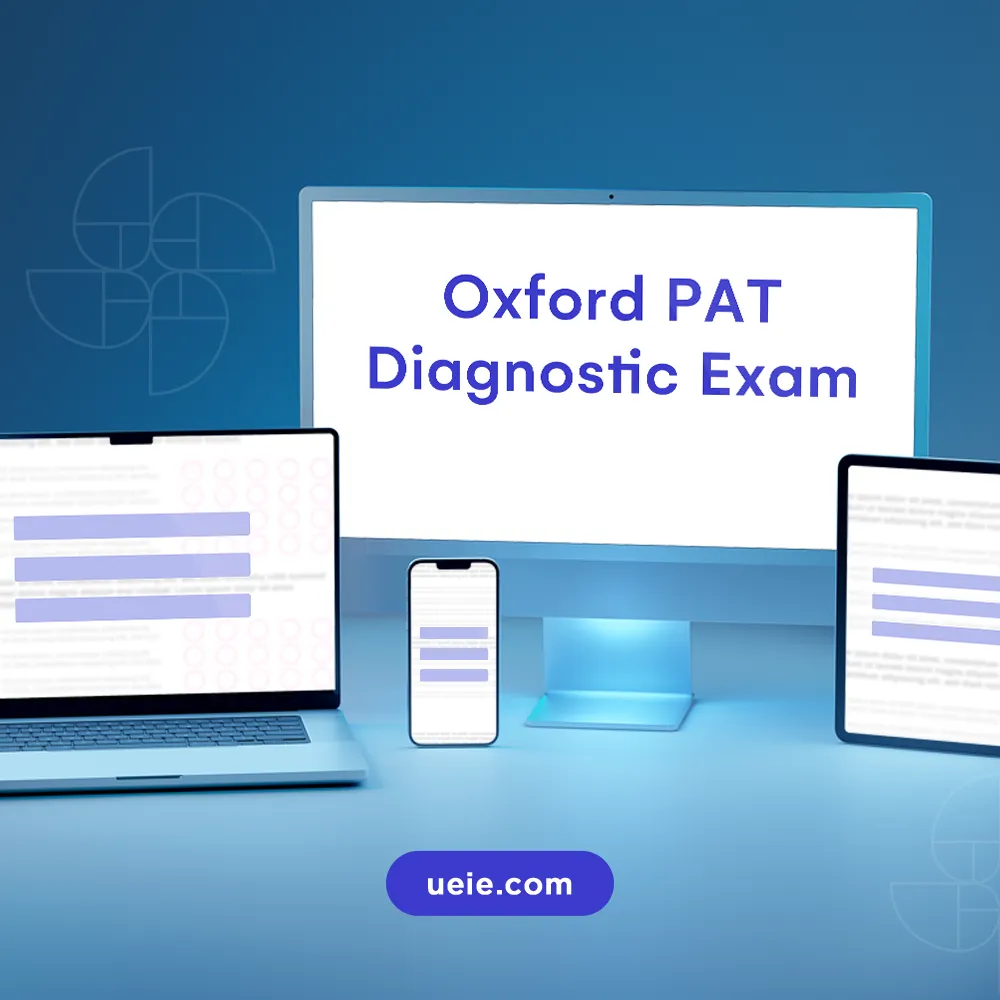
Free Oxford PAT Diagnostic Exam
Test your physics knowledge and math application. Identify areas for focused preparation. This free Oxford PAT diagnostic includes challenging problems and detailed solutions. Get expert feedback from UEIE’s tutors and boost your Oxford application.Note: When using past papers from before 2024 for practice, be aware of their question types. These types, including written sections and non-multiple-choice questions, differ from the current format. Their main value lies in testing knowledge point mastery rather than fully simulating the examination experience.
Simulating a Realistic Environment
- Strictly adhere to the 120-minute time limit.
- Complete the test on a computer to become familiar with screen reading and mouse operation.
- Use only the system-provided online calculator; do not use any personal calculators or consult external materials.
- Choose a quiet, distraction-free environment.
Objective Evaluation and Analysis
- Score yourself objectively based on the marking scheme (multiple-choice questions are typically marked by checking answers).
- Focus on analysing incorrect questions: Was it due to forgotten knowledge points? Unclear concepts? Calculation errors (especially when using the online calculator)? Misinterpretation of the question? Inappropriate multiple-choice strategies?
- Record your weak areas, which will become a focus for subsequent preparation.
4. Set Scientific PAT Score Goals
Combining your target requirements and self-assessment results, you need to set scientific and reasonable preparation goals. It is advisable to follow the SMART principles:
- Specific: Clearly define the PAT score percentage range you aim to achieve (e.g., target above 70%, or strive to reach the average level of admitted students for your target course in previous years).
- Measurable: Your goals should be trackable and measurable through subsequent mock test scores.
- Achievable: Based on your starting point, available time, and anticipated effort, your goals should be attainable through hard work.
- Relevant: Your goals should serve your overall application objective of receiving an interview invitation and, ultimately, an offer.
- Time-bound: Clearly define the deadline for achieving your goals (i.e., the official examination date).
Balancing Ambition with Realism
Goals should be challenging enough to stimulate your potential yet remain realistic. To understand the R-score, a good GCSE background helps alongside the PAT. However, for most students, improving their PAT score is the aspect over which they have the most active control. Remember, the PAT is just one part of the assessment. However, a high score boosts your chances.
5. Adjust Your Mindset and Embrace the Oxford PAT Preparation Challenge
Oxford PAT preparation, especially when adapting to the new format, can present difficulties and setbacks. It is crucial to cultivate a positive mindset:
- Accept the Challenge: View the PAT as an opportunity to enhance your physics thinking, mathematical application, and examination-taking skills.
- Acknowledge the Gap: The purpose of a Diagnostic Exam is to identify problems; the score, whether high or low, merely represents your starting point.
- Focus on the Process: Concentrate on mastering knowledge, improving skills, and optimising strategies.
- Maintain Resilience: Encountering difficult problems or performing poorly in mock tests is normal. The key is to analyse the reasons, learn from the experience, and persevere.
II. Knowledge Base Required for Oxford PAT Preparation
Precisely grasping the knowledge requirements of the PAT is the first step in formulating an effective preparation strategy. You need to know what’s tested, what’s excluded, and how to prepare based on your background.
1. PAT’s Requirements for A-Level Knowledge
The PAT syllabus is based on the UK’s A-Level curriculum but has its specific scope and emphasis:
- Core Scope: Focuses on A-Level Maths Pure topics and AS Physics, plus some A2 Physics content.
- No Further Mathematics: The PAT does not include content from A-Level Further Mathematics. This is to ensure fairness to students who have not studied Further Mathematics. Therefore, there is no need to invest effort in learning Further Mathematics topics specifically for the PAT.
- Depth over Breadth: Although the syllabus may appear concise, the PAT does not simply test the recall of knowledge points. It requires profound understanding of syllabus core physical principles and mathematical tools, and flexible application in novel complex multiple-choice scenarios.
2. Knowledge Alignment for Students from Different Curricula
Students following non-A-Level curricula, such as AP or IB, need to proactively compare and supplement their knowledge:
AP Curriculum Students
- Typically, AP Physics C: Mechanics and AP Physics C: Electricity and Magnetism, or AP Physics 1 and 2, cover most of the PAT Physics syllabus content.
- However, check official PAT syllabus for omissions or differing emphases, e.g., basic astronomy, and cross-reference algebra/trig topics as AP Calculus BC coverage may be incomplete.
IB Curriculum Students
- IB DP Physics HL usually covers the PAT Physics knowledge range well. However, there might be issues with the pace of learning, as some A2 content required for the PAT may be taught later in the IB programme, necessitating early self-study.
- IB Mathematics (AA HL or AI HL) may have different content emphases compared to A-Level Mathematics. Similarly, it is essential to check for and fill any gaps against the PAT mathematics syllabus.
Core Recommendation
Regardless of your curriculum, the most authoritative standard is always the latest examination syllabus released by the PAT authorities. Be sure to download the syllabus, check it item by item, and develop a detailed knowledge supplementation plan to ensure all required content is covered.
3. The Role of Physics Competition Background and Coping Strategies
Competition Advantage
In recent years, the difficulty and style of PAT questions have indeed shown a trend towards those found in physics competitions (such as the British Physics Olympiad, BPhO Round 1). Students with relevant competition experience may have an advantage in handling complex physical scenarios and employing multiple methods to solve problems, and their thinking tends to be more flexible.
Not a Prerequisite
However, it must be emphasised that a physics competition background is by no means a prerequisite for taking the PAT or achieving a good score. The core of the PAT remains the assessment of a profound understanding and application of the knowledge within the syllabus.
Coping Strategies
- For Students with a Competition Background: You can leverage the problem-solving skills and physical intuition developed through competitions. However, you still need to systematically review the PAT syllabus to ensure a solid foundation and practise online multiple-choice questions specifically.
- For Students without a Competition Background: There is no need for anxiety. The focus of your preparation should be on thoroughly understanding the PAT syllabus knowledge and enhancing your physics thinking and mathematical application skills. If time and energy permit, you can engage with some high-quality challenging problems through officially recommended resources (such as Isaac Physics or some past BPhO questions), focusing on learning their problem-analysis methods and thought processes. The aim is to broaden your thinking, not to systematically learn competition-specific knowledge.
III. Core Competencies Essential for High PAT Scores (Under the New Format)
Mastering the knowledge required by the PAT syllabus is fundamental, but this alone is not sufficient to guarantee a high score. Especially with the transition to an online, purely multiple-choice format, you also need to hone the following key core competencies to stand out in the fierce competition.
1. Profound Understanding of Physics Concepts and Physical Intuition
This remains the core of what the PAT assesses. Regardless of how question types change, a deep understanding of fundamental physical concepts and laws is the cornerstone for solving complex problems. You need to:
- Go Beyond Formula Memorisation: Not only memorise formulae but also understand their physical meaning, conditions for applicability, and derivation logic.
- Build Physical Pictures: Be able to quickly translate the scenario described in a question into a clear physical model.
- Cultivate Physical Intuition: Possess a keen insight into physical phenomena, enabling you to quickly identify the crux of a problem and the likely main physical processes involved (sometimes referred to as ‘nous’ or ‘insight’).
2. Solid Application of Mathematical Knowledge and Problem-Solving Skills
A significant number of PAT questions require the application of A-Level mathematical knowledge to analyse and calculate physical problems. You need to possess:
- Proficient Use of Mathematical Tools: Flexibly apply algebraic, geometric, trigonometric, and calculus methods to solve physics calculations.
- Accurate and Swift Calculation: Maintain accuracy and a reasonable speed in calculations under time pressure and without the aid of pen-and-paper derivations (some rough work can be done on paper). Although an online calculator is provided, it is not suitable or efficient for every step.
3. Efficient Strategies and Techniques for Online Multiple-Choice Questions
This is one of the most critical skills under the new format. With 40 multiple-choice questions (including single-best-answer and multiple-answer questions) to be completed in 120 minutes, averaging only 3 minutes per question, mastering efficient strategies is essential:
- Rapid Question Comprehension and Modelling: Quickly grasp the core information of the question, construct the correct physical model, and determine the necessary formulae and methods.
- Option Analysis and Elimination: Utilise physical intuition, dimensional analysis, special values/extreme cases, and estimation to quickly assess the plausibility of options, prioritising the elimination of obviously incorrect distractors.
- Beware of Question Traps and Easily Confused Concepts.
- Addressing Single-Best-Answer and Multiple-Answer Questions: Clearly understand the question’s requirement (select one best answer or all correct answers) and adjust your problem-solving strategy accordingly. Multiple-answer questions require more thorough consideration and verification.
- Time Management and Decision-Making: Quickly assess the difficulty of a question, decisively skip (and mark) challenging problems for which you have no immediate ideas, avoid getting ‘stuck’ on a question, and ensure you complete all questions you are confident about. Learn when to make educated guesses if necessary (there is no negative marking).
4. Proficiency in Using the Online Calculator
Unlike in the past, you must now exclusively use the online calculator provided within the examination system. You need to:
- Familiarise Yourself with its Functions and Limitations: Through the official online practice platform, thoroughly understand the specific functions of the online calculator (such as button layout, order of operations, supported functions) and its limitations.
- Enhance Operational Efficiency: Practise inputting numbers and performing operations quickly and accurately within the online interface to minimise operational errors.
- Judge When to Use it Appropriately: Balance the use of the online calculator, mental arithmetic, and paper-based rough calculations, choosing the most efficient method to complete calculation tasks and avoiding unnecessary time spent on operations.
5. Ability to Adapt to the Online Examination Environment and Screen Reading
Engaging in high-intensity mathematical and physical thinking whilst looking at a screen for an extended period tests concentration and stamina. You need to:
- Familiarise Yourself with the Examination Interface: Through official online practice tests, become accustomed to the Pearson VUE examination interface, question presentation format, option selection method, flagging function, time display, etc.
- Improve Screen Reading Efficiency: Practise reading complex physics and mathematics questions containing diagrams or special symbols on a screen, maintaining focus and accuracy of comprehension.
- Coordinate Online and Offline Operations: Efficiently switch between screen reading, online calculator operation, and using paper for rough derivations and calculations.
IV. Core Oxford PAT Preparation Strategies and Resource Utilisation (Under the New Format)
Clear strategies and the effective use of resources are key to efficient PAT test preparation. This requires a phased, focused process that is fully adapted to the new online multiple-choice format.
1. Core Principle: Understanding-Based, Proficient Application, Adaptation to Computer-Based Testing
- Profound Understanding is a Prerequisite: The PAT does not simply test knowledge recall but deeply assesses physical understanding and mathematical application skills. The core of preparation should lie in building a profound understanding of the concepts and principles within the syllabus.
- Proficient Application is Key: Building on understanding, you need to transform knowledge into the ability to solve problems quickly and accurately in the online multiple-choice format through extensive high-quality practice.
- Adaptation to Computer-Based Testing is a Safeguard: Preparation must be tailored to the characteristics of the online examination, including familiarisation with the interface, practice with the online calculator, and the ability to efficiently read and think about physics and mathematics problems on screen.
2. Phase 1: Knowledge Organisation and Foundation Consolidation (Early Preparation)
Objective
Systematically review the physics and mathematics knowledge points covered by the PAT syllabus, ensure there are no blind spots, achieve a profound understanding of core concepts, and reinforce the precision of basic calculations.
Actions
- Referencing the latest official syllabus, organise knowledge modules one by one.
- Practise basic calculations and typical example problems, especially simulating an environment where you rely minimally on pen and paper (using scrap paper for auxiliary thinking).
- Use A-Level textbooks, reliable online resources (such as relevant sections of MEI, Khan Academy), or systematic courses, like UEIE’s Oxford PAT Video Lecture Series, for learning or consolidation.
Resources

ESAT & PAT Video Lecture Series
Developed by renowned Oxbridge tutor Xie Tao, the ESAT & PAT Video Lecture Series offer a comprehensive guide to mastering both exams. Access expert video instruction covering Maths, Physics, specialised PAT preparation, and proven strategies for top scores.US$284 – US$1 142Price range: US$284 through US$1 142
3. Phase 2: Specialised Training and Skill Enhancement (Mid-Preparation – Crucial Stage)
Objective
Undertake specialised training focused on the characteristics of PAT online multiple-choice questions to improve problem-solving speed, accuracy, application of multiple-choice strategies, efficiency in using the online calculator, and adaptability to the online environment.
Actions
- Thoroughly Study Official Resources: Prioritise using the online practice tests/sample questions provided by the University of Oxford, as this is the best way to familiarise yourself with the real interface and question types.
- Targeted Breakthroughs: Engage in extensive, targeted online multiple-choice question practice (especially multiple-answer questions). You can utilise the Isaac Physics platform and UEIE’s Oxford PAT Practice Question Bank (online) for specialised practice and gradually adapt to the online answering format.
- Strengthen Core Competencies: Deliberately practise the various core competencies mentioned in the previous section, such as multiple-choice techniques (elimination, estimation, special values, etc.), rapid and accurate operation of the online calculator, and screen reading concentration. Conduct timed training.
- Resource Utilisation: The official sources only provide past papers without solutions. Furthermore, past papers from before 2024 are not entirely in a multiple-choice format, so they need to be used selectively. However, these past papers can still be used to test understanding and application of knowledge points. When practising, try to convert their thought processes into multiple-choice solutions or judgments.
Resources
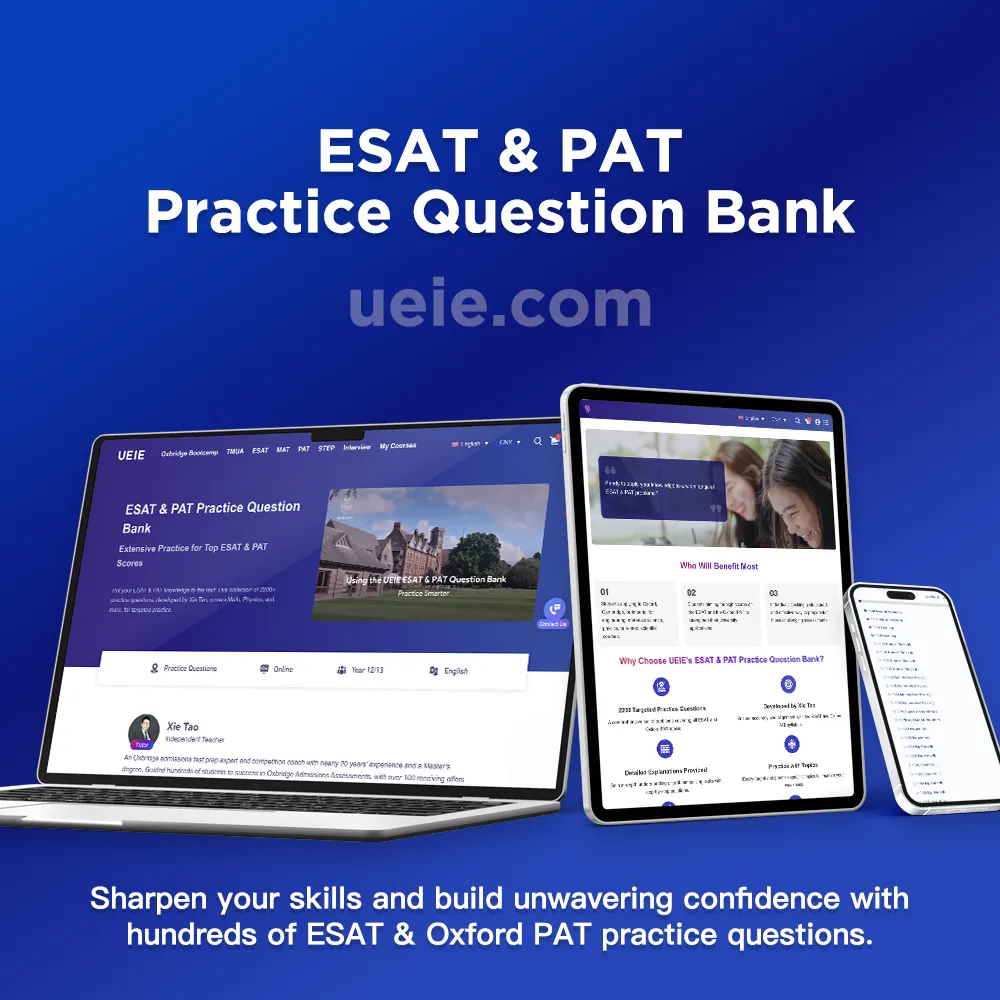
ESAT & PAT Practice Question Bank
Ace the ESAT & Oxford PAT with targeted practice question bank! Our 1600+ practice questions cover all major topics in Maths 1, Maths 2, and Physics. Improve your understanding and master key concepts.US$1 041Original price was: US$1 041.US$872Current price is: US$872.4. Phase 3: Online Simulation and State Adjustment (1-2 Months Before the Exam)
Objective
Comprehensively simulate the real online examination environment, assess overall preparation levels, optimise examination strategies (time allocation, answering pace), identify and rectify weaknesses, and adjust to an optimal examination state.
Actions
- Strict Full-Length Mock Exams: Use the latest official online practice tests (if complete sets are available) or high-quality online full-length mock exam papers, such as UEIE’s Oxford PAT Full-Length Mock Exams, which include 4 original online mock papers, for rigorous simulation.
- Simulation Requirements: Strictly adhere to the 120-minute time limit; complete on a computer; use only the online calculator; ensure a quiet, distraction-free environment. It is recommended to complete at least 3 high-quality mock exams.
- Strategy Rehearsal: In mock exams, practise time allocation (average 3 minutes/question, how to reserve time for checking), strategies for dealing with difficult questions (marking, skipping, guessing), and procedures for the checking phase.
- In-depth Review and Adjustment: After each mock exam, carefully analyse the reasons for incorrect answers, review time allocation, summarise lessons learnt, and address knowledge or skill shortcomings in a targeted manner. Adjust your mindset and build confidence.
Resources
5. Core Recommendations for Selecting Preparation Resources
- Official Resources First: Always prioritise PAT information published by the University of Oxford. Core resources include the PAT syllabus, official online practice tests/sample questions, past papers, official annual reports and preparation advice, and course materials.
- Systematic Support: Consider using systematic PAT preparation resources, such as those provided by UEIE (video courses, Practice Question Bank, full-length mock exams). These materials are based on the many years of teaching experience of expert tutors, integrated and optimised to effectively supplement official resources and improve preparation efficiency.
- Selective Expansion: Based on individual needs, selectively use other high-quality supplementary resources, such as the Isaac Physics website, BPhO Round 1 past papers, etc. Avoid an overabundance of resources, which can dilute focus and energy. Quality over quantity.
- Active Learning: For any resource, engage in active thinking, in-depth review, and summarisation to internalise it into your own abilities.
Resources

ESAT & PAT On-Demand Prep Suite
The ESAT & PAT On-Demand Prep Suite, developed by Xie Tao, is your all-in-one solution for exam success, which includes video lectures covering Maths, Physics, over 1600 practice questions with detailed solutions, and full-length mock exams for ESAT Maths 1, Maths 2, Physics, and the Oxford PAT. Prepare thoroughly and maximise your score.US$612 – US$2 428Price range: US$612 through US$2 428
V. How to Plan Your Oxford PAT Preparation Time?
‘How long does Oxford PAT preparation take?’ This is a question many students are concerned about. The scope of knowledge for the PAT is relatively concentrated, but its demands on physics thinking, mathematical application, and adaptation to the new online multiple-choice format also require ample time for preparation and refinement. Sensible planning is key to success.
1. Core Influencing Factors
The amount of preparation time you need primarily depends on the following factors:
- Target Score: Aiming for top-tier scores (e.g., 75+) usually requires longer and more detailed refinement than reaching the average interview threshold (e.g., 60+).
- Starting Level: Your current foundation in physics and mathematics, and the gap between your core competencies and PAT requirements.
- Available Time: How many hours per week you can consistently dedicate to efficient preparation.
- Learning Efficiency: The speed at which you absorb knowledge and master skills, and the effectiveness of your methods.
2. Recommended Oxford PAT Preparation Periods for Different Starting Points
The following are general recommendations based on common student backgrounds. Please note these are only references; consistent and effective effort is more important than sheer duration:
Students with a Solid Physics/Mathematics Foundation (with experience in mathematics or physics competitions):
- Focus: Adapting to the specific PAT syllabus, online multiple-choice style, time pressure, and the online calculator.
- Recommendation: Begin targeted training approximately 3-4 months before the examination (e.g., start in late June or early July for an October exam).
A-Level Curriculum Students (without competition experience):
- Focus: Consolidating physics and mathematics foundations, engaging in extensive online multiple-choice practice to improve speed, accuracy, and strategy, and fully adapting to the online examination environment.
- Period: It is advisable to start systematic preparation no later than 4-6 months before the examination (e.g., begin in May or early June). You will need to go through a complete cycle of ‘knowledge consolidation → specialised online practice → online mock exam sprint.’
AP/IB Curriculum Students (without competition experience):
- Focus: In addition to the challenges faced by A-Level students, extra time is needed for identifying and addressing knowledge gaps (by comparing with the PAT syllabus). More time may also be required to adapt to the A-Level system’s question style and the online examination mode.
- Period: It is strongly recommended to start earlier, ensuring at least 5-6 months or even longer for preparation (e.g., late April or early May, or even earlier).
Core Tip
Starting early always offers an advantage, allowing for a more composed approach to each preparation phase. The key lies in consistency and learning efficiency.
3. Balancing Preparation with Daily Academic Work: Practical Tips
For students currently in school, efficiently balancing Oxford PAT preparation with coursework is crucial:
- Fixed Schedule: Incorporate PAT test preparation into your weekly study timetable as if it were a formal subject.
- Utilise Holidays: Use weekends and school holidays (especially the summer break) for concentrated knowledge review, tackling difficult areas, or simulation training.
- Focused Efficiency: During allocated PAT study periods, maintain high concentration and strive for efficiency per unit of time.
- Flexible Adjustments: During busy periods such as school examinations or the application season, you can appropriately adjust the intensity of PAT preparation but try to maintain a certain amount of practice to keep your ‘hand in.’ Catch up promptly afterwards.
- Work-Life Balance: PAT preparation is a marathon. Ensure adequate sleep and moderate relaxation to avoid fatigue, which can lead to decreased efficiency and burnout.
VI. Common PAT Preparation Misconceptions and Countermeasures (Under the New Format)
1. Misconception 1: Starting Too Late, Lack of Planning
Manifestation and Consequences
Underestimating the demands of the PAT on physics and mathematics abilities, particularly the time required to adapt to the online multiple-choice format, and only starting to prepare hastily close to the examination. This leads to an unstable foundation, insufficient practice, and an inability to adapt to the examination rhythm.
Countermeasure
Plan early, invest consistently! Recognise that Oxford PAT preparation (especially skill enhancement and adaptation to the new format) requires accumulated time. Refer to the recommendations in Section V, formulate a detailed, phased preparation plan, and ensure consistent, effective study input each week.
2. Misconception 2: Neglecting Online Platform Features, Disconnect Between Practice and Actual Exam
Manifestation and Consequences
Relying mainly on paper-based practice, lacking familiarity with the Pearson VUE online examination platform’s interface and operational methods (such as flagging, navigation), and the use of the online calculator (functionality, speed, precision); not being accustomed to prolonged screen reading and answering.
Countermeasure
- Frequently use official online practice tests: This is the best way to familiarise yourself with the real environment and must be used repeatedly.
- Specific practice with the online calculator: Train this as an independent skill to achieve proficiency, speed, and accuracy.
- Simulate the online environment: Conduct daily practice and mock exams on a computer as much as possible to cultivate screen reading stamina and concentration.
3. Misconception 3: Lack of Effective Multiple-Choice Strategies and Techniques
Manifestation and Consequences
Treating multiple-choice questions as simple knowledge checks, lacking coping techniques; being prone to errors when facing distractors; not differentiating strategies for single-best-answer and multiple-answer questions; poor time allocation, spending too much time on difficult questions or working too slowly (far exceeding the average of 3 minutes per question).
Countermeasure
- Systematically learn techniques (elimination, estimation, extreme cases, dimensional analysis, etc.).
- Undertake extensive timed multiple-choice training to improve speed and accuracy.
- Summarise problem-solving approaches for different types of multiple-choice questions (physics concept discrimination, calculation, comprehensive application).
- Practise time management and trade-off strategies (when to skip, when to guess) in mock exams.
4. Misconception 4: Weak Grasp of Knowledge or Unskilled Application
Manifestation and Consequences
Having a superficial understanding of basic concepts and formulae within the syllabus, relying on rote memorisation; being unable to flexibly apply knowledge to question scenarios, and struggling to find a solution path even for multiple-choice questions.
Countermeasure
- During the initial preparation phase (Phase 1), ensure a solid grasp of fundamental knowledge, understanding physical principles and mathematical methods.
- During practice (Phase 2), do not just check answers; review the problem-solving process, consider how knowledge points are applied, and try to find multiple solutions to a single problem.
5. Misconception 5: Unbalanced Mindset, Improper Stress Management
Manifestation and Consequences
Feeling excessively anxious about the difficulty, time constraints, or online format of the PAT; being prone to mental breakdown and self-doubt when encountering setbacks (such as unsatisfactory mock exam results or inability to solve difficult problems), affecting the continuity of preparation.
Countermeasure
- Set reasonable, achievable goals (refer to Section I).
- Accept that challenges and setbacks are a normal part of preparation; focus on your own progress rather than making blind comparisons.
- Practise thinking under pressure, maintain a moderate level of tension, and avoid excessive anxiety.
- Balance work and rest to ensure the sustainability of your preparation.
6. Misconception 6: Misuse of Resources or Lack of Information
Manifestation and Consequences
Relying on outdated or unsuitable preparation materials for the new format (e.g., only using old paper-based past papers); not paying attention to the latest information released by official sources (such as syllabus updates, sample questions, online test updates); blindly collecting numerous resources without knowing how to use them effectively, leading to dispersed energy.
Countermeasure
- Focus on the latest information and online preparation resources released by the University of Oxford as your core materials.
- Critically use past papers (mainly for content understanding, not format simulation).
- Selectively use high-quality supplementary resources that match the current examination format (such as Isaac Physics, UEIE series materials, etc.).
- Quality over quantity in resources; focus on using core materials deeply and thoroughly.
VII. Final Words: Mindset and Action
By now, you should have a systematic understanding of how to prepare for the PAT test in its new format. As I conclude this guide, allow me to re-emphasise the importance of mindset and outline the key actions for you to take next.
1. Embrace the Challenge: Essential Preparation Mindset
The Oxford PAT preparation journey is inevitably filled with challenges. A strong psychological constitution is a key guarantee for reaching your goal. Please be sure to cultivate the following mindsets:
- Face Setbacks, Build Resilience: Encountering difficult problems, performing poorly in mock exams, or struggling with online operations are all normal occurrences. The key is to view them as opportunities to identify problems, learn lessons, and improve yourself.
- Focus on Deep Work, Maintain Consistent Effort: The improvement of physical intuition and problem-solving skills is not achieved overnight. Ensure high-quality, continuous study input to achieve gradual progress.
- Maintain Equanimity, Balance Mind and Body: Focus on your own progress, learn to manage the additional stress that online examinations may bring, balance work and rest, and ensure the sustainability of the preparation process.
- Find Joy in It, Drive Perseverance: Try to discover the joy in tackling challenging physics and mathematics problems and appreciate their logical beauty. When you can enjoy the process, perseverance will become more natural and enduring.
2. Action Speaks Louder Than Words: Next Step Recommendations
Having clarified your mindset and methods, the next crucial step is to translate cognition into tangible action. I recommend that you:
- Act Immediately: Based on the advice in this guide, refine and execute your preparation plan.
- Utilise Resources Wisely: Use official materials as your core and efficiently leverage selected supplementary resources.
- Practise and Reflect Continuously: Persist with high-quality practice and regularly review, summarise, and adjust.
Finally, please believe in yourself. Thorough preparation and a positive mindset will be your most powerful weapons in tackling the PAT challenge. I wish you success in conquering the PAT through your wisdom and hard work, and in entering the academic institution of your dreams!
-
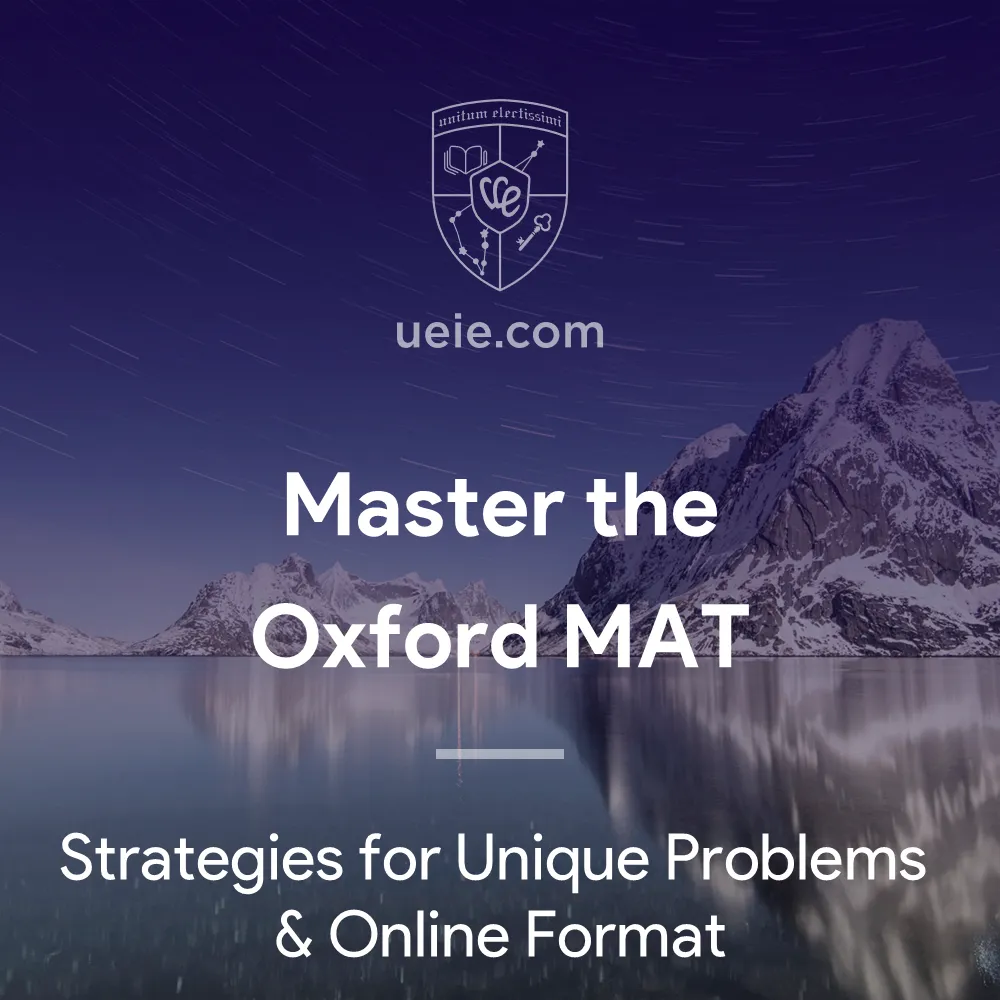
Master the Oxford MAT: Strategies for Unique Problems & Online Format

During the process of preparing for the Oxford MAT, many students may feel bewildered: How can one effectively enhance their ability to tackle the unique question types of the MAT? What is the most efficient way to plan for Oxford MAT preparation? And how should one adapt to the new format of online computer-based testing?
It is hoped that this Oxford MAT Preparation Guide, which encapsulates my (Mr. Xie Tao) many years of experience in coaching for Oxbridge written examinations, can answer these questions for you, whilst also providing a systematic and practical set of preparation strategies, methods, and suggestions.
Before delving into this article, it is strongly recommended that you first familiarise yourself with the latest developments, fundamental requirements, and marking details of the examination by consulting my most recently revised Oxford MAT Comprehensive Guide.
I. Setting Objectives and Adjusting Mindset for Oxford MAT Preparation
To embark on your Oxford MAT preparation journey, you must first clearly define your ‘destination’ and your ‘starting point.’ Scientific objective-setting and positive psychological preparation will lay a solid foundation for your subsequent systematic study.
1. Clarify Objective Requirements
You need to clearly understand the University of Oxford’s expectations regarding MAT scores. Although MAT does not have a fixed “pass mark,” its score is one of the key factors influencing interview shortlisting.
First, meticulously consult Oxford’s official website. Check the latest 2026 admissions requirements for your chosen course.
Secondly, you can refer to Part V, MAT Marking Scheme and Score Interpretation, of my most recently revised Oxford MAT Comprehensive Guide, to understand the approximate competitiveness of different score bands. For instance, knowing the average MAT score of candidates who received interview invitations or final offers (e.g., for 2024 entry to Oxford mathematics-related courses, the average score of admitted students was approximately 77.4 points) will help you comprehend the “level” of your target score.
2. Conduct a Preliminary Self-Assessment
Before formally commencing systematic preparation, undertaking a Diagnostic Exam (a ‘baseline assessment’) is crucial. This will help you to:
- Experience the Difficulty and Format: Personally experience the style, thinking requirements, and online examination environment of MAT questions (particularly the multiple-choice and short-answer questions under the new format).
- Understand Your Current Standing: Preliminarily assess your current mathematical proficiency and core competencies in relation to the MAT’s requirements.
3. How to Conduct a Diagnostic Exam?
Choosing Assessment Tools
Although the 2024 MAT reforms have led to significant changes in question types, the scores from mock examinations using official MAT past papers from earlier years (e.g., three years prior) can still serve as a reference to some extent.
A more recommended approach: To help you conduct a more precise and comprehensive self-assessment, I (Mr. Xie Tao), based on many years of research into the MAT examination, have developed a specialised Free Oxford MAT Diagnostic Exam (online computer-based). This examination highly simulates the latest MAT paper format and difficulty, aiming to more effectively assess the core knowledge and abilities required for the MAT. Click the link below to learn more about this Diagnostic Exam and attempt it online.
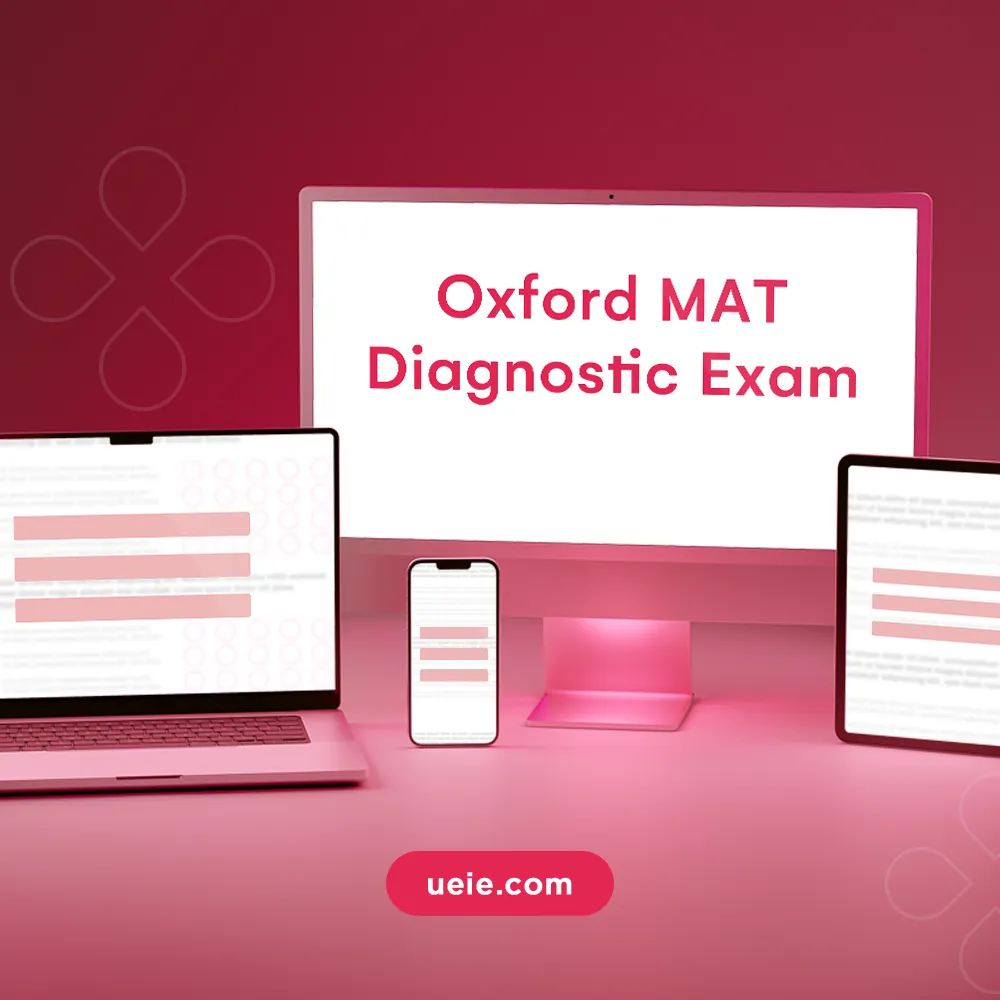
Free Oxford MAT Diagnostic Exam
Prepare for Oxford’s rigorous math admissions? This free Oxford MAT diagnostic helps you assess your understanding of core mathematical concepts. Get expert feedback from UEIE’s tutors and increase your chances of success.Suggested Operational Steps
- Environment: Regardless of the paper used, strictly simulate the real examination environment (online computer-based or a quiet paper-based setting) and complete it independently.
- Timing: Strictly adhere to the 150-minute time limit.
- Marking: Refer to the official marking scheme or the provided reference answers and marking suggestions for the Diagnostic Exam for an objective assessment.
- Interpretation of Results: The baseline score is merely a starting point, intended to identify gaps rather than predict the final outcome. What is important is to analyse the reasons for errors and identify areas of weakness. Retain your answer script and analysis for subsequent progress tracking.
4. Setting Scientific MAT Score Objectives
Combining your objective requirements and self-assessment results, you need to set a scientific and reasonable preparation objective. It is advisable to follow the SMART principles:
- Specific: Clearly define the score range you aim to achieve (e.g., target 75 points or above, or strive for 80 points).
- Measurable: The objective should be quantifiable through subsequent mock test scores.
- Achievable: Based on your starting point, available time, and level of effort, the objective should be attainable, avoiding unrealistic expectations.
- Relevant: The objective should be closely related to your ultimate goal of applying to the University of Oxford.
- Time-bound: Clearly define the timeline for achieving the objective (i.e., the official examination date).
Balancing Ambition and Reality
Objectives should be challenging enough to stimulate potential but also realistic. For instance, if your aim is to secure an interview invitation, setting a target in the 70-75 point range might be more practicable than directly aiming for 90 points (this depends on individual circumstances). Dynamic adjustment of objectives based on preparation progress is also necessary.
5. Adjusting Mindset: Embracing the MAT Preparation Challenge
Oxford MAT preparation is no easy feat; it tests not only mathematical knowledge but also mental resilience and problem-solving abilities. It is imperative to cultivate the following mindset:
- Confront Challenges Head-on: Recognise the depth and novelty of MAT questions, viewing them as opportunities to enhance your thinking skills.
- Accept Setbacks: Encountering difficult problems and performing poorly in mock examinations are normal. The key is to analyse the reasons and learn from them, rather than engaging in self-denial.
- Focus on the Process: Concentrate on understanding concepts, improving abilities, and mastering methods; enjoy the process of problem-solving.
- Maintain Patience and Perseverance: Improving MAT abilities takes time and sustained effort; trust in the power of accumulation.
II. Knowledge Base Required for Oxford MAT Preparation
‘Know thyself and know thy enemy, and you will never be defeated.’ Accurately grasping the knowledge requirements of the MAT is the first step in formulating an effective preparation strategy.
1. Scope of Knowledge in the MAT Syllabus: Seemingly Basic, Yet Profound
Core Content: The MAT syllabus is primarily based on the Pure Mathematics component of A-Level Mathematics (excluding Further Mathematics). This means that, from a list of topics, it might appear ‘narrower’ than you imagine.
Depth Challenge: However, do not be deceived by the syllabus’s conciseness! The MAT is not designed to test simple recall of knowledge points. Instead, it uses this relatively basic knowledge as a vehicle to delve deeply into your mathematical understanding, the rigour of your logical reasoning, and your ability to solve problems in novel contexts. This demands a profound understanding and flexible application of the topics covered in the syllabus.
2. A-Level Further Mathematics: An Added Bonus, Beneficial in the Long Run
The MAT syllabus does not include A-Level Further Mathematics content, and solving MAT questions does not require knowledge of Further Mathematics. This is to ensure fairness to students who have not studied Further Mathematics.
Nevertheless, I still recommend that students with the capacity to do so study Further Mathematics. This is because it can:
- Elevate Thinking Levels: Significantly broaden mathematical horizons, deepen understanding of abstract concepts, and cultivate higher-order mathematical thinking skills, which are extremely helpful for solving challenging MAT problems.
- Lay the Groundwork for Subsequent Stages: A background in Further Mathematics is almost an ‘implicit requirement’ for Oxford interviews and is an essential foundation for university-level study in mathematics or computer science.
3. Mathematical Competitions: Shared Thinking, Added Experience
Stylistic Correlation: In recent years, MAT questions, in terms of problem design and solution approaches, indeed share similarities with many mathematical competition problems, particularly in their assessment of logical reasoning, number theory fundamentals, combinatorial thinking, and recursive methods.
The Value of Experience: Consequently, students with training backgrounds in relevant mathematical competitions (such as BMO, AIME, etc.) may find it easier to identify solution paths for some MAT questions, giving them a certain advantage.
Not a Mandatory Prerequisite: However, please note that competitions are by no means a prerequisite. The core of the MAT remains the flexible application of knowledge within the syllabus. For students without a competition background, the focus of preparation should be on thoroughly understanding the syllabus and enhancing core abilities. Simultaneously, consciously engaging with some basic competition-style problems during preparation can help broaden perspectives and improve problem-solving flexibility.
4. Bridging Different Curricular Systems: Identifying Gaps, Adjusting Focus
For students studying under non-A-Level systems such as AP or IB, a dual bridging of knowledge and abilities is necessary:
Knowledge Level
- AP Students: Calculus knowledge (especially BC) is well-covered, but in other A-Level specific topics or areas with different emphasis, such as algebra, coordinate geometry, and trigonometry, a careful check against the MAT syllabus and supplementary study are required.
- IB Students: While HL Mathematics (AA/AI) content is broad, there are differences in the depth of certain specific topics (e.g., some proof techniques, number theory fundamentals) and the intensity of training in basic computational skills compared to MAT requirements.
Ability Level
- Computational Skills: Regardless of the system, it is necessary to strengthen mental arithmetic and written calculation speed and accuracy in a non-calculator environment.
- Thinking Style: Adapt to the MAT’s unique problem style, which emphasises deep thinking, logical rigour, and creativity.
III. Core Competencies Essential for High MAT Scores
Mastering the knowledge required for the MAT is fundamental, but to excel in the examination, it is also necessary to hone the following core mathematical competencies, which are highly relevant to its unique assessment methods (especially the combination of online multiple-choice and short-answer questions).
1. Precise and Efficient Computational Ability
- Core Requirement: Calculators are not permitted at any point during the MAT. This places extremely high demands on computational ability – not only accuracy but also rapid completion within limited time. Precise calculation is the foundation for scoring, whether for quick solutions in multiple-choice questions or step-by-step derivations in short-answer questions.
- Common Challenge: Particularly for students from international curricula (A-Level/AP/IB) accustomed to relying on calculators, the speed and accuracy of basic computation are often weaknesses. In the MAT, any calculation error can directly lead to lost marks (especially as there are no partial marks for working in multiple-choice questions).
- Key Improvement Points: Specific training is essential to reinforce mental and written arithmetic techniques. Proficiency in common algebraic manipulations, function evaluation, calculus operations, etc., should be developed to the point of ‘reflex action.’ It is imperative to cultivate the habit of careful checking and verification.
2. Rigorous and Profound Logical Reasoning
- Core Requirement: The MAT places extreme importance on logical rigour. You need to be able to accurately understand the question, grasp the premises, carry out watertight reasoning, and clearly construct a chain of argument. This is evident not only in the proofs for short-answer questions but also throughout the analysis and elimination process for multiple-choice questions.
- Common Challenge: Many students lack systematic logical training and are prone to skipping steps in reasoning, confusing concepts, or failing to consider all cases (e.g., omitting scenarios in case-by-case analysis).
- Key Improvement Points: A thorough command of basic proof methods (direct proof, proof by contradiction, induction, etc.) and the precise meaning of logical connectives is required. Consciously train the rigour of your thinking, ensuring every step of a derivation is well-founded. Engage in more logical discrimination and ‘fault-finding’ exercises to enhance logical sensitivity.
3. Flexibility, Adaptability, and Problem-Solving
- Core Requirement: The charm and difficulty of the MAT often lie in its requirement to apply familiar knowledge to novel and unfamiliar situations. You need the ability to quickly understand the essence of a problem, break free from fixed mindsets, flexibly choose and combine methods, and think about problems from different angles.
- Common Challenge: Students often get stuck when faced with unseen question types or phrasing, or they can only solve problems using fixed ‘routines.’
- Key Improvement Points: When solving problems, do not be satisfied with finding just one solution; consider whether there are better or different solutions. Summarise the core idea and key breakthrough points of the problem. Focus on analysing the connections and progressions between different parts of a question. Broaden your horizons by practising a variety of problems from different sources and styles (including some competition questions) to improve mental flexibility.
4. Multiple-Choice Question Strategies and Techniques
- Core Requirement: The MAT includes as many as 25 multiple-choice questions, accounting for a high proportion of the total marks (70 marks). Mastering test-taking strategies to maximise scores on multiple-choice questions within the limited time is crucial.
- Common Challenge: Poor time allocation; easily falling into calculation traps or being misled by distractor options; lack of effective techniques for rapid problem-solving or verification.
- Key Improvement Points
- Master Techniques: Systematically learn and deliberately practise common multiple-choice techniques such as elimination, substitution of special values, analysis of extreme cases, working backwards from options, estimation, and dimensional analysis.
- Quick Judgement: Practise quickly judging the difficulty of a question and the time required, deciding whether to solve it directly, apply techniques, or temporarily skip it.
- Accuracy First: Even when pursuing speed, ensure the accuracy of calculations and logic to avoid elementary mistakes.
- Strategic Guessing: When time is extremely tight or you have no idea, learn to make educated guesses (e.g., random selection after eliminating obviously incorrect options) rather than leaving answers blank.
5. Short-Answer Question Responses and Presentation
- Core Requirement: The 2 short-answer questions (totalling 30 marks) require clear presentation of the solution process and result. Although typed on a keyboard, logical clarity, complete steps, and rigorous argumentation are still required. A clear solution process is key to obtaining partial marks.
- Common Challenge: Non-standard mathematical presentation, logical leaps, lack of necessary textual explanations or supporting reasons, difficulty adapting to typing mathematical symbols and expressions using a keyboard.
- Key Improvement Points
- Standardised Expression: Even when typing, use standard mathematical symbols, clearly define variables, and maintain a logical hierarchy in solution steps.
- Explanation of Key Steps: Provide concise textual explanations for crucial reasoning steps or when using important theorems.
- Complete Presentation: Ensure the argumentation process is complete and the conclusion is clear.
- Adapt to Online Input: Practise and familiarise yourself with typing mathematical formulae and symbols on a computer beforehand (the official online practice test platform can be used). Emulate the layout and presentation style of official solutions.
IV. Core Oxford MAT Preparation Strategies and Resource Utilisation
Clear strategies and the effective use of resources are key to efficient MAT test preparation. This requires a systematic process that is phased and has specific focuses.
1. Core Principles: Understanding as the Foundation, Practice for Application, Adaptation to Computer-Based Testing
- Profound Understanding is a Prerequisite: Unlike many standardised tests, the MAT cannot be easily conquered through ‘rote practice.’ The questions highly assess the depth and flexibility of mathematical thinking; blindly doing problems without seeking thorough understanding often yields little result. The core of preparation should lie in establishing a profound understanding of the mathematical concepts and methods within the syllabus.
- High-Quality Practice is Key: Building on understanding, it is necessary to apply and consolidate knowledge, enhance problem-solving techniques and speed, and convert understanding into scoring ability through a large volume of high-quality practice (especially official past papers).
- Adaptation to Online Format: Preparation must specifically target the characteristics of online computer-based testing, including familiarising oneself with the interface, practising keyboard input for mathematical answers, and developing the ability to read and think about mathematical problems on a screen.
2. Phase One: Knowledge Organisation and Foundational Consolidation (Early Preparation)
Objective
Systematically review the topics covered in the MAT syllabus, ensuring no blind spots, and achieve a profound understanding of core concepts. Simultaneously, enhance the accuracy and speed of basic computations.
Actions
- Review each knowledge module (algebra, geometry, calculus, etc.) one by one, referencing the latest official syllabus.
- Relearn or consolidate foundational concepts, theorems, and methods using A-Level textbooks or other reliable resources.
- Undertake extensive practice of basic computations and typical example problems, particularly in a non-calculator environment.
- Resource Utilisation: Official MAT syllabus, A-Level textbooks, MEI resources, UEIE’s Oxford MAT Video Lecture Series (for systematic review and focused explanations).
Resources
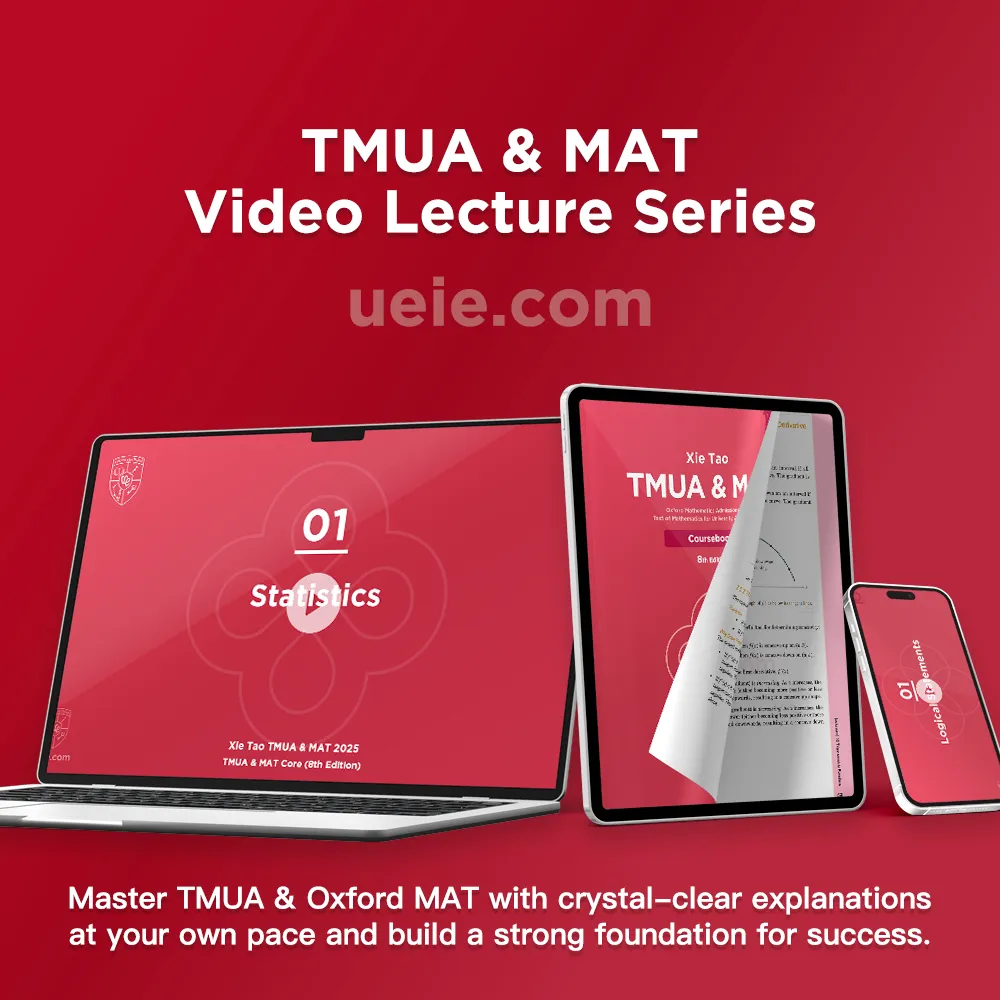
TMUA & MAT Video Lecture Series
Gain a competitive edge with our TMUA & MAT Video Lecture Series. Covering all topics of both exams, these courses offer a comprehensive curriculum, expert instruction from Xie Tao, and the flexibility of on-demand learning.US$713 – US$856Price range: US$713 through US$856
3. Phase Two: Specialised Training and Ability Enhancement (Mid-Preparation)
Objective
Adapt to the MAT’s unique question styles and thinking requirements, and specifically enhance core abilities, particularly problem-solving, logical reasoning, multiple-choice strategies, and short-answer question response skills.
Actions
- In-depth Study of Past Papers: Systematically practise official past papers from previous years, ensuring thorough understanding of each question. Focus on analysing solution approaches, multiple solution methods, common misconceptions, and time allocation.
- Targeted Breakthroughs: Conduct concentrated training for multiple-choice questions (practising various techniques) and short-answer questions (practising articulation of thought and keyboard input). UEIE’s Oxford MAT Practice Question Bank (online) can be used for specialised practice and to gradually adapt to the online answering format.
- Broaden Thinking: Appropriately engage with high-quality mathematical problems similar in style to the MAT (such as some competition question resources) to exercise mental flexibility.
- In-depth Review: Completing questions and checking answers is not the end; analysing errors, summarising effective methods, and considering better solutions are key to improvement.
- Resource Utilisation: Official past papers and solutions, UEIE’s Oxford MAT Practice Question Bank, Underground Mathematics, etc.
Resources
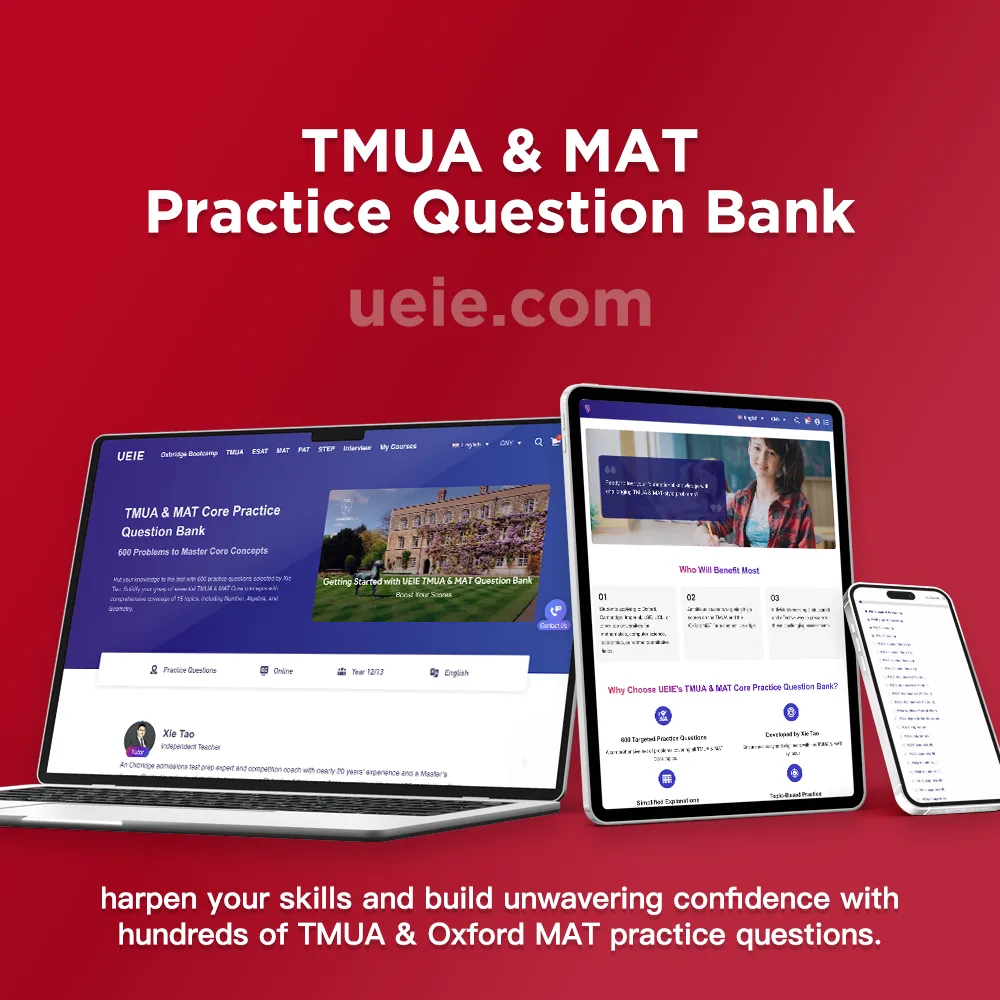
TMUA & MAT Practice Question Bank
Our TMUA & Oxford MAT Practice Question Bank, developed br Xie Tao, offer 1360 problems with detailed solutions, covering all topics of the exams.These questions provide targeted practice for all levels to help you master every topic and achieve your target score.US$670Original price was: US$670.US$558Current price is: US$558.4. Phase Three: Online Simulation and State Adjustment (1-2 Months Before the Exam)
Objective
Fully simulate the examination environment, assess overall proficiency, optimise test-taking strategies (time management, pacing), adjust to the optimal examination state, and address any remaining weaknesses.
Actions
- Rigorous Simulation: Use the Pearson VUE online practice test and UEIE’s Oxford MAT Full-Length Mock Exams (including 4 original mock papers), strictly adhering to the examination time (150 minutes), online environment, and no auxiliary tools. It is recommended to undertake at least 3 high-quality mock examinations.
- Strategy Rehearsal: Practise time allocation strategies during mock examinations, and practise responses to difficult questions (whether to skip or attempt).
- Addressing Weaknesses: Address any knowledge gaps or ability shortcomings exposed by mock examinations in the final stage of targeted revision.
- Mindset Adjustment: Adapt to examination pressure, build self-confidence, and maintain a calm state of mind.
- Resource Utilisation: Official online practice tests, UEIE’s Oxford MAT Full-Length Mock Exams, and official past papers from the most recent years.
Resources
5. Integrated Utilisation of Preparation Resources
- Official Resources as the Core: Always treat the MAT syllabus, past papers, solutions, feedback reports, and preparation advice published by the University of Oxford as the ‘bible’ for MAT test preparation.
- Systematic Support: Consider utilising systematic Oxford MAT preparation resources provided by organisations such as UEIE (video lecture series, practice question bank, full-length mock exams). These materials, consolidated and optimised by a team of expert teachers based on years of teaching experience, can effectively supplement official resources and improve preparation efficiency.
- Selective Expansion: Based on individual needs, selectively use other high-quality supplementary resources (such as Underground Maths), but avoid an overabundance of materials, which can dilute focus. Quality over quantity is key.
- Active Learning: Regardless of the resource, active thinking, in-depth review, summarisation, and internalisation are necessary to transform them into one’s own abilities.
Resources

TMUA & MAT On-Demand Prep Suite
The TMUA & MAT On-Demand Prep Suite is your all-in-one solution for exam success. This comprehensive package combines Xie Tao’s expert video lectures, a massive bank of 1360 practice questions with detailed solutions, and 12 full-length mock exams that mirror the real test. Prepare thoroughly, build confidence, and achieve your target score.US$1 284 – US$1 856Price range: US$1 284 through US$1 856
V. How to Plan Your MAT Preparation Time?
The amount of time required for Oxford MAT preparation varies from person to person, but reasonable planning is crucial for success.
1. Key Influencing Factors
The main factors determining your required preparation time include:
- Target Score: Aiming for top-tier scores (e.g., 80+) typically requires longer and more detailed refinement than achieving the average interview threshold (e.g., 70+).
- Starting Level: The gap between your current mathematical foundation, core abilities, and MAT requirements.
- Available Time: How many hours per week you can consistently dedicate to efficient preparation.
- Learning Efficiency: The speed at which you absorb knowledge and master skills, and the effectiveness of your methods.
2. Recommended Preparation Periods for Different Starting Points
The following are general recommendations based on common student backgrounds; please use them flexibly:
Solid STEP Preparation Experience
- Focus: Adapting to MAT question types, online format, supplementing specific topics.
- Recommendation: 2-3 months of targeted training before the exam (e.g., during the summer holidays in July-August).
With No STEP Experience but a Good Competition Foundation
- Focus: Systematically reviewing the syllabus, applying competition-style thinking, adapting to the online format.
- Recommendation: Begin systematic preparation 3-4 months before the exam (e.g., June-July).
Without Competition/STEP Experience, A-Level System:
- Focus: Comprehensive systematic learning and extensive practice, enhancing depth of thought and test-taking abilities.
- Recommendation: Begin 4-6 months before the exam (e.g., May-June).
No Competition/STEP Experience, AP/IB System:
- Focus: In addition to the above challenges, extra time is needed to bridge knowledge gaps and transfer abilities (especially non-calculator computation).
- Recommendation: Start as early as possible, at least 4-6 months or longer (e.g., early May).
Core Advice
The key is sustained, effective effort, and dynamically adjusting your plan based on your progress.
3. Balancing Preparation with Daily Academic Work
For students currently in school, effective balancing is key:
- Incorporate into Schedule: Formally include MAT preparation in your weekly study plan.
- Utilise Holidays: Use school holidays for intensive study and breakthroughs.
- Focus on Efficiency: Improve the efficiency and concentration of your study periods.
- Flexible Adjustment: During academically demanding periods, appropriately adjust the intensity of MAT preparation but maintain continuity.
- Work-Rest Balance: Ensure adequate rest, avoid fatigue, and ensure the sustainability of your preparation.
VI. Common Preparation Misconceptions and Countermeasures
Over many years of MAT coaching and observation, I have identified some common preparation misconceptions that can severely impact efficiency and final scores. Actively recognising and avoiding them can make your efforts significantly more fruitful.
1. Misconception One: Starting Too Late, Lack of Planning
Manifestation and Consequences
Underestimating the MAT’s demands on depth of thought and flexibility, believing that last-minute cramming will suffice; starting preparation only when the exam is imminent, leading to a severe lack of time for systematic learning, sufficient practice, and necessary simulations.
Countermeasure
Plan early, persevere long-term! Recognise that improving MAT abilities requires accumulated time. Develop a detailed, phased preparation plan in advance, and ensure sustained, effective effort each week.
2. Misconception Two: Flawed Methods, Neglecting Understanding or New Format Features
Manifestation and Consequences
- Prioritising ‘Rote Practice’ Over Understanding: Becoming engrossed in mechanically working through past papers, aiming to have ‘seen’ question types, while neglecting a profound understanding and flexible application of basic concepts and theorems, leading to an inability to tackle novel questions.
- Ignoring New Format Skills: Failing to specifically train strategies and techniques for multiple-choice questions, or neglecting the expression and presentation requirements for short-answer questions in an online format, resulting in lost marks in these sections.
Countermeasure
Understanding as the foundation, skills as a priority! Return to the core principles of preparation, focusing on conceptual understanding and thinking training; deliberately practise multiple-choice strategies and short-answer responses as distinct skills; aim for quality over quantity in practice, emphasising in-depth review and summarisation.
3. Misconception Three: Lack of Online Simulation and Practical Drills
Manifestation and Consequences
Primarily using paper and pen for practice, being unfamiliar with the operation of the online examination platform and answering methods (especially keyboard input for short-answer questions); lacking complete mock examinations under strict time limits, leading to chaotic time management, unfamiliarity with operations, and nervousness in the examination hall.
Countermeasure
Embrace online practical application! In the middle and later stages of preparation, rigorous online timed mock examinations simulating the real examination environment are essential. Make full use of official online practice tests and UEIE’s full-length mock examination resources, practising not only the questions but also familiarity with the interface, time management, and examination hall strategies.
4. Misconception Four: Unbalanced Mindset, Anxiety or Complacency
Manifestation and Consequences
- Excessive Anxiety: Feeling overly worried about the MAT’s difficulty or target scores; a tendency for one’s mindset to collapse when encountering setbacks, affecting learning efficiency and examination performance.
- Cognitive Bias / Complacency: Believing that a narrow MAT syllabus equates to simplicity, neglecting its demands on depth of thought; or being blindly self-confident, not paying attention to fundamentals and details.
Countermeasure
Scientific positioning, active adjustment! Set reasonable and achievable goals; accept that challenges and setbacks are normal; focus on your own progress rather than blindly comparing yourself with others; maintain a moderate level of alertness but avoid excessive pressure; balance work and rest, and maintain a positive mindset.
5. Misconception Five: Misuse of Resources, Outdated Information or Striving for Too Much
Manifestation and Consequences
Relying on outdated preparation materials or experiences (which do not reflect the latest examination format); not carefully studying the latest official syllabus and instructions; blindly collecting a large number of resources without knowing how to use them effectively, leading to dispersed effort and low efficiency.
Countermeasure
Select resources carefully, follow official guidance! Use the latest information and resources published by the University of Oxford as the core; selectively use high-quality supplementary resources that match the current examination format (such as UEIE’s systematic materials); quality over quantity is key – focus on and thoroughly utilise the core materials at hand.
VII. Final Admonitions: Mindset and Action
At this point, we have comprehensively reviewed all the key stages of Oxford MAT preparation. Please remember that successful preparation depends not only on understanding strategies and methods but also on strong internal motivation and tangible action.
1. Maintain a Positive Mindset
MAT preparation is bound to be challenging. It is imperative to:
- Embrace the Process: View difficult problems encountered as valuable opportunities to exercise your thinking and improve yourself.
- Maintain Resilience: Do not be discouraged by setbacks; analyse, reflect, and adjust promptly.
- Focus on Progress: Concentrate on deepening knowledge and enhancing abilities, rather than on temporary high or low scores.
2. Put Plans into Action
The blueprint has been drawn; execution is key:
- Act Immediately: Based on the advice in this guide, refine and implement your preparation plan.
- Utilise Resources Wisely: Use official materials as the core, and efficiently utilise selected supplementary resources.
- Continuous Practice and Reflection: Persist with high-quality practice, and periodically review, summarise, and adjust.
Believe in yourself, and face the challenge with composure. Thorough preparation and a positive mindset will be your most powerful weapons in tackling the MAT. I wish you success in your preparation and ultimately in achieving your desired outcome in your application to the University of Oxford!
-

Oxford PAT Uncovered: Policy, Syllabus & Key Focus Areas
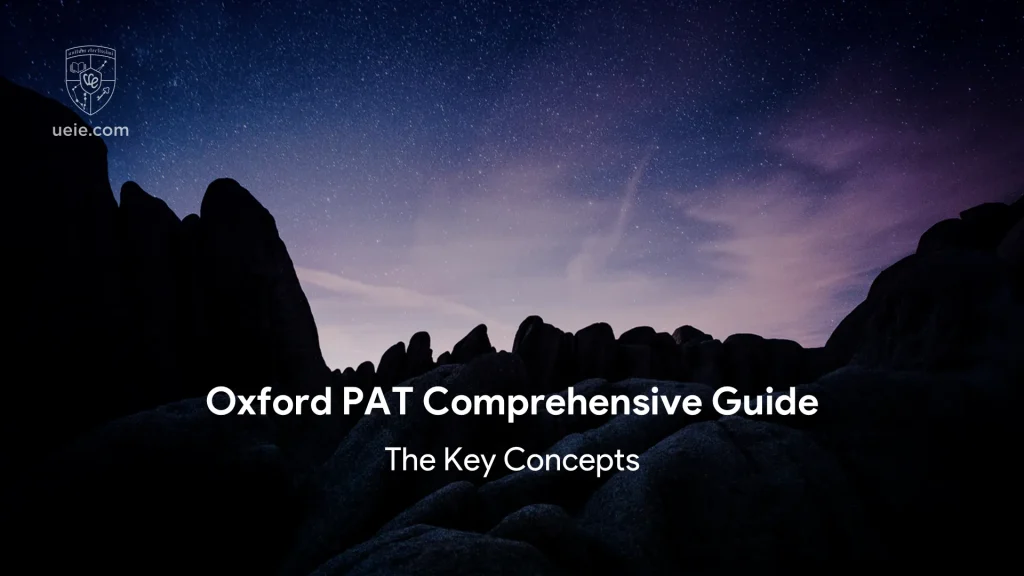
The Oxford PAT Test (Physics Aptitude Test) is a crucial entrance examination used by the University of Oxford to assess the overall physics and mathematical ability of undergraduate applicants for its Physics, Engineering Science, and Materials Science programmes. It focuses on evaluating candidates’ ability to solve problems using physics principles and mathematical tools. For students targeting these programmes, a thorough understanding of the Oxford PAT (especially its latest online format) requirements, content, and assessment methods is vital. To help those planning to apply for 2026 entry accurately grasp the latest exam situation, this article will provide a comprehensive and authoritative interpretation.
After gaining a detailed understanding of the Oxford PAT overview, it is recommended to continue reading my (Mr. Xie Tao’s) series of articles: Oxford PAT Preparation Guide and Oxford PAT Registration Guide, for detailed preparation strategies and registration guidance.
I. Latest Updates on Oxford PAT Test
The PAT test has undergone significant adjustments in recent years. Understanding these core changes, which have been implemented and will continue for the 2025 examination cycle (for 2026 entry), is crucial for preparation.
1. Oxford PAT Test Organisation and Implementation
From 2024 onwards, the University of Oxford has appointed Pearson VUE as the global implementing body for the PAT and other entrance examinations, responsible for test centre arrangements and online testing. However, the examination papers are still set by the Oxford University Physics Department, ensuring the authority and continuity of the exam content and assessment standards.
2. Key Changes
- Fully Online Computer-Based Test: The PAT test has completely transitioned to an online format, conducted at Pearson VUE certified test centres, no longer using paper scripts.
- Question Type Adjustments: All examination questions are now multiple-choice. According to the 2024 papers and official sample questions, this includes both Single Choice and Multiple Choice/Multiple Response formats. The number of questions has also increased to 40.
- Scoring Method: The total mark for the entire paper remains 100, but the 40 multiple-choice questions have unequal values (possibly 2, 3, or 4 marks).
- Calculator: The test system will include an online digital calculator. Candidates must use this online calculator, and bringing or using any personal calculator is strictly prohibited.
II. Who Needs to Take the PAT Test? (For 2026 Entry)
The Oxford PAT is a mandatory entrance examination for applicants to the following specific undergraduate (or integrated Master’s) programmes at the University of Oxford, It must be taken and typically cannot be substituted with other examinations:
Courses UCAS Code Engineering Science H100 Biomedical Engineering H811 Chemical Engineering H800 Civil Engineering H200 Electrical Engineering H620 Information Engineering H630 Mechanical Engineering H300 Materials Science FJ22 Physics F303 Physics and Philosophy VF53 III. Oxford PAT Key Dates
Event Date / Timeframe Notes / Reminders Registration Time 18 June to 19 September 2025 Requires creating an account via the Oxford official website. Test Slot Registration 18 August to 26 September 2025 Must complete Pearson VUE test slot booking before this date. Test Dates 22 October 2025 (Wednesday) and 23 October 2025 (Thursday) Choose a specific test session in the Pearson VUE system. Interview Invites November to December 2025 Sent via email after the University of Oxford completes initial screening. Results Access January 2026 Issued to candidates via the examination registration platform (or email). Important Note: All dates (especially the specific start and end times for registration) are subject to change. Please regularly visit the Oxford PAT page on the University of Oxford Admissions website and the Oxford Admissions Testing page on Pearson VUE’s website for the most authoritative official information.
IV. PAT Test Format and Structure
Since 2024, the Oxford PAT test has adopted a new online format and question structure.
Item Details Test Mode Online Computer-based Test Test Location Global Pearson VUE Certified Test Centres Duration 2 hours (120 minutes) Questions 40 multiple-choice questions (including Single Choice and Multiple Choice) Calculator On-screen calculator provided, no personal calculators allowed Formula Sheet Not Permitted Dictionary Not Permitted Key Points of Interpretation:
- Pure Multiple-Choice Format: This is the biggest change. Preparation strategies need to focus more on techniques for solving multiple-choice questions, the ability to quickly judge and differentiate between distractors, as there are no marks for showing working. The coexistence of single and multiple-choice questions adds complexity.
- Online Computer-Based Test and Calculator: Candidates must adapt to the online testing environment and become proficient in using the online calculator provided by the system. They cannot rely on their familiar personal calculators.
- Time Pressure: Completing 40 physics and mathematics multiple-choice questions in 2 hours means an average of only 3 minutes per question, requiring high speed and efficiency in problem-solving.
- Knowledge and Memory: Formula sheets are not allowed, meaning candidates need to firmly memorise all relevant formulas and physical constants within the syllabus.
V. Oxford PAT Scoring Mechanism and Score Interpretation
Understanding how the Oxford PAT test is scored and what the scores represent is crucial for evaluating your competitiveness and setting preparation goals.
1. Scoring Method
- Total Score and Composition: The maximum score for the PAT is 100. The score is entirely derived from the 40 multiple-choice questions (including single and multiple-choice).
- Question Values: The value of each multiple-choice question is not equal and may be weighted differently based on difficulty or other factors (e.g., possibly 2, 3, or 4 marks).
- Scoring Characteristics: Incorrect answers do not incur penalties, encouraging candidates to attempt all questions. The final score is the sum of the marks for correct answers.
2. Score Report
- Internal Use: Oxford University admissions tutors receive all applicants’ PAT scores directly in November, which are used in conjunction with other application materials (such as the cGCSE mentioned below) for interview shortlisting.
- Candidate Access: Candidates can usually only access their specific PAT scores through the examination registration platform after receiving their final application result from the University of Oxford in January of the following year (i.e., January 2026).
3. Score Interpretation and Competitiveness Analysis
Understanding the relative competitiveness of PAT scores is very important, but please note that Oxford University does not set fixed ‘interview score cut-offs’ or ‘admission score cut-offs’. Admission decisions are always based on a comprehensive assessment of all aspects of an applicant’s materials.
Application of R-Score
In recent years (including the 2024 application cycle), the Oxford Physics Department has primarily used the R-score for interview shortlisting. This score combines the PAT score with a contextualised GCSE score indicator called cGCSE:
R-score before interview (%) = PAT score (%) + 10 x cGCSE
Here, cGCSE is a standardised score that measures a student’s GCSE (or IGCSE) performance relative to the context of their school, typically ranging from -3 to +3. Applicants lacking GCSE information (such as some international students) are assigned a neutral score of 0.
Note: There was a subtle but important change in calculating the R-score in 2024: all negative cGCSE scores were ignored in the calculation. This was undoubtedly a significant advantage for students who did not achieve enough A* (8/9) grades in their GCSE or IGCSE subjects.
Interview Shortlisting Threshold
The interview shortlisting threshold varies each year. The blue line in the diagram below represents the interview shortlisting threshold from 2006-2024. For example, applicants with an R-score of 70% or higher in 2024 were automatically included in the interview shortlist. Some candidates with an R-score slightly below this threshold might also be invited for an interview if they had other outstanding background information or special circumstances (including technical issues encountered during the exam).
PAT Score Competitiveness Analysis
- Average Level: The average PAT score for all applicants in the 2024 examination was approximately 49.6% (significantly lower than the 55.6% in 2023). This may be related to the difficulty of the questions in that year, the first time a fully new format was adopted, or disruptive factors during the examination.
- More Competitive: A PAT score of generally above 65% is considered to significantly increase the chances of being invited for an interview.
- Strongly Competitive: A score of 75% or higher is considered a highly competitive score.
- Lower Scores: Scores below 65% generally make it more difficult to secure an interview, unless there are very strong other application highlights or supporting background factors.
Note that since 2024 was the first year the pure multiple-choice online format was used, and the report for that year mentioned disruptive factors, direct comparison with scores from previous years should be done with caution.
After the interview, the final R-score after the interview is calculated based on the PAT score, cGCSE score, and interview score:
R-score after interview = PAT score (%) + 10 x cGCSE + 2 x interview score (%)
Final Admission
The R-score after the interview, calculated through a series of weighted calculations, carries significant weight in the admission decision. However, it is not the only factor influencing the outcome. The Oxford Physics Department will also comprehensively consider other materials such as recommendation letters and personal statements before making the final decision on whether to admit a candidate.
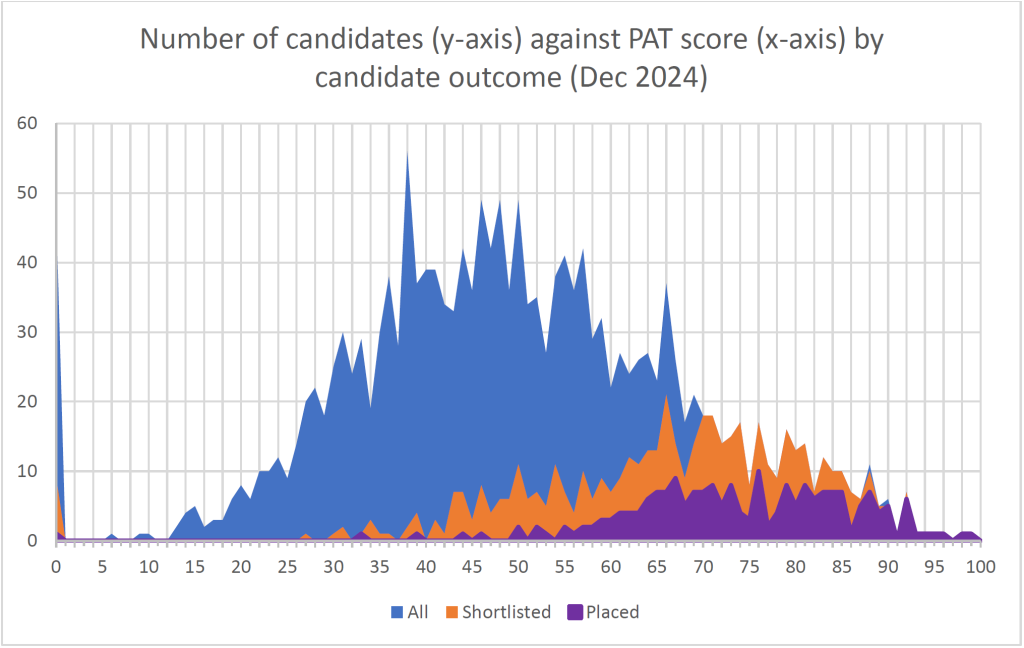
Distribution of PAT Scores and the Number of Admitted Students Published by the Oxford Physics Department in 2024
VI. PAT Test Syllabus and Difficulty Analysis
Accurately understanding the scope and difficulty characteristics of the Oxford PAT is fundamental to developing an effective preparation plan.
1. Syllabus Scope and Version
- Knowledge Base: The PAT syllabus covers the core knowledge points of A-Level Mathematics and AS Physics, as well as some A2 Physics. It is particularly important to note that the syllabus explicitly does not include content from A-Level Further Mathematics.
- Syllabus Version: The current PAT test syllabus is still based on the version revised in 2018. Although the test format has changed, the scope of knowledge remains essentially the same.
2. Syllabus Characteristics
- Concise but In-depth: The official PAT syllabus is very condensed, with the entire content being less than 2 pages of A4 paper. Its design philosophy is not to pursue breadth of knowledge, but rather to deeply examine students’ depth of understanding and ability to apply core physics principles and mathematical tools based on the common foundation of high school curricula in various countries.
- Physics and Mathematics Integration: Questions often tightly integrate physics scenarios with mathematical methods, assessing the ability to apply knowledge comprehensively to solve problems.
3. Knowledge Point Overview
According to the official syllabus, the main areas of examination include:
Mathematics Section
- Basic Mathematics: Arithmetic, Geometry (including coordinate geometry), basic Probability.
- Algebra: Polynomials (including solutions to quadratic equations, factorisation), Inequalities, Graphs of Functions (including transformations, finding stationary points using derivatives), Trigonometric Functions (basic relationships), Indices and Logarithms, Sequences and Series (sum of arithmetic and geometric series), Binomial Theorem (positive integer indices).
- Calculus: Differentiation and Integration of Polynomials (including negative and fractional indices), using differentiation to find gradients/extrema, using integration to find areas, simplifying integrals using symmetry.
Physics Section
- Mechanics: Kinematics (distance, velocity, acceleration, SUVAT equations), Newton’s Laws, Circular Motion, Common Forces (gravity, friction, tension, etc.), Moments, Energy and Momentum (conservation laws, work, power), Springs (Hooke’s Law, elastic potential energy).
- Waves and Optics: Basic properties of waves (transverse/longitudinal waves, amplitude, frequency, wavelength, wave speed), Electromagnetic Spectrum, Reflection and Refraction (Snell’s Law), Interference and Diffraction (concepts), Standing Waves (basic concepts).
- Electromagnetism: Basic Circuits (current, voltage, resistance, Ohm’s Law, series and parallel circuits, power), Electric Fields (force between point charges, force on a charge in a uniform electric field), Magnetic Fields (basic concepts, possibly involving simple applications such as Lorentz force, see syllabus for details), Photoelectric Effect (concept).
- Modern Physics and Astronomy: Atomic Structure (Rutherford model, Bohr model), Solar System Objects (basic knowledge of planets, moons, comets, etc.), Orbital Motion (speed, period, centripetal force/acceleration in circular orbits, involving universal gravitation).
- Thermodynamics: Not included in the 2018 version of the Oxford PAT syllabus, and there have been no thermodynamics questions in the last five years.
4. Understanding ‘Beyond Syllabus’ Questions and Difficulty Analysis
Understanding ‘Beyond Syllabus’
So-called ‘beyond syllabus’ questions in the PAT typically do not test knowledge points outside the syllabus. Instead, they involve applying knowledge from within the syllabus in novel or unfamiliar ways, or they might cover physical models or ideas commonly seen in physics competitions but only briefly touched upon at A-Level. For these types of questions, necessary background information or formulas are often provided in the question.
Difficulty Characteristics
- Higher than A-Level: The PAT demands a depth of thinking, physical intuition, and mathematical application ability far exceeding that of standard A-Level examinations.
- Compared to MAT/STEP: Compared to MAT (primarily pure mathematics), the PAT requires proficiency in both physics and mathematics; compared to STEP (focusing on higher-level pure mathematics proofs), the mathematical difficulty of the PAT is lower, but the application of physics and integrated requirements are higher.
- Impact of Pure Multiple-Choice Questions: Following the reform to pure multiple-choice questions, although there is no opportunity to demonstrate detailed working, the requirement for accuracy in conceptual differentiation, rapid modelling and estimation skills, and multiple-choice strategies (including handling multi-select questions) is higher.
- Difficulty Level Reference: The average PAT scores in recent years (e.g., approximately 49.6% in the 2024 exam ) are generally not high, and scores fluctuate significantly (the average score in 2024 showed a notable decrease compared to 2023). This reflects the high challenge of the examination itself. Achieving a high score requires a solid foundation and excellent comprehensive ability.
VII. How to Register for the Oxford PAT Test?
Registering for the Oxford PAT primarily involves creating an account on the University of Oxford’s official website, linking your application information, and then completing the specific test centre and examination time booking through the Pearson VUE platform.
The specific registration steps, required information, test centre selection, fee details, special requirements applications, and detailed guidance for candidates from different regions are all very important and may involve many details.
For the most complete and accurate step-by-step guidance, please refer to our specially prepared detailed guide:
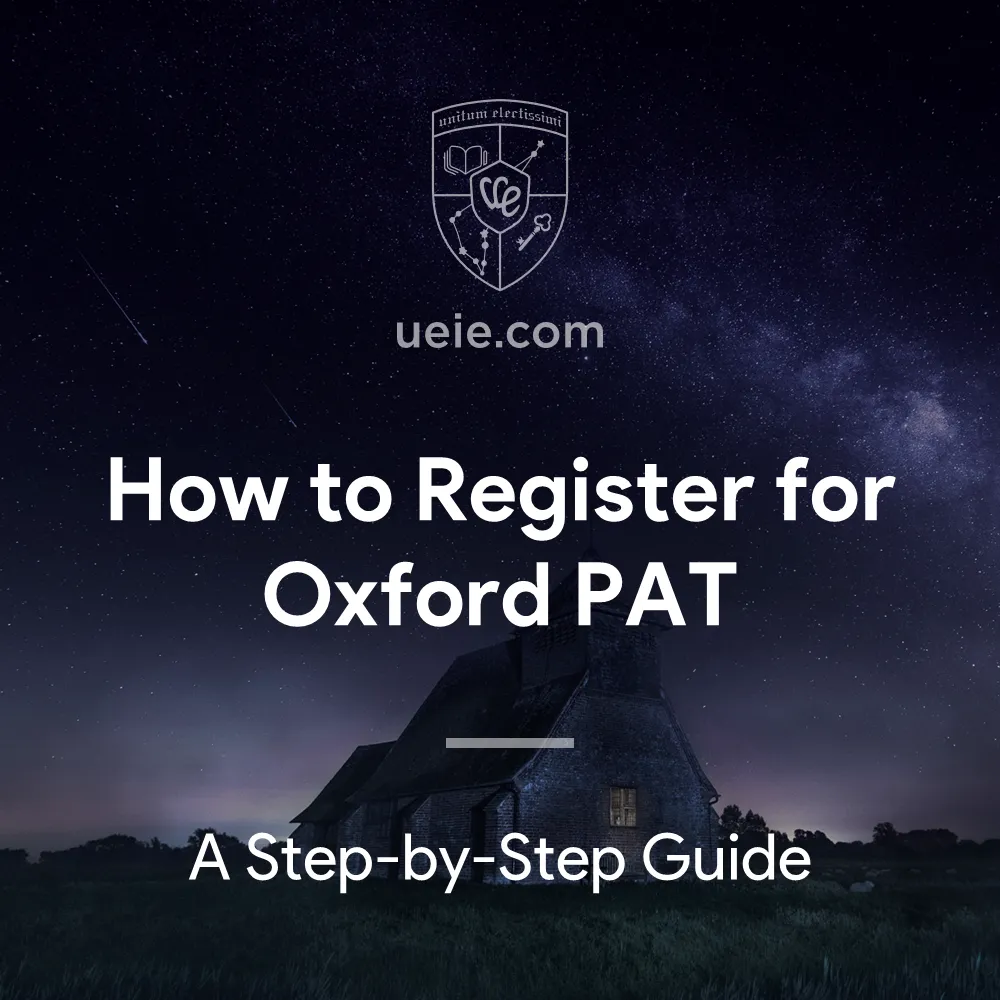
How to Register for Oxford PAT
Register for the Oxford PAT with our simple 4-step guide and get closer to achieving your Oxford dream!VIII. Core Preparation Strategies and Resource Recommendations
Effective preparation not only requires understanding the examination itself but also clarifying the preparation direction and making good use of high-quality resources.
1. Overview of Core Preparation Strategies
The core of PAT preparation lies in a solid foundation of physics and mathematics knowledge, strong problem-solving skills, and adapting to the pure multiple-choice online examination format. Preparation should focus on:
- Consolidating Foundation: Ensuring a deep understanding of all physics and mathematics concepts within the syllabus.
- Improving Application: Training the ability to apply foundational knowledge to complex and unfamiliar situations.
- Practice Strategies: Mastering the techniques for answering multiple-choice questions (including single and multiple-select) and time management.
- Familiarising with the Platform: Adapting to the online examination environment and the use of the online calculator.
For detailed preparation plans, phased training methods, targeted skill enhancement techniques, etc., please be sure to read my specially authored:

Ace the Oxford PAT: Mastering Maths, Physics & Online Test Skills
Aiming to ace the Oxford PAT test? This guide helps you master the essential Maths and Physics syllabus, develop crucial online test-taking skills (MCQ strategies, online calculator proficiency), and build a solid preparation plan for success in Physics or Engineering.2. Official Core Preparation Resources
The official website of the Oxford University Physics Department is the primary platform for obtaining the most authoritative PAT preparation information and materials. All candidates are strongly advised to make full use of the abundant resources it provides:
- Examination Syllabus: Clearly defines the scope of the examination (currently still the 2018 version).
- Past Papers: Provides a large number of past test papers. Note: Pre-2024 papers had different formats. They included written tests and non-multiple-choice questions. But their content and difficulty remain highly valuable. These help understand syllabus requirements and needed abilities.
- Official Online Sample Questions/Practice Tests: The official website or Pearson VUE provides sample questions or practice tests simulating the new online multiple-choice format. It is highly recommended to use these to familiarise yourself with the examination interface and online calculator.
- Annual Reports: Provide important information such as statistical data, average scores, and screening processes from previous years.
- ‘Preparing for the PAT’ Online Course: A free online preparation support programme provided by the Oxford Physics Department, including problem sets, videos, lectures, etc..
3. UEIE Oxford PAT Preparation Resources
I help candidates prepare for PAT systematically. My courses build on years of teaching research. I continuously update preparation materials. This year’s new self-study package includes:
- Oxford PAT Video Lecture Series: Includes in-depth explanation of exam points and accompanying PDF textbooks.
- Oxford PAT Practice Question Bank: Offers an extensive range of topic-based practice questions, designed to supplement the limited number of official past papers and strengthen problem-solving skills.
- Oxford PAT Full-Length Mock Exams: Four full-length simulation papers, featuring entirely original or adapted questions that do not reuse past paper content. These are ideal for refining your exam strategy and ensuring you are in peak condition before the test.
Click to learn more about UEIE PAT preparation resources:

ESAT & PAT On-Demand Prep Suite
The ESAT & PAT On-Demand Prep Suite, developed by Xie Tao, is your all-in-one solution for exam success, which includes video lectures covering Maths, Physics, over 1600 practice questions with detailed solutions, and full-length mock exams for ESAT Maths 1, Maths 2, Physics, and the Oxford PAT. Prepare thoroughly and maximise your score.US$612 – US$2 428Price range: US$612 through US$2 428
4. Other Supplementary Resources
Based on official Oxford recommendations and preparation needs, the following can be selectively used:
- Isaac Physics: Provides a large number of high-quality physics and mathematics problems.
- British Physics Olympiad (BPhO) Past Papers: The style of questions helps develop the ability to solve challenging problems.
- Other Online Platforms or Books: Such as resources compiled by Physics & Maths Tutor (PMT), some physics/mathematics thinking training books, etc..
5. Core Recommendations
It is crucial that official resources form the core of your preparation, especially past papers (bearing in mind the changes in format) and the online practice tests. Depending on your individual needs, carefully select high-quality supplementary materials (such as UEIE’s systematic preparation plans or other officially recommended websites) to support your systematic learning and targeted practice. Finally, ensure you utilise the official Pearson VUE online practice tests to familiarise yourself thoroughly with the computer-based testing environment and the online calculator.
IX. Suggested Next Steps
After reading this Oxford PAT Comprehensive Guide, you should have a clear grasp of the key information about this test. To translate this understanding into effective application preparation, we recommend that you take the following actions immediately:
1. Verify Official Requirements
Revisit the official University of Oxford admissions website (especially the pages for Physics, Engineering Science, Materials Science, and other relevant departments) to carefully confirm the latest and most accurate admission requirements for 2026 entry, including whether the PAT is still mandatory and the specific programmes it applies to.
2. Plan Your Exam Registration
Consult the detailed Oxford PAT Registration Guide to understand the registration process, deadlines, and required materials.
Remember the official start and end dates for registration and be sure to complete all registration and Pearson VUE test slot booking steps before these dates.
3. Develop a Preparation Plan
Read the Oxford PAT Preparation Guide and develop a systematic, personalised preparation timetable and learning strategy based on your own circumstances (physics and mathematics foundation and available time). Start preparing as early as possible; PAT preparation requires a comprehensive and in-depth improvement of physics and mathematics abilities.
4. Select and Utilise Resources
- Make good use of official core resources: Download and study the latest examination syllabus, past papers (noting format changes), online sample questions, and preparation course materials provided on the Oxford Physics Department official website.
- Selective supplementary: Based on your preparation plan, carefully select high-quality supplementary resources, such as UEIE’s PAT preparation lectures and materials, or other officially recommended practice platforms, for systematic learning and targeted training.
- Familiarise yourself with the platform: Be sure to use the official Pearson VUE online practice tests to familiarise yourself with the computer-based testing environment and online calculator.

Oxford PAT Prep Hub
Master the Oxford PAT with UEIE’s Prep Hub! We offer everything you need to succeed: in-depth video lecture series, extensive practice question bank, realistic full-length mock exams, expert guides, and insightful data analysis.Finally, please remember that thorough preparation and a positive mindset are key to facing the PAT challenge. We wish you a smooth preparation, a successful application, and ultimately, admission to your desired university!
-
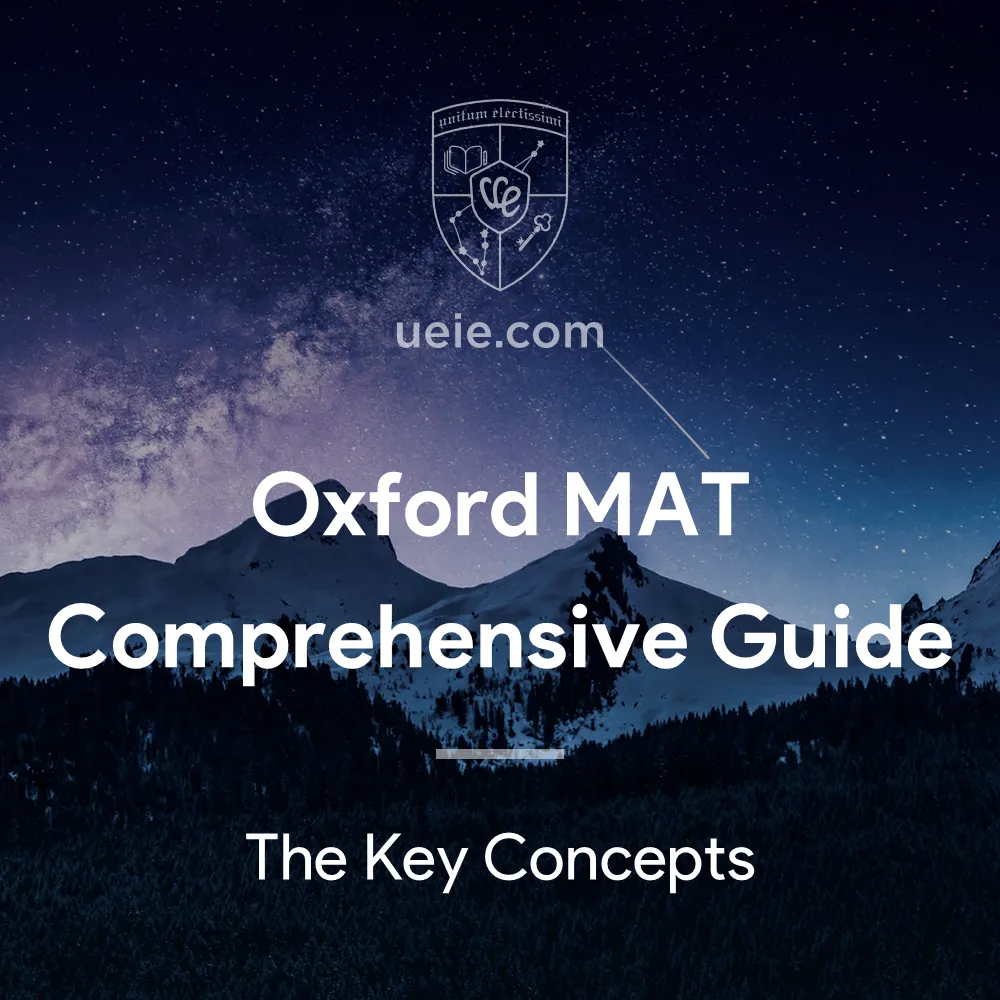
Oxford MAT Unpacked: Mastering the Test for Maths & CS Admissions

The Oxford MAT test (Mathematics Admissions Test) is an entrance examination used by the University of Oxford to assess the mathematical aptitude and potential of undergraduate applicants for Mathematics, Computer Science, and related degree programmes. It primarily evaluates a student’s mathematical thinking, logical reasoning, and problem-solving abilities.
To assist students planning to apply for 2026 entry in mastering the latest and most accurate MAT test information, this document (revised by Mr. Xie Tao) will systematically outline its key developments, requirements, format, scoring, syllabus, and preparation resources.
After understanding this overview of the MAT, it is recommended to continue reading the Oxford MAT Preparation Guide and the Oxford MAT Registration Guide for detailed preparation strategies and registration guidance.
I. Latest Oxford MAT Developments and Changes (2025 Examination Season)
The Oxford MAT test underwent a series of significant changes in 2024. Candidates must understand these core changes. The exam board has implemented them. They will continue through the 2025 exam season (for 2026 entry).
- Test Administrator: The University of Oxford continues to designate Pearson VUE as its global partner for administering admissions tests. The examination will still be conducted at Pearson VUE authorised test centres.
- Test Format: The Oxford MAT has transitioned entirely to an online, computer-based examination. The process no longer involves paper-based question papers or answer sheets.
- Paper Structure: The test has adopted a new, unified paper structure. All candidates applying for relevant degree programmes will sit the same paper, comprising 25 multiple-choice questions and 2 short-answer questions. Answers to the short-answer questions must be typed using a standard keyboard. The practice of having different combinations of questions for different degree programmes has been discontinued.
- Question Setters: It is important to note that, despite the changes in administration and format, the responsibility for setting the MAT questions remains with the Mathematical Institute at the University of Oxford, ensuring the continuity of its academic standard and style.
For students preparing for the 2025 Oxford MAT test, it is imperative to base their preparation and practice on the new model of an online, computer-based test featuring multiple-choice and short-answer questions.
II. Who Needs to Take the Oxford MAT Test? (2026 Entry Requirements)
Clarifying which universities and degree programmes require MAT scores is the first step in determining whether you need to sit this examination. According to the latest information, the MAT is currently primarily and mandatorily used by the University of Oxford for admission to its specific undergraduate programmes.
1. University of Oxford
For 2026 entry, candidates for the following undergraduate (or integrated Master’s) degree programmes at the University of Oxford must take the MAT test at the time of application, and there is no alternative test to the Oxford MAT:
Degree Programme UCAS Code Mathematics G100 Mathematics and Statistics GG13 Mathematics and Philosophy GV15 Mathematics and Computer Science GG14 Computer Science G400 Computer Science and Philosophy IV15 2. Other Universities
Imperial College London: Since the 2024/25 admissions cycle, the Department of Mathematics no longer requires applicants to take the MAT. Their specific requirements involve the TMUA, STEP, or other assessment methods. The Department of Computing, however, requires applicants to take the TMUA examination. Please consult the Imperial College London website for the most current information.
University of Warwick: Since the 2024/25 admissions cycle, the Mathematics and Statistics departments no longer accept MAT scores. Instead, they require applicants to provide TMUA scores, or, under specific conditions, accept STEP scores as an alternative. Please consult the University of Warwick website for their latest detailed requirements.
Conclusion: In the current admissions cycle (for 2026 entry), the MAT can essentially be considered a mandatory entrance examination exclusively for the aforementioned degree programmes at the University of Oxford. Students applying to related programmes at other universities should focus on the TMUA, STEP, or other entrance examinations specified by those institutions.
III. MAT Test Key Dates (2025-2026 Cycle)
Students planning to apply for 2026 entry should pay close attention to the following key dates related to the MAT examination. It is imperative to refer to the latest information published on the University of Oxford’s official website and plan accordingly in advance:
Event Date / Timeframe Notes / Reminders Registration Time 18 June to 19 September 2025 An account must be created via the Oxford website. Test Slot Registration 18 August to 26 September 2025 Ensure Pearson VUE test slot booking is completed by this date. Test Dates Wednesday, 22 October 2025 and Thursday, 23 October 2025 Select a specific test session via the Pearson VUE system. Interview Invites November to December 2025 Sent by email after Oxford University completes its shortlisting. Results Release January 2026 Released to candidates via the test registration platform (or email notification). Important Note: All dates (particularly the specific start and end times for registration) are subject to change. Please ensure you regularly visit the MAT page on the University of Oxford admissions website and the Pearson VUE Oxford admissions test page for the most authoritative official information.
IV. Oxford MAT Test Format and Structure
Since the reforms in 2024, the Oxford MAT has adopted a new online format and a unified structure, as detailed in the table below.
Item Details Test Mode Online Computer-based Test Test Location Global Pearson VUE authorised test centres Duration 150 minutes (2.5 hours) Structure Unified Paper - 25 Multiple Choice Questions
- 2 Short Answer Questions
Requirement All candidates must answer all 27 questions; short-answer questions require typed input using a standard keyboard. Calculator Not Permitted Formula Sheet Not Permitted Dictionary Not Permitted Key Points Explained
- Online, computer-based test: Candidates need to familiarise themselves with the online examination environment and interface.
- Unified paper: There is no longer a differentiation by degree programme; all candidates face the same challenge.
- Short-answer input: Practice in typing mathematical symbols and expressions using a keyboard is required.
- No auxiliary tools: This places high demands on mental arithmetic, written calculation skills, and the proficient recall of formulae.
V. Oxford MAT Scoring Mechanism and Interpretation of Results
Understanding how the MAT test is scored and what the scores signify can help candidates set targets and evaluate their performance more scientifically.
1. Scoring Method
The MAT test has a maximum score of 100 marks.
Question Weighting
- There are 25 multiple-choice questions, totalling 70 marks. The typical mark distribution is:
- Questions 1-10: 2 marks each (20 marks total)
- Questions 11-20: 3 marks each (30 marks total)
- Questions 21-25: 4 marks each (20 marks total)
- There are 2 short-answer questions, worth 15 marks each, totalling 30 marks. Partial marks are awarded for short-answer questions based on the correctness and clarity of the solution steps and the final answer.
Scoring Features
- No negative marking: Incorrect answers to multiple-choice questions do not result in a deduction of marks; therefore, candidates are encouraged to attempt all questions.
- Raw scoring: The scores for each question are directly summed to produce the final mark; there is no complex weighting or conversion.
2. Results Reporting
- Internal Use: Admissions tutors at the University of Oxford receive candidates’ MAT scores in November, which are used in conjunction with UCAS application materials for shortlisting for interviews.
- Candidate Enquiries: Candidates typically receive their final application outcome from the University of Oxford the following January (i.e., January 2026) before they can access their specific MAT score via the test registration platform.
3. Interpretation of Results
The set of charts below presents official data on MAT scores and the number of students admitted to related degree programmes since 2007. This includes the average scores for All Applicants, Shortlisted Applicants, and Successful Applicants, as well as the corresponding numbers of applicants, those shortlisted, and those who received offers.
As can be seen from the charts, the aforementioned three sets of Oxford MAT average scores vary each year. Furthermore, there is no definitive ‘admissions threshold’ or ‘cut-off score’ for the MAT examination – final admission decisions are based on a holistic assessment of the applicant’s overall profile, with the MAT score being merely one significant component. This point is also evident from the distribution charts of MAT scores and admission numbers published officially over the years, as illustrated below.
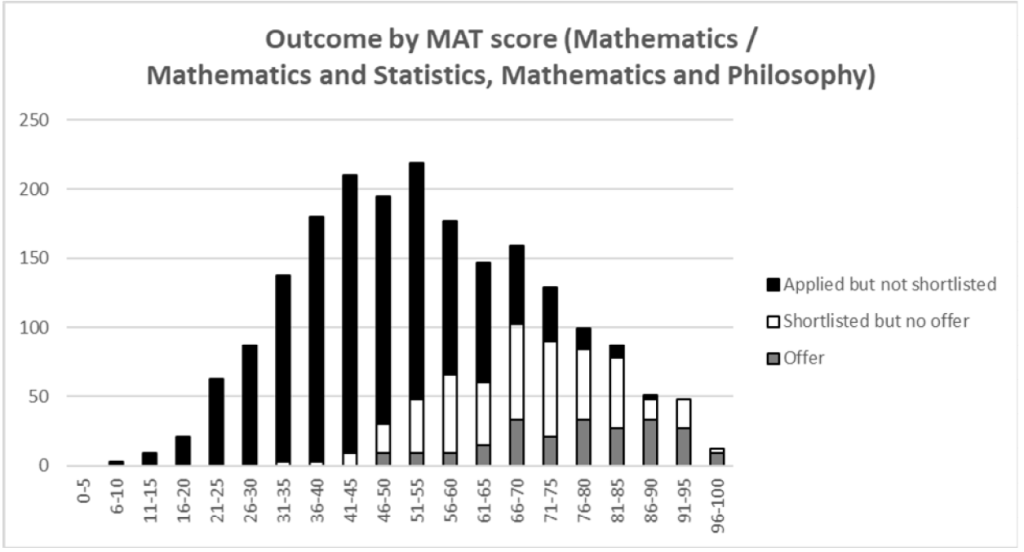
Distribution of MAT Scores for Each Range Published by the Oxford Mathematics Department in 2024
4. Competitiveness Analysis
Based on student cases I have tutored over the past decade and officially published MAT results, the higher the MAT score, the greater the chance of admission. Generally speaking:
- High-scoring range (85 marks and above): Students achieving this level of score usually possess strong overall qualities. Provided they perform consistently in the interview, their likelihood of receiving an offer is very high.
- Good chance of interview range (65 marks and above): Students who achieve an average score or slightly below average, provided their overall application is strong, are generally given an interview opportunity by Oxford. However, for students from mainland China, a higher score, perhaps 70 or even 75 and above, may be necessary to secure an equivalent chance of an interview.
- Average level and below (below 50 marks): It is generally more difficult to receive an interview invitation unless there are particularly outstanding aspects in the application materials or special circumstances such as regional or school-based policy considerations.
VI. Oxford MAT Test Syllabus and Difficulty Analysis
Accurately grasping the scope and difficulty characteristics of the Oxford MAT is fundamental to formulating an effective preparation plan.
1. Test Syllabus Scope
- Knowledge Base: The MAT syllabus is primarily based on the Pure Mathematics component of A-Level Mathematics (excluding A-Level Further Mathematics).
- Syllabus Stability: The MAT syllabus is relatively stable and is not revised annually. The current official version provided was published in 2018. Although the examination format changed in 2024, the scope of knowledge remains unchanged.
2. Syllabus Characteristics and ‘Beyond the Syllabus’ Content
- Concise yet In-depth: The official MAT syllabus is relatively concise, covering a narrower range of topics than the full A-Level Mathematics. However, this does not mean the examination is simple. The University of Oxford’s design philosophy aims to base the test on the common foundations of mathematics curricula across different countries to ensure fairness, but the questions will delve deeply into students’ understanding, application, and extension of fundamental concepts.
- Thinking over Knowledge: The core of the examination is to assess mathematical thinking potential, the rigour of logical reasoning, and the ability to solve non-standard problems, rather than merely testing the recall and reproduction of knowledge points.
- Common ‘Beyond the Syllabus’ Topics: Despite the limited syllabus scope, MAT questions frequently feature topics that are not typically covered in depth or at all in A-Level (or even Further Mathematics) courses, requiring candidates to use foundational knowledge for reasoning and problem-solving. These common themes include, but are not limited to:
- Elementary Number Theory
- Logic and Proof
- Recurrence Relations
- In-depth applications of Sequences and Series
- Basic Algorithmic Thinking
- Combinatorial Problems
3. Knowledge Point Distribution
The knowledge points tested in the MAT test are relatively evenly distributed, covering core areas of A-Level Mathematics such as Algebra, Functions, Coordinate Geometry, Trigonometry, Calculus, and Sequences and Series. It also incorporates logical reasoning and some ‘beyond the syllabus’ mathematical ideas. For a detailed breakdown of specific knowledge points, please refer to the official syllabus.
For a more in-depth research analysis of MAT test hotspots and difficulties, please refer to my previous article:
MAT Secrets: Expert Insights into Exam Difficulty and Patterns
4. Difficulty Characteristics and Analysis
- Higher than A-Level: The depth of thinking, flexibility, and demand for rigour in MAT questions are significantly higher than in standard A-Level examinations. It requires candidates to apply familiar knowledge in novel and unfamiliar contexts.
- Comparison with STEP Examination: The MAT does not demand as broad or as deep knowledge of Further Mathematics as STEP, and the question lengths are typically shorter. However, the MAT similarly emphasises rigorous logic and clear expression, and may include more ‘compact’ but ingeniously designed problems.
- Comparison with TMUA Examination: The TMUA places more emphasis on the rapid and accurate application of AS Mathematics knowledge and logical judgment under intense time pressure. The time pressure in the MAT is relatively less, but it focuses more on the depth of mathematical thinking, creativity, and insight into problem-solving.
- Recent Difficulty Trends: Judging by the average scores in recent years, the difficulty of the MAT has remained at a high level. The average score after the 2024 reforms saw a slight increase, but this may be related to the increased proportion of multiple-choice questions and does not necessarily indicate a decrease in the intellectual difficulty of the questions themselves. Achieving a high score (e.g., 75 marks or above) remains a significant challenge for most candidates.
For a more in-depth comparison of the Oxford MAT test with the STEP and TMUA examinations, you can refer to my article:

STEP vs TMUA vs MAT: A Strategic Comparison to Choose Your Maths Test
Confused about STEP, TMUA, and MAT for top UK universities? This strategic comparison breaks down the key differences: format (paper vs online), syllabus (FM required?), focus (proof vs speed vs logic), difficulty, and university requirements. Make an informed choice.VII. How to Register for the MAT Test?
Registering for the MAT test primarily involves creating an account on the University of Oxford’s official website and linking it to your application information, followed by booking a specific test centre and time slot via the Pearson VUE platform.
The specific registration steps, required information, test centre selection, fee information, applications for special arrangements, and detailed guidance for candidates in different regions are all very important and may involve numerous details.
To obtain the most complete and accurate step-by-step operational guidance, please be sure to consult our specially prepared detailed guide:
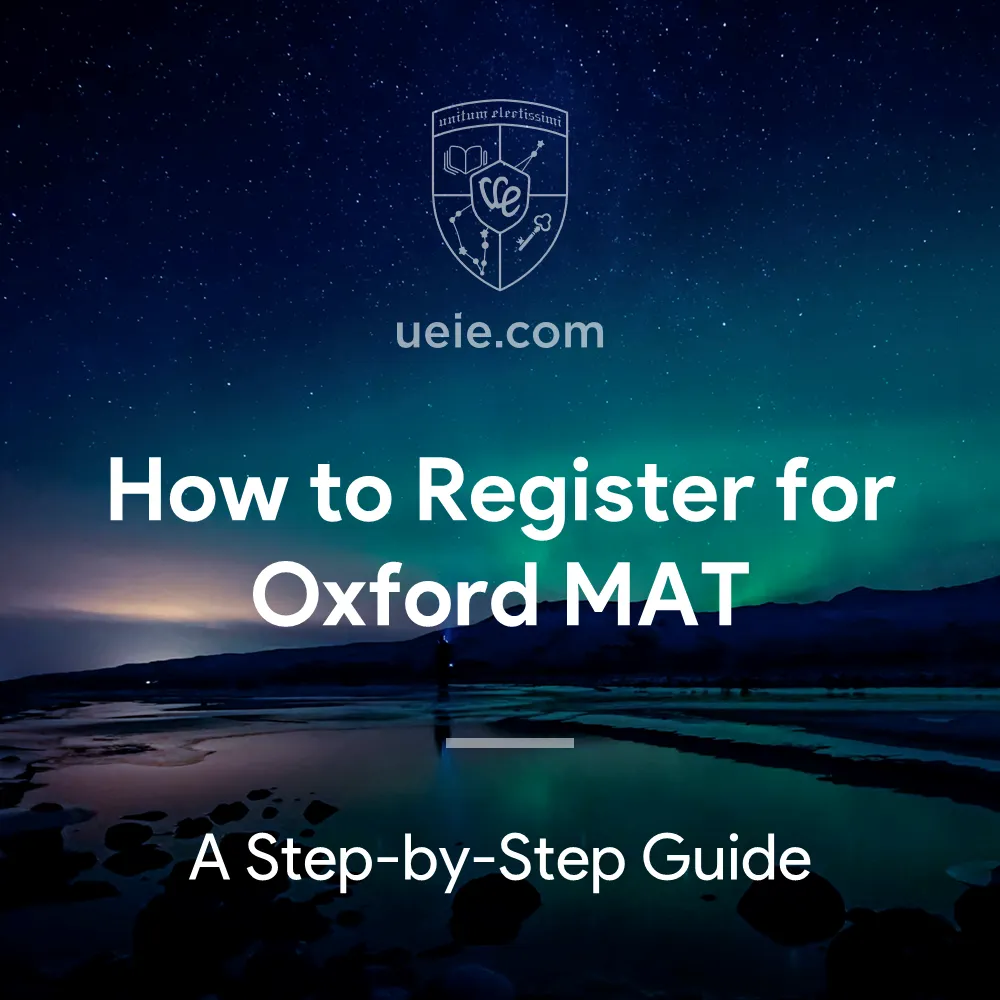
How to Register for Oxford MAT
The detailed guide on how to register for Oxford MAT. By four steps, you can increase your chances of a successful application to Oxford University.VIII. Oxford MAT Core Preparation Strategies and Resource Recommendations
Effective MAT preparation requires not only knowledge acquisition but also the right strategies and high-quality resources.
1. Overview of Core Preparation Strategies
The core of MAT preparation lies in enhancing the depth of mathematical thinking, the rigour of logical reasoning, and the ability to creatively solve problems. Unlike STEP, which focuses on the breadth and depth of knowledge, or TMUA, which emphasises speed and skill proficiency, the MAT places greater importance on a candidate’s mathematical insight demonstrated through foundational knowledge. Preparation should focus on:
- In-depth Understanding of Concepts: Do not be satisfied with superficial formulae; understand the meaning and connections between theorems and methods.
- Practising Problem-Solving Techniques: Develop the ability to apply knowledge in novel situations through high-quality questions (especially past papers).
- Cultivating Logical Thinking: Strengthen the habit of rigorous argumentation and clear expression of mathematical ideas.
For detailed strategies on how to create a preparation plan, learning methods for different stages, and targeted improvement of core abilities, please refer to my specially written:

Master the Oxford MAT: Strategies for Unique Problems & Online Format
Master the Oxford MAT test for Maths & CS admissions. This guide provides strategies for tackling its unique problem-solving style, strengthening logical reasoning (no calculator), adapting to the online format (MCQ & keyboarded short answers), and effective planning.2. Official Core Preparation Resources
The University of Oxford’s Mathematical Institute website is the primary platform for obtaining the most authoritative MAT preparation information and materials.
All candidates are strongly advised to make full use of:
- Past Papers: The most crucial practice material for familiarising oneself with question types and difficulty levels.
- MAT Practice Tests: Using past MAT papers can help candidates become familiar with the actual examination interface and answering methods.
- Examination Syllabus: Clearly defines the scope and requirements of the examination.
- Annual Feedback Reports: Provide statistical data and analysis from previous examinations, offering insights into score distributions and common issues.
- Preparation Advice and Videos: Official preparation guidance and possible recordings of online lectures/live streams.
3. UEIE Oxford MAT Preparation Resources
To help candidates prepare for the MAT more systematically and efficiently, I (Mr. Xie Tao), based on many years of teaching and research experience, have developed and continually update a series of MAT test preparation courses and materials. This year’s newly released MAT self-study package includes:
- Oxford MAT Video Lecture Series: Contains in-depth explanations of examination points and accompanying PDF textbooks.
- Oxford MAT Practice Question Bank: Provides a vast number of practice questions categorised by topic, supplementing the limited official past papers and strengthening problem-solving skills.
- Oxford MAT Full-Length Mock Exams: Four sets of full mock examination papers. All questions are original or adapted and do not use past paper questions, suitable for optimising test-taking strategies and condition before the examination.
Click here to learn more about UEIE MAT preparation resource details:

TMUA & MAT On-Demand Prep Suite
The TMUA & MAT On-Demand Prep Suite is your all-in-one solution for exam success. This comprehensive package combines Xie Tao’s expert video lectures, a massive bank of 1360 practice questions with detailed solutions, and 12 full-length mock exams that mirror the real test. Prepare thoroughly, build confidence, and achieve your target score.US$1 284 – US$1 856Price range: US$1 284 through US$1 856
4. Other Supplementary Resources
The following resources can also help improve the mathematical thinking and problem-solving skills required for the MAT, and can be used selectively according to individual circumstances:
- Underground Mathematics: Provides a wealth of thought-provoking higher mathematics problem resources.
- STEP Support Programme: Although primarily aimed at STEP, the problem-solving methods and thinking training it offers are also beneficial for the MAT.
- Dr Frost Maths MAT Resources: Offers some MAT-related practice resources (requires searching within the website).
- Relevant Books: Such as books focused on mathematical thinking training or advanced problem-solving.
5. Core Advice
Resources should be chosen for quality, not quantity. It is essential to focus on official past papers and materials as the core, and selectively and thoroughly utilise high-quality supplementary resources, such as the systematised preparation programme offered by UEIE, to address individual weaknesses.
IX. Next Steps and Recommendations
After reading this ‘Comprehensive Guide to the Oxford MAT,’ you should have a clear and comprehensive understanding of this important entrance examination. To translate this understanding into effective application preparation, it is recommended that you take the following actions immediately:
1. Verify Official Requirements
Immediately visit the official University of Oxford admissions website to carefully confirm the latest and most accurate admissions requirements for 2026 entry, particularly the specific regulations for your target degree programme (confirm if MAT is mandatory).
2. Plan Examination Registration
Carefully read the Oxford MAT Registration Guide to fully understand the registration process, required materials, timelines, and test centre selection. Keep in mind the officially announced registration opening and closing dates, and ensure you complete your Oxford account registration and Pearson VUE test slot booking within the specified timeframe.
3. Develop a Preparation Plan
Study the Oxford MAT Preparation Guide in depth to create a detailed and feasible preparation plan tailored to your own situation. Start your preparation as early as possible, especially if you need to significantly improve your depth of mathematical thinking and problem-solving abilities.
4. Select and Utilise Resources
- Focus on Official Materials: Download and study the latest MAT test syllabus, official past papers, solutions, and preparation advice provided on the University of Oxford website.
- Systematic Learning: Based on your preparation plan, selectively use high-quality supplementary resources, such as the MAT preparation courses and materials offered by UEIE, for systematic learning and targeted training.
- Familiarise Yourself with the Platform: Use the Pearson VUE practice tests provided officially to become familiar with the online examination environment.

Oxford MAT Prep Hub
Master the Oxford MAT with UEIE’s Prep Hub! We offer everything you need to succeed: in-depth video lecture series, extensive practice question bank, realistic full-length mock exams, expert guides, and insightful data analysis.Finally, please remember that thorough preparation and a positive mindset are key to tackling the Oxford MAT challenge. I wish you success in your preparation and application, and ultimately, admission to your desired university!